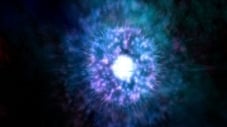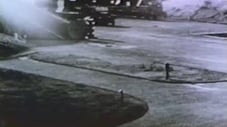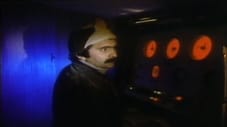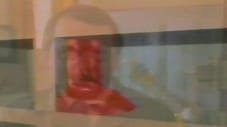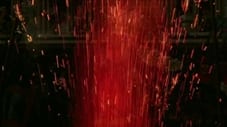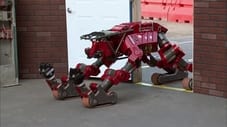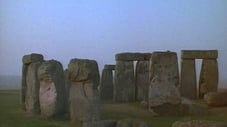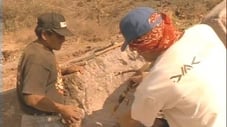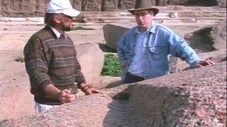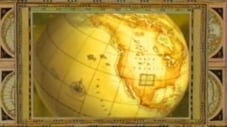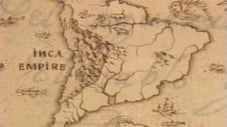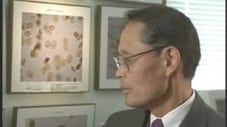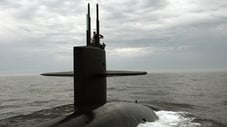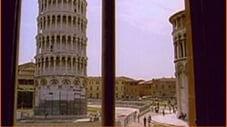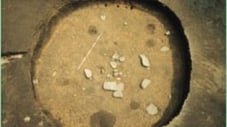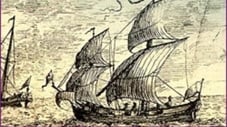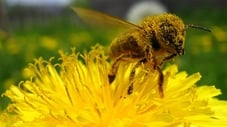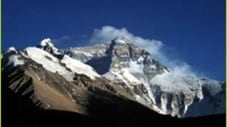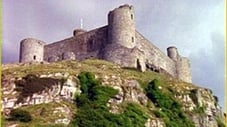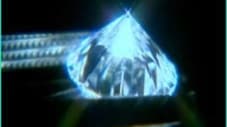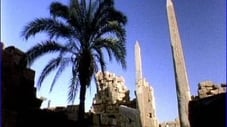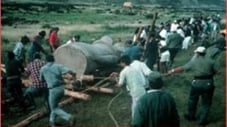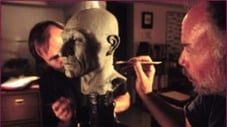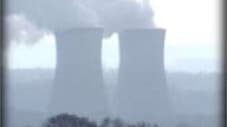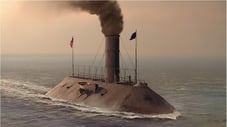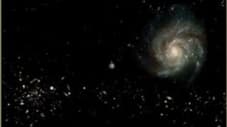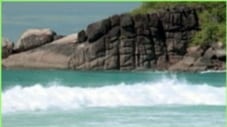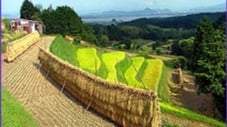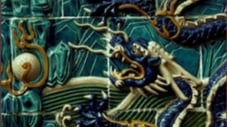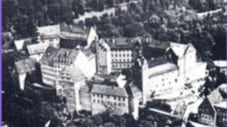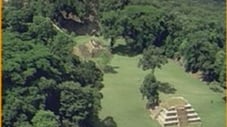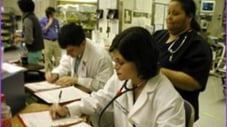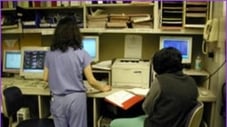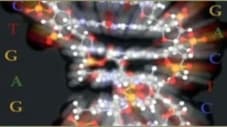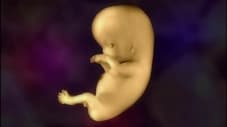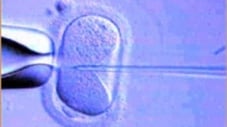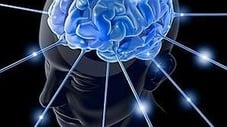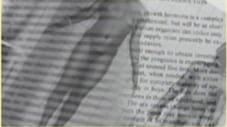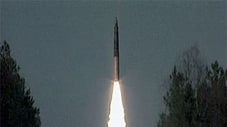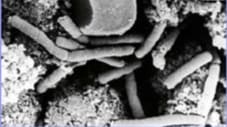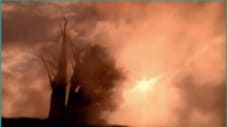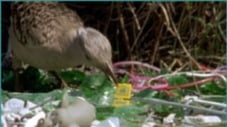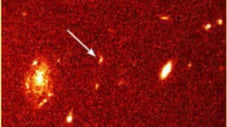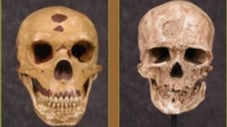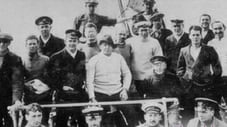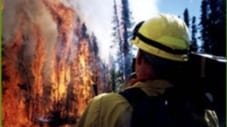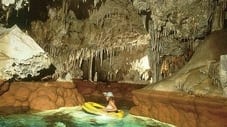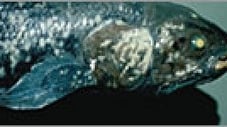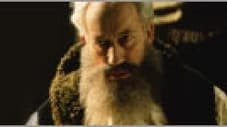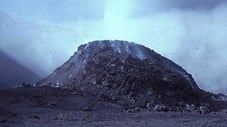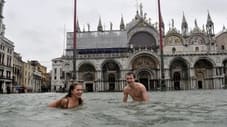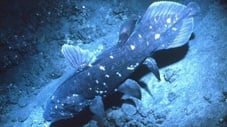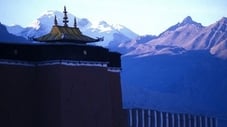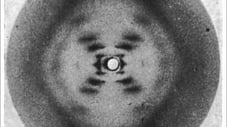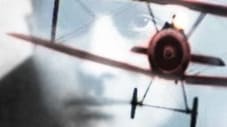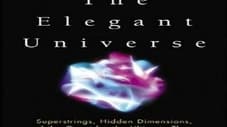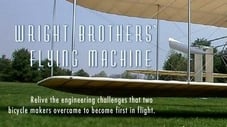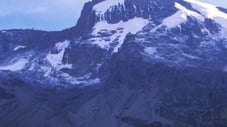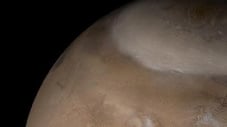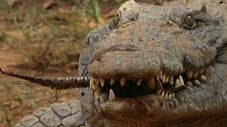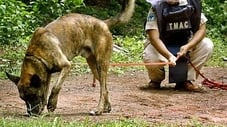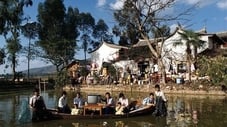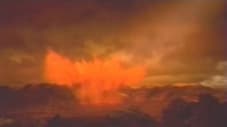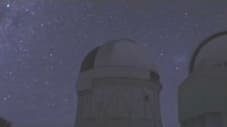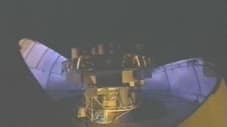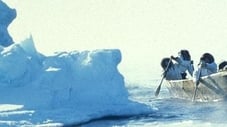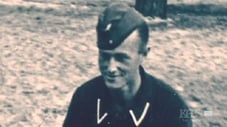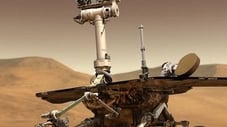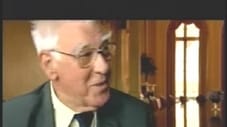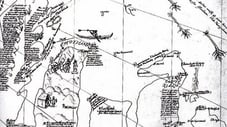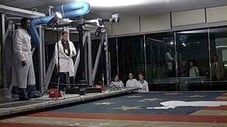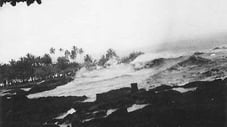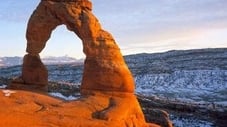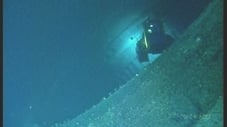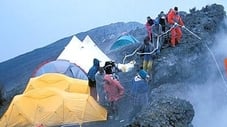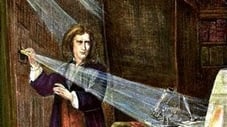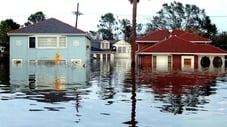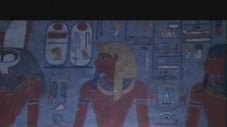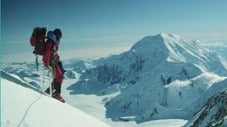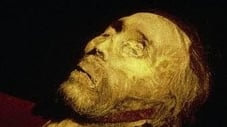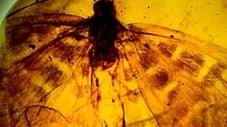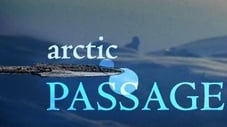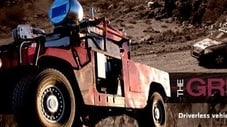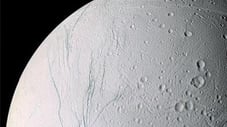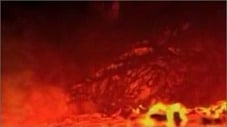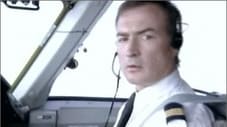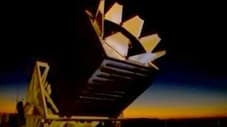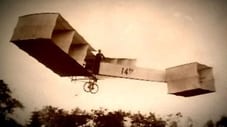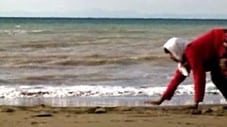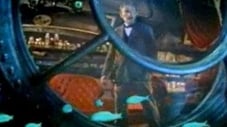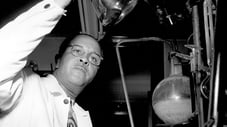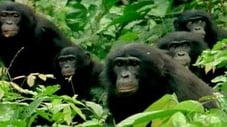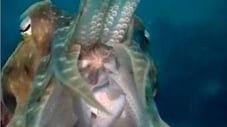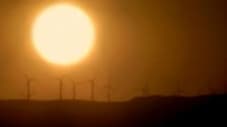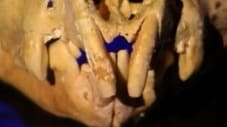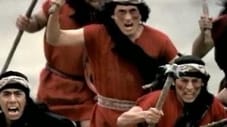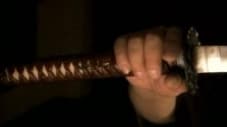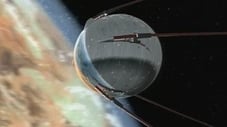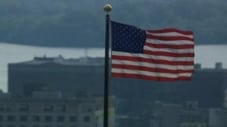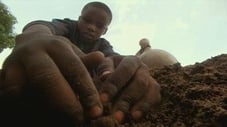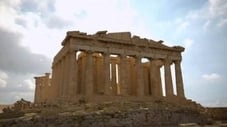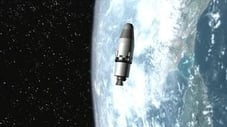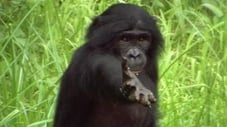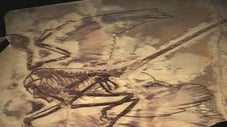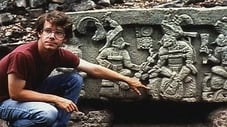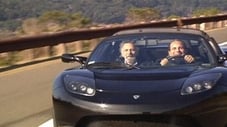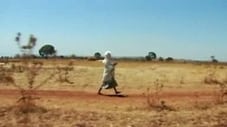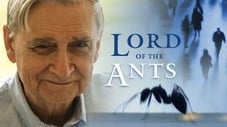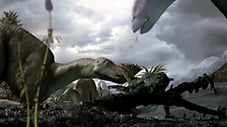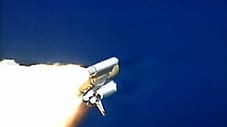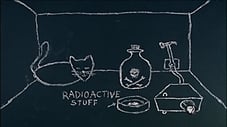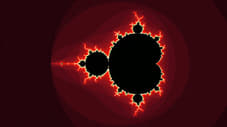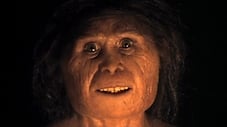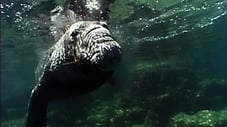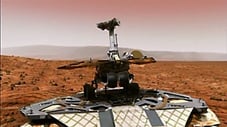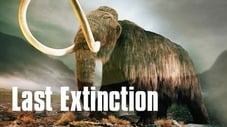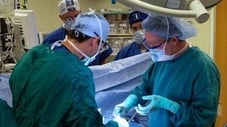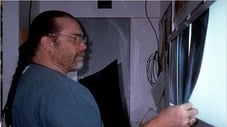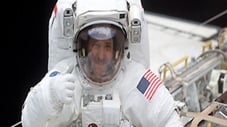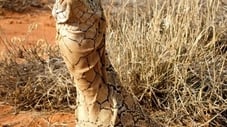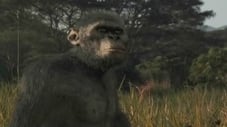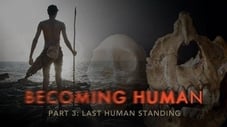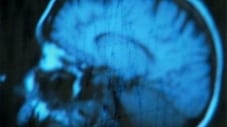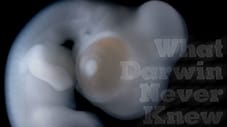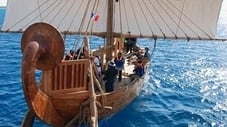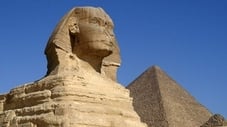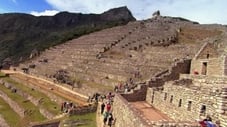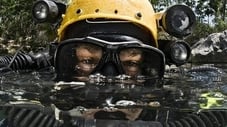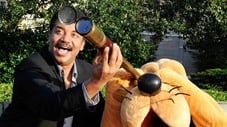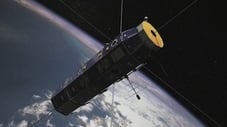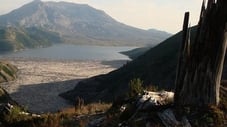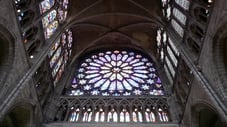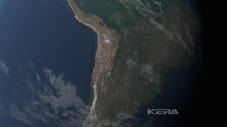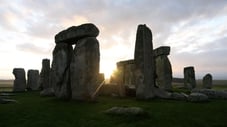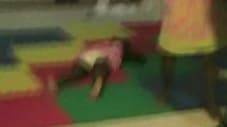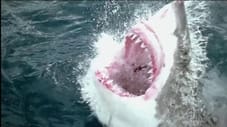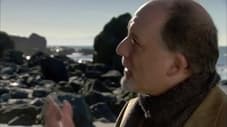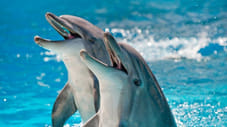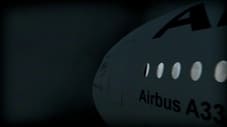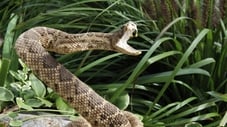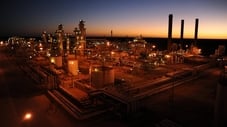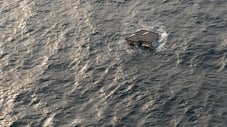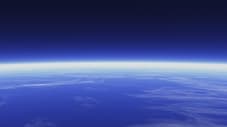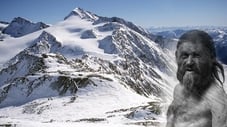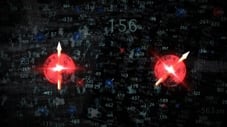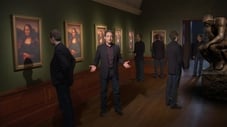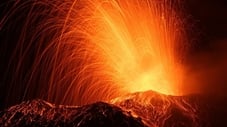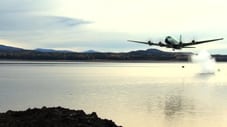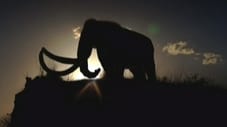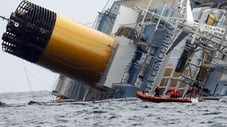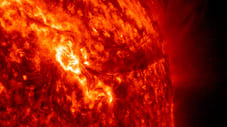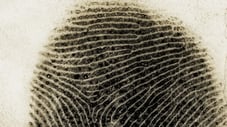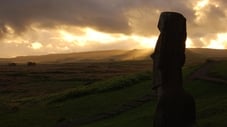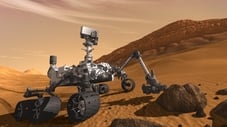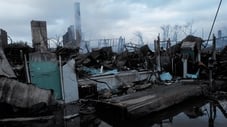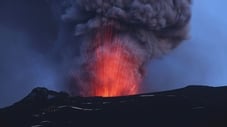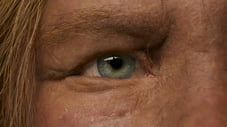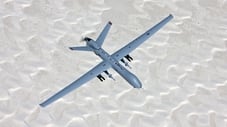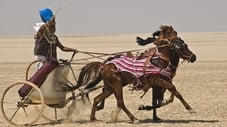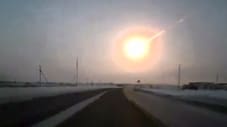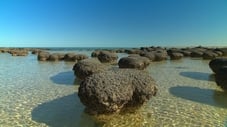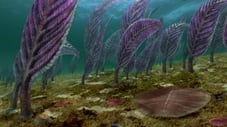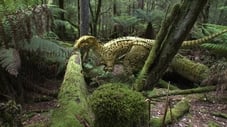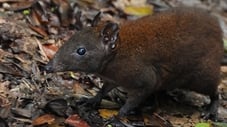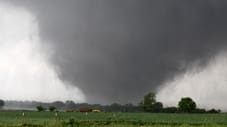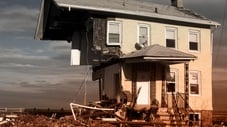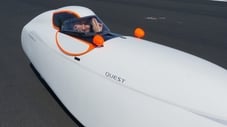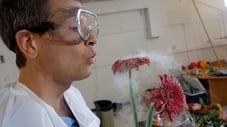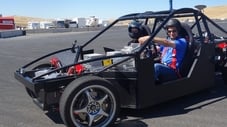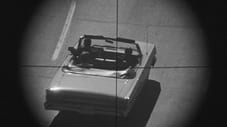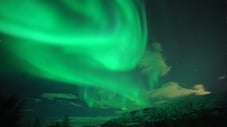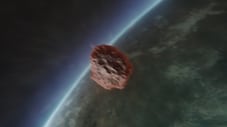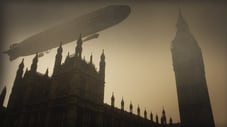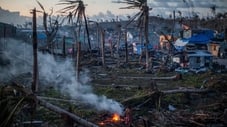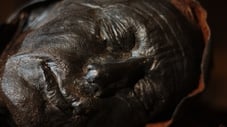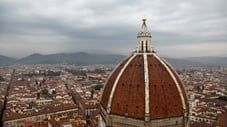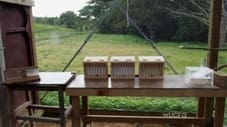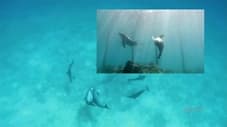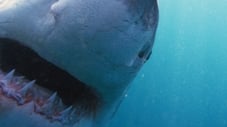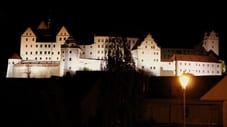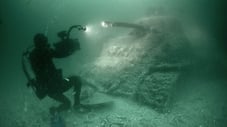
NOVA (1974)
← Back to main
Paula S. Apsell — Producer
Episodes 778
The Making Of A Natural History Film
NOVA premieres on public television with a behind-the-scenes look at the making of a nature film. Oxford Scientific Films Unit shows how it tackles such problems as filming a wood-wasp laying its egg inside trees, the hatching of a chick and the courtship rituals of the stickleback.
Read MoreWhere Did the Colorado Go?
NOVA explores the mighty Colorado River which today has become the life-blood of the Southwest, providing water and electricity to the farms and cities of California, Nevada, and Arizona. The program examines the political expediency and technological over-optimism that has led to some major miscalculations of the river's capacity.
Read MoreWhales, Dolphins, and Men
NOVA explores the impact of whaling and the goods it produces for the industry, verses the grace and beatury of this intelligent mammal of the sea.
Read MoreThe Search For Life
Does life exist outside this planet? The Viking lander will set down on Mars in July 1976 to try to find out just that. NOVA explores how life started on Earth and examines the Viking Lander being built in its germ-free room before starting its long journey.
Read MoreLast of the Cuiva
How does a primitive nomadic tribe of the Amazon basin cope with the encroachment of Western settlers? NOVA looks at both sides of the story, revealing the misunderstandings between the two cultures.
Read MoreStrange Sleep
Medicine was transformed in the 19th century by the discovery of anesthesia; surgery, until then hasty, bloody and completely unable to deal with internal disorders, subsequently took its place in the front rank of medical practice. This NOVA docudrama depicts the pioneers of medicine.
Read MoreThe Crab Nebula
In 1054 AD, the Chinese recorded the explosion of a star so bright that it lit the sky for three weeks, even during the day. It was the explosion of a dying star that was bigger than our sun. NOVA explores this mysterious explosion that led to the discovery of Crab Nebula.
Read MoreBird Brain: The Mystery of Bird Navigation
Birds migrate in search of perpetual summer, sometimes traveling as much as 20,000 miles every year. NOVA uses radar to track and identify migrating birds that travel at night, focusing on how they coose routes tat avoid bad weather and make the best of prevailing winds—information that can aid meteorologists.
Read MoreAre You Doing This for Me, Doctor?
The advance of medicine depends inevitably on the testing of experimental procedures on human volunteers from either the healthy or the sick. Yet such procedures are often dangerous, and may not be of direct benefit to the subject. NOVA examines how individuals' interests are safeguarded, and asks, under what circumstances experiments should be conducted on children.
Read MoreThe First Signs Of Washoe
Washoe is a chimp more like a person: she talks with her hands. NOVA visits with Washoe and her teachers—Professor Allen Gardner and Dr. Trixie Gardner—to learn more about this unusual animal.
Read MoreThe Case of the Midwife Toad
When Paul Kammerer committed suicide in 1926, it was taken by most of his fellow biologists as a tacit admission of guilt that he had faked his experiments purporting to show the inheritance of acquired characteristics. Arthur Koestler joins NOVA in an in-depth examination of Kammerer's infamous experiment.
Read MoreFusion: The Energy of Promise
Nuclear fusion offers the promises of an unlimited, clean source of energy. But achieving fusion has proved one of the most difficult and elusive goals of the physicist. NOVA tells the story of the twists and turns and the international competition along the road toward the achievement of fusion; and details the recent breakthroughs which seem at last to have brought it within reach.
Read MoreThe Mystery Of The Anasazi
Who were the people that built the first cities -- complete with apartment blocks -- in North America? They were the Anasazi Indians, who lived in the Southwest for some eight or nine thousand years and who then, in about 1300 AD, abruptly abandoned their cities and apparently disappeared. NOVA traces the steps of this ancient sophisticated culture.
Read MoreWhy Do Birds Sing?
NOVA travels to forests and marshes to discover why birds sing and finds surprising parallels with the acquisition of speech in humans.
Read MoreHow Much Do You Smell?
Many insects and some mammals use smell as a primary means of communication. NOVA explains how, for example, the entire economy of an ant's nest is organized by smell, and how some moths use smell for population control—an ability we is now beginning to understand.
Read MoreThe Hunting Of The Quark
Smashing matter into ever smaller pieces in an attempt to find its fundamental building blocks has produced a confused nightmare of particles. NOVA looks at this on-again, off-again story—one of sciences's most mysterious—and, one of the most expensive, involving some of the biggest machines in the world.
Read MoreThe Secrets Of Sleep
Most of us spend one-third of our lives in a state of which we understand remarkably little—some people sleep for only a few minutes a night, and function perfectly well, while others declare that eight hours isn't enough. NOVA explores traditional notions about how much sleep we need; looks at effects of the sleeping pill, and, perhaps the most baffling of all aspects of sleep—dreaming.
Read MoreInside the Golden Gate
NOVA joins a team of U.S. Geological Survey scientists on a mission to find out just how San Francisco Bay works: its physics, its chemistry and its biology.
Read MoreThe Men Who Painted Caves
Just why did Cro-Magnon man living in France's Dordogne Valley some 15,000 years ago take time out from the desperate business of survival to paint pictures in inaccessible corners of his cave dwellings? NOVA joins French and American archeologists as they piece together the lifestyle of these hunters of the last great Ice Age, and try to interpret the meaning of their cave art.
Read MoreRed Sea Coral
NOVA joins a group of English biologists living literally on a platform in the middle of the Red Sea, who for several years have been studying the crown-of-thorns starfish, notorious for the devastation it has wrought on the coral reefs of Australia and the Pacific.
Read MoreWar From the Air
We don't have an overview translated in English. Help us expand our database by adding one.
What Time is Your Body?
Have you ever sensed that your body reacts differently at different times of the day? NOVA examines the best and worsetimes for work, good times for sex drives and your body's most reactive time of day for alcohol consumption.
Read MoreThe Rise And Fall Of DDT
Has the case against DDT been proven? A strange question, perhaps, to be asking one year after the US has banned the insecticide, but NOVA dares to ask. Tracing the history of DDT from its discovery through its banning in the States, NOVA asks whether America overreacted with its total ban of this once acclaimed "wonder" chemical.
Read MoreTake the World From Another Point of View
NOVA profiles two very different scientists: Richard Feynman, a theoretical physicist, at the pinnacle of his career—a Nobel prizewinner; and Richard Lewontin, a biologist and highly regarded population geneticist from Harvard University.
Read MoreThe Lysenko Affair
NOVA explores T.D. Lynsenko's rise to power in the Soviet Union in the early 20th century, and how it affected plant genetic research in the USSR.
Read MoreThe Tuaregs
High in the Hoggar Mountains, in the exact center of the Sahara desert, lives Sidi Mohammed and his family: children, grandchildren, cousins and a few former slave women. Their environment, one of the most ungenerous on earth, provides them with almost nothing. NOVA examines the changing lifestyle of Sidi Mohammed.
Read MoreThe Plutonium Connection
How likely is it that a terrorist group will steal plutonium intended for nuclear reactor fuel and put together a blackmail weapon of unprecedented power in the shape of a homemade atom bomb? That question is posed by Theodore Taylor, former A and H bomb designer at Los Alamos, in a recent book, The Curve of Binding Energy. NOVA investigates just how easy it would be to design a bomb using unclassified information.
Read MoreThe Other Way
Since the Industrial Revolution, bigger has been better. NOVA profiles E.F. Schumacher, the author of Small is Beautiful, who thinks that enough is enough; that the time has come for technology to return to a human scale, where the ability to create is returned from the machine to people.
Read MoreThe Lost World Of The Maya
For over a thousand years the Mayan civilization grew and flourished in the rain forests of Central America. Discovered and finally destroyed by the Spanish Conquistadors, it was lost again until explorers brought it to light in the 19th century. Eric Thompson, an archaeologist who has had a 45 year love affair with the Maya, takes NOVA on a pilgrimage through the Mayan world, visiting, on the way, all the great ruined cities he has known for half a century.
Read MoreWill The Fishing Have to Stop?
Fish is an excellent source of protein; it could help ease the growing international food shortage. But in 1972 the total world fish catch dropped. NOVA explores the possible reasons for this decline.
Read MorePredictable Disaster
It is now possible to predict earthquakes. At least two successful predictions have already been made in the United States; and the NOVA crew was present and filming while a third prediction was being formulated. NOVA looks at why earthquakes occur, how predictions are made, the threat they pose to cities at risk, and examines the advantages and disadvantages of making an earthquake a predictable disaster.
Read MoreJoey
NOVA takes viewers into the world of Joey Deacon, 54 years old and a spastic since birth. Joey has lived most of his life in institutions, unable to communicate with anyone until he met Ernie Roberts. The docudrama recreates Joey's story, with remarkable performances by two spastic actors portraying him as a boy and as a young man. Joey and Ernie themselves appear in the final sequences.
Read MoreMeditation and the Mind
What do singer Peggy Lee, New York Jets Quarterback Joe Namath and Congressman Richard Nolas have in common? They all practice a ritual called TM—Transcendental Meditation. NOVA examines the recent phenomenal success of the TM movement in America.
Read MoreThe Planets
The last fourteen years have been a revolution in our understanding of our place in the stars, the Solar System. Beginning in 1961 with a Russian spacecraft flying to Venus, quickening with the Apollo manned missions to the Moon, it came of age in the Spring of 1974, when there were six spacecrafts traveling simultaneously from the Earth to the planets. NOVA looks at the era of manned and unmanned exploration of the Solar System.
Read MoreA Desert Place
NOVA explores the mysterious ecosystem of the desert: a snowstorm; a lashing summer monsoon; and the emergence—in a pool created only minutes before—of a pair of adult spadefoot toads. Toads who had been waiting beneath the sand for a year for this brief and fortuitous moment to procreate the next generation...
Read MoreA Small Imperfection
Every year, some 5,000 babies are born in the US with spina bifida, a congenital abnormality of the central nervous system. NOVA explores the mystery of what causes spina bifida and raises the issues of whether heroic measures should be taken to preserve the life of severely malformed babies.
Read MoreNinety Degrees Below
There's one place on earth where no one will ever catch a cold. And the freezing waters are so bitter there that a fish has been discovered to have developed its own anti-freeze. NOVA explores Antarctica—the coldest desert in the world.
Read MoreThe Race for the Double Helix
Author Isaac Asimov joins NOVA in the retelling of the remarkable story of the discovery of the structure of DNA. James Watson and his ex-colleague Francis Crick exchange memories of the events which led to their winning the race for the structure of the gene.
Read MoreThe Renewable Tree
Each Sunday edition of the New York Times consumes 153 acres of trees. The paper packs, napkins, paper cups and packing used by McDonald's gobble up 315 square miles of trees every day. NOVA asks if, at this rate, trees can remain a renewable resource.
Read MoreThe Williamsburgh File
NOVA joins chief archaeologist, Ivor Noel Hume, of Colonial Williamsburg, VA, for a fascinating glimpse of the lifestyles of the founders of this country, complete with detailed reconstructions of houses, stores, workshops, gardens, taverns and palaces.
Read MoreThe Overworked Miracle
Today we take antibiotics for granted, and by doing so are steadily eroding their medical value. NOVA examines the problem of resistance to antibiotics in the bacteria they are designed to kill.
Read MoreThe Transplant Experiment
Dr. Norman Shumway of Stanford University has performed more heart transplants than any other heart surgeon. NOVA explores those extraordinary days in 1968-69 when it appeared that everyone with a scalpel was doing heart transplants, and survival of patients was measured in days.
Read MoreThe Underground Movement
NOVA explores life underground, from foxes and badgers through moles and worms down to the myriad of micro-organisms that make soil the most complex substrate for life on earth. Included in the film is extraordinary footage of a mole burrowing and of roots growing.
Read MoreHunters of the Seal
NOVA shows the Netsilik eskimoes of Pelly Bay and their traditional way of life and what happens when Western civilization is imposed upon them.
Read MoreThe Women Rebel
Margaret Sanger was responsible almost single-handedly for changing the whole attitude of the male-dominated medical profession towards "women's issues" and, above all, for gaining social and political acceptance for the concept of birth control. This NOVA docudrama reconstructs her life, told as flashbacks interspersed throughout an interview. Piper Laurie stars as Margaret Sanger.
Read MoreDeath of a Disease
As late as 1967, smallpox struck as many as 15 million people in 43 countries and killed an estimated two or three million. Experts now believe that the disease is on the verge of extinction. NOVA looks at the recent success of the World Health Organization's program to eradicate this disease, considered a triumph of western-styled medicine.
Read MoreInside the Shark
The "Jaws" phenomenon has given sharks a bad name. But is the shark really such a barbarian? NOVA looks at the lifestyle of this remarkable survivor from the days when dinosaurs ruled the earth.
Read MoreThe Genetic Chance
Recent scientific developments have made it possible to detect a wide variety of defects in unborn babies. NOVA focuses on the ethical question that must be considered: What defines a defect? Should defective babies be aborted, or should they be allowed to live?
Read MoreThe Case of the Bermuda Triangle
Since 1945, hundreds of ships and planes and thousands of people have mysteriously disappeared in an area of the Atlantic Ocean off of Florida, known as the Bermuda Triangle. NOVA penetrates the mystery of the terrifying Bermuda Triangle.
Read MoreHitler's Secret Weapon
NOVA traces the development of Hitler's V-2 rocket through rare footage obtained from the National Archives—some never broadcast before on television.
Read MoreThe Hot Blooded Dinosaurs
If you were a dinosaur scientist, what would you do with a pile of fossil bones? How would you even start to put the giant jigsaw puzzle together, never mind discover anything about how these dinosaurs lived? NOVA explores the incredible world of the dinosaur scientist.
Read MoreWhat Price Coal?
What is the price we are prepared to pay for coal? NOVA looks at the environmental and health safety issues raised by the government, industry, and the victims.
Read MoreThe Sunspot Mystery
NOVA explores the research on the 1976 drought in the western United States which led some solar scientists to discover the link between weather patterns and the 11 year sunspot mystery.
Read MoreThe Plastic Prison
NOVA follows the lives of three boys who have combined immuned deficiency—a disease that leaves its victims with no immune system.
Read MoreIncident at Brown's Ferry
NOVA recreates March 1975 at Brown's Ferry, an Alabama nuclear power plant—the largest in the world—that suffered a seven-hour fire which came very close to developing into a major public disaster.
Read MoreBye Bye Blackbird
NOVA looks at blackbirds, their winter habit of nesting in the millions, and the destruction they do to crops.
Read MoreThe Pill for the People
NOVA profiles chemist Russell Marker who made the birth control pill possible by discovering a synthetic substitute for the hormone progesterone.
Read MoreThe Gene Engineers
NOVA explores the history of genetic engineering and the possible risks and benefits of this area of research
Read MoreThe Human Animal
NOVA investigates the controversial theory of Harvard University biologist E.O. Wilson, that many aspects of human behavior are genetically determined.
Read MoreThe Wolf Equation
In the winter of 1976-77, 80 percent of the wolf population in Northwest Alaska was the target of aerial hunts. Although the area is roamed by the Western Arctic caribou herds—a natural predator of the wolf—the caribou population has been steadily decreasing in number. NOVA examines how the Dept. of Fish and Game is handling the the problem of wolf control.
Read MoreThe Dawn of the Solar Age
Solar energy is increasingly popular as a home heating source. But only recently has it been seriously considered as a source of industrial power. NOVA looks at this new industrial approach, such as the use of a huge windmill in Ohio, giant machines that may generate electricity from the heat of the tropical seas or from the motion of waves, and an orbiting solar power station able to beam microwaves to earth.
Read MoreThe Business of Extinction
NOVA explores the huge international illegal trade in animals, penetrates the thriving underworld of smugglers and assesses the effects on vanishing wildlife.
Read MoreThe Red Planet
NOVA traces 300 years of speculation, investigation and discovery that have centered on Mars—particularly the theory that the planet could support life. Questions raised by NASA's 1976 Viking mariner missions about how the vast canyons were formed are also explored.
Read MoreTongues of Men (1)
In part one of this two-part exploration of the diversity of world languages, NOVA examines how and why the bewildering confusion of languages came about.
Read MoreTongues of Men (2)
In part two of this two-part series on the diversity of language, NOVA explores how man has coped with the confusion of language and asks if the growing acceptance of English is the answer.
Read MoreLinus Pauling: Crusading Scientist
NOVA profiles Linus Pauling—the only person to have received two unshared Nobel Prizes for his work in nuclear weapons.
Read MoreAcross the Silent Barrier
NOVA explores the different means by which hearing-impaired people have learned to penetrate the world of the hearing by visiting with Kitty O'Neil—a woman record-holding speed car racer; Frances Parsons, an advocate of hearing-impaired persons' rights; and workers at Silent Industries—a factory in Los Angeles founded by a deaf man.
Read MoreThe New Healers
NOVA explores the delibitating diseases that are often caused by poverty and follows two paths to health care in Tanzania and the United States.
Read MoreIn The Event of Catastrophe
Can a nuclear war be survived? Some members of the defense community say yes. NOVA explores the possibility.
Read MoreThe Green Machine
Botany is a neglected science and plants are all around us, but unfamiliar. NOVA examines our state of knowledge of how plants work: growth hormones, responses to light and shade, photosynthesis, root mechanisms and twining responses.
Read MoreBlueprints in the Bloodstream
It has been known since the turn of the century that there are four human blood groups, based on different red cells and serum characteristics. NOVA looks at the more recent discovery that the different white cell types, as determined by a variety of different molecular markers on the cell surface, open up the possibility of the prevention of disease.
Read MoreOne Small Step
Part one of a two-part series on the subject of man in space, NOVA examines the history of NASA—from the origin of the space race through the triumph of the Apollo programs. By tracing the history of three key programs—Mercury, Gemini, Apollo—we show how the basic challenges surrounding space flight were answered: rendezvous and docking, life support, weightlessness, space sickness, equipment reliability and so on.
Read MoreThe Final Frontier
Second of the two-part series on space programs, NOVA looks ahead to the future, post-Apollo and the role that man in space will play, including the possibility of space colonization—huge orbiting space stations where people live and work in an earth atmosphere under artificial gravity.
Read MoreBaMiki BaNdula: Children of the Forest
In the rain forests of Zaire, in the heart of Africa, live the Mbuti Pygmies. The Pygmy way of life has always been extraordinarily difficult to capture on film, though many have tried. NOVA presents a rare portrait of an elusive people, made by an independent filmmaker who lived with the Pygmies and won their trust.
Read MoreTrial of Denton Cooley
In a dramatic docudrama, NOVA reconstructs the controversial lawsuit raised against renowned heart surgeon Dr. Denton Cooley when one of his patients died after heart surgery, and examines the legal and moral issues this raises in the practice of modern medicine.
Read MoreThe Great Wine Revolution
A science-based revolution in the making of wine is underway. NOVA traces the secrets of the aging process and science's involvement with the predicting of mass production high-quality vintage wines.
Read MoreThe Case of the Ancient Astronauts
NOVA investigates the theories of von Daniken and others that the Earth has been visited by intelligent beings from outer space. Among claims examined are: that the building techniques used in the Great Pyramid of Cheops are so advanced that only an extraterrestrial intelligence could have built it; and that the engraved stones of Palenque in Mexico depict an ancient astronaut at the controls of a space rocket.
Read MoreThe Mind Machines
Today's scientists may be creating their own successors. Work being done in Artificial Intelligence (AI), a branch of computer science, only suggest that in the not too distant future, machines will outpace their creators. NOVA examines the possibility.
Read MoreIcarus' Children
In the summer of 1977 Paul MacCready, a California scientist and businessman, won the coveted Kremer Prize. His achievement was to design and build an airplane which completed, unaided, a one-mile figure-eight course entirely under the power provided by the pilot himself. This is the story of those many failures and MacCready's success.
Read MoreStill Waters
NOVA shows a year in the life of a beaver pond and includes almost every life form that exists in, on, under, around and above the water, from the microscopic plant life of summer to the eagles feeding on carcasses of deer that collapsed on the winter ice.
Read MoreBattle for the Acropolis
The fortified plateau above Athens known as the Acropolis is the site of some of the most remarkable architecture in the world: its marble structures built in the fifth century BC, including the renowned Parthenon, represent the artistic peak of classical Greek architecture. NOVA examines how the heavily polluted air of Athens produces acid rain which is dissolving the marble sculptures and columns; and how iron tiles used extensively in repair 40 years ago are now rusting, expanding and shattering the stone structures.
Read MoreThe Road to Happiness. : The Life and Times of Henry Ford
Henry Ford, a great friend of Edison, was a film enthusiast who amassed some one and a half million feet of film during his lifetime. Deposited in the National Archives and known as the Ford Film Collection, it covers not only the Ford family and Ford Motor Company but also contains newsreels, and general films produced under Ford. Using the Collection, NOVA profiles Ford's life and times.
Read MoreLaser : Light of the 21st Century
When first invented 18 years ago, lasers were called "a solution looking for a problem;" nobody could think what to do with them. But in fact research scientists immediately began to exploit their pure colors and near-perfect focusing ability. Today lasers have grown into a billion-dollar business. They are used in construction, manufacturing, clothing, dentistry and medicine. And the future uses of lasers are likely to be of major significance as the means of achieving nuclear fusion and as a very high efficiency communications medium.
Read MoreInsect Alternative
In a world that each year loses up to 40 percent of its crops to insects, some form of pest control is desperately needed. But chemical pesticides have backfired. Pesticide-resistant insects frequently develop, and previously harmless insects have become devastating infestations. Farmers have found themselves trapped on a "pesticide treadmill"—the more they spray, the more they have to spray. NOVA examines several alternatives for pest control.
Read MoreThe Desert's Edge
For thousands of years people have managed to live in deserts all over the world. But in recent years, a growing population and the demands of the international market have put more stress on these poor and easily exhausted lands. NOVA examines the consequences and possible solutions to desertification.
Read MoreThe Tsetse Trap
NOVA explores Bovine sleeping sickness. Spread by a fly, it is a deadly disease that poses a threat to Africa's cattle.
Read MoreMemories From Eden
Traditionally zoos were designed neither for people nor animals; barred cages taught people more about their separation from nature than about an animal and its habitat. But just as man has realized that he has all but destroyed much of the world's wilderness and its wildlife, he is realizing that the zoo may be the last refuge for wildlife. NOVA visits several United States zoos to examine a variety of activities of concern today: breeding, public education, creative new animal habitats, and the reintroduction of animals to their natural environment.
Read MoreA Whisper from Space
In 1965, Arno Penzias and Robert Wilson, two radio astronomers at Bell Telephone Laboratories, discovered faint, but ever-present, microwave signals from space—the most ancient and most distant signals detected by man: the oldest "fossils" in the universe. NOVA explores the current surge of cosmological discovery that continues to aid scientists in the "cosmic archaeology" of digging into the history of the universe.
Read MoreAlaska: The Closing Frontier
Congress is currently considering a proposal that would double the size of America's national park system by designating a sizeable chunk of Alaska as off-limits to developers. NOVA explores the public debates on Alaska, such as the construction of the oil pipeline—a proposal that has sparked a bitter controversy between conservationists and developers.
Read MoreBlack Tide
On the morning of March 16, 1978, the US owned, Liberian registered supertanker, the Amoco Cadiz, went aground off the coast of Brittany. Over the following days and weeks its entire 68 million gallons of oil drained into the sea. A NOVA production team began filmming at the scene shortly after the disaster, the biggest oil spill in history, and recorded clean-up efforts, effects of the spill on the crucial tourism and fishing industries, and the attempts of US and French marine biologists to trace the passage of the oil through the environment.
Read MoreLong Walk Of Fred Young
As a child, Fred Young hunted birds and wild animals with primitive weapons, spoke only the Indian languages Ute and Navajo, went to a medicine man when he was sick, and slept under the stars. NOVA profiles Dr. Frederick Young, now a nuclear physicist working on the laser fusion project at the Los Alamos Scientific Laboratory in New Mexico.
Read MoreA World Of Difference
In 1945, B.F. Skinner shocked the world by putting his 13 month-old daughter, Deborah, into a "box." The box was actually a climate-controlled crib designed for comfort and protection, and the young psychologist was merely testing his theory that environment controls behavior. NOVA portrays the life of this famous behavioral psychologist now in his 70's and living quietly in Cambridge as Emeritus Professor of Psychology at Harvard University.
Read MoreCashing In On The Ocean
The bed of the northeast Pacific Ocean is covered with a "carpet" estimated to be worth a staggering ten million dollars. These manganese nodules—the bumpy carpet—are rich not only in manganese but in the key strategic minerals: copper, nickel and cobalt. NOVA examines the debate about who owns them and who has the right to exploit their use.
Read MorePatterns From The Past
Below the snow-capped peaks of the Peruvian Andes, the Q'eros Indians live a life patterned on that of their ancestors thousands of years ago. NOVA takes a look at the unchanging world of these isolated mountain people.
Read MoreThe Invisible Flame
Some day hydrogen may replace the gasoline that we are now using up so rapidly. NOVA looks at the potential of hydrogen as a zero-pollution fuel.
Read MoreThe End Of The Rainbow
Is nuclear fusion the solution to the energy crisis? NOVA examines the promise—and problems—of fusion as a future energy source.
Read MoreThe Beersheva Experiment
Health care is the third largest industry in the US. As a result of billions of dollars spent for medical education in the 1960s, there are now too many specialists and too few primary care physicians, especially in underserved areas. NOVA tells the story of one medical school in Israel that is training a new kind of family doctor.
Read MoreThe Keys Of Paradise
Some powerful and complex painkilling drugs have just been discovered—in a place where you would least expect to find them. Endorphins and their component enkephalins are manufactured in the brain, and perform the same painkilling function as analgesics like morphine. NOVA explores some physiological mysteries, such as why acupuncture works, and how placebos can relieve symptoms, and shows how endorphins could revolutionize the treatment of pain, depression, and even schizophrenia.
Read MoreA Plague on our Children
Is the chemical industry a boom to modern civilization, or a major threat to our health and that of future generations? NOVA examines how toxic heribicides, Pesticides, and other chemicals may cause cancer, Miscarriages and Birth defects in humans.
Read MoreLife on a Silken Thread
Sinister, sometimes even deadly, spiders have little popular appeal; yet their silken webs are among nature's loveliest creations. NOVA takes a close-look in slow motion, as spiders reveal a delicate grace and beauty, and an amazing array of lifestyles.
Read MoreSweet Solutions
NOVA views the history of sugar—from its scientific, religious and political history to its medical controversy.
Read MoreRace for the Gold
At the 1976 Olympics, East German athletes walked off with 40 of the coveted gold medals, though their country is only the size of New Jersey. NOVA investigates whether a drug is responsible for their incredible success—or is American athletic training and commitment falling behind that of the Communist world?
Read MoreAll Part of the Game
Thousands of amateur athletes are hurt every year, and many professional athletes suffer injuries that may mean the end of a career. NOVA looks at a new medical specialty—sports medicine—that promises to prevent and cure many sports related problems.
Read MoreIndia: Machinery of Hope
Most of India lives by the same rhythm, the same tools, as in centuries past. But there is another India—with thriving commercial centers, spotless research laboratories and large-scale industry. NOVA looks at how the gap between these two extremes is shrinking because of a policy of "appropriate" technology that uses the resources of both to meet the greatest needs of all.
Read MoreThe Bridge that Spanned the World
The Iron Bridge across the River Severn in Telford, England is two centuries old this year. It remains a monument to the Shropshire iron masters who built it, and a symbol of the Industrial Revolution that was born in the area where the bridge stands. NOVA traces the development of ironmaking and its far-reaching effects on society and the world economy.
Read MoreTermites to Telescopes
Dr. Philip Morrison, Institute Professor and professor of Physics at Massachusetts Institute of Technology, presents this thoughtful and provocative commentary on the nature of civilization.
Read MoreBlindness: Five Points of Views
For many people the idea of life without vision is as fearful as death. NOVA looks at five people struggling to save their threatened vision using drugs, surgery, counseling and determination.
Read MoreThe Elusive Illness
Aborigines in Australia, woodchucks in Pennsylvania, the Nobel Prize in Stockholm and the gay community in New York City—what could possibly link such disparate elements? The answer is Hepatitis. NOVA examines this elusive disease, what causes it, how it is spread and how you get rid of it.
Read MoreA is for Atom, B is for Bomb
NOVA profiles Dr. Edward Teller, the "Father of the Hydrogen Bomb," an acclaimed scientific genius and brilliant theoretician, and a man considered by some the most dangerous scientist in the United States.
Read MoreLiving Machines
NOVA explores the science of natural engineering and asks the basic questions: what makes a good design in nature and why did a particular plant or animal adopt a particular design?
Read MorePortrait of a Killer
More than 40 million Americans are afflicted by cardiovascular disease. NOVA examines the new information on risk factors and possible prevention of heart attacks and Strokes—often fatal diseases.
Read MoreUmealit: The Whale Hunters
Whaling is an integral part of Eskimo life, and a major source of food; even so, conservationists are seeking to restrict the hunting of bowheads in Alaska.
Read MoreThe Safety Factor
Recent aircraft accidents have raised the question of just how safe modern commercial aviation really is. NOVA looks at some of the problems and experimental efforts underway to deal with them.
Read MoreA Mediterranean Prospect
Every year, millions of tourists converge on the Mediterranean's sunny coasts, lured by the prospect of bathing in clear, azure waters and basking in semi-tropical sun. But years of use and abuse have taken their toll on the once idyllic Mediterranean and the "world's biggest swimming pool" has become the world's biggest open sewer. NOVA explores the complex problems that plague the Mediterranean's future.
Read MoreMr. Ludwig's Tropical Dreamland
NOVA explores the amazing Jari project of the Amazon basin. Eleven years ago, 3.5 million acres of virgin jungle were bought by the reclusive billionaire, Daniel K. Ludwig.
Read MoreThe Pinks and the Blues
NOVA explores the shaping and molding of the male and female personality. From infancy through childhood, the program documents the impact of culture on the development of sex differences. Known as "The Secret Of The Sexes" as the Vestron Video release of 1988.
Read MoreThe Cancer Detectives of Lin Xian
In one of the first films ever to come out of modern China, NOVA sifts through clues that Chinese scientists have uncovered in their pursuit of particularly virulent and elusive forms of cancer from which one out of every four people die.
Read MoreThe Sea Behind the Dunes
One year in the intricate life of a coastal lagoon unfolds in an hour's time when NOVA documents the fragile tidal ecosystem which supports the entire ocean.
Read MoreDo We Really Need the Rockes?
Locked in the shale of the Western Rocky Mountains is more oil than in the Middle East—more than enough to solve our dependence on foreign crude oil. But will shale oil solve our gasoline shortage, or will it simply turn the Rockies into a gigantic industrial zone? NOVA explores the promise and the problems of shale oil.
Read MoreThe Big IF
Is interferon—known as IF in medical shorthand—the wonder drug and cure for cancer that some doctors claim? NOVA travels to London, Stockholm, Houston, San Francisco, and New Haven in search of the answer in the most complete film on interferon ever to appear on American television.
Read MoreVoyager: Jupiter & Beyond
On Wednesday, 12 November 1980, Voyager 1 is expected to arrive at Saturn for a first time ever extensive close-up investigation of the majestic ringed planet. Astronomers can expect to gather more information than ever before possible. On the day before this historic event, NOVA documents Voyager's journey through the outer Solar System.
Read MoreThe Wizard Who Spat on the Floor
Thomas Edison is the quintessential American hero, the Wizard whose inventions revolutionized modern living. But there was always more to Edison than met the eye. He was a complex and contradictory man; a brilliant inventor, a foolish investor; a demanding boss, a liberal benfactor—a public figure that no one ever really knew. NOVA profiles the man behind the mythical reputation.
Read MoreThe Water Crisis
Water, water everywhere...but just how useful is it? NOVA travels to the Adirondack Mountains where acid rain is killing many high elevation lakes; to the Mississippi River where chlorine has combined with natural and manmade organic chemicals to form cancer-causing toxic chemical substances; to California, where conservation recycling has had to become a way of life; and to Bedford, Massachusetts, where the town wells have been contaminated by industrial waste.
Read MoreMoving Still
NOVA tells the story of still and cine photography in science—from the extraordinary work of the pioneers in the early 1800s to how the ability to freeze time on film in ever shorter periods has given scientists remarkable new insights. Today photography enables us to analyze (frame by frame) the thousands of molecular reactions that can happen in less time than the blink of an eye.
Read MoreA Touch of Sensitivity
The exquisite sensitivity of touch cells in the human skin makes it possible for us to discriminate with precision the slightest changes in texture and pressure, but how the electrical impulses we receive are converted into sensation remains a mystery. NOVA explores the hidden meaning and extraordinary power of human touch.
Read MoreThe Red Deer of Rhum
The cuddly image of Rudolph the Red-Nosed Reindeer has become an integral part of the jollity of the Christmas season. NOVA takes a timely look at how real deer live by visiting Rhum—an island off the coast of Scotland inhabited by red deer.
Read MoreIt's About Time
Time—a concept which has baffled scientists and philosophers since time immemorial. Actor Dudley Moore hosts a funny, sobering and visually stunning quest for answers to riddles, as NOVA spends an hour on time. Aired on the BBC in 1979.
Read MoreDoctors of Nigeria
Is the fagara root a match for the stethoscope? This program looks at the contributions of both traditional herbal medicine and western orthodox medicine to the health of the Nigerian people.
Read MoreMessage in the Rocks
This program explores clues gathered from ancient rocks and Meteorites in an attempt to piece together how our planet formed, what happened during its earliest days, and when life first appeared. The program includes visits to the scene of a fresh fall of meteorites, several volcanic eruptions, and an underwater glimpse of molten "pillow" lava as it oozes out of volcanic vents in the sea floor.
Read MoreThe Dead Sea Lives
NOVA examines the Dead Sea. The lowest place on Earth, at 1400 feet below sea level, it is jointly owned by Israel and Jordan. If used properly it could become a vital natural resource for both countries, giving them not only salt, but protein, fertilizer, oil, and a solar energy store.
Read MoreAnatomy of a Volcano
When Mount St. Helens erupted earlier this year, it focused the attention of the whole world on the almost incredible destructive forces that volcanos can release. Geologists from around the world congregated at the volcano and NOVA joined the vigil for an in-depth look at the incident and its aftermath.
Read MoreThe Science of Murder
NOVA investigates what science can do in helping to solve murder—in understanding why it occurs, and how the rate might be reduced—and explores the work of people who have the stark job of dealing with death: the police, pathologist, scientists and psychiatrists.
Read MoreThe Malady of Health Care
Health care is no longer two Aspirins and some chicken soup—it is a huge enterprise capable of amazing feats and costing billions of dollars. How can we afford to pay the bills? Is quality health care a right or a privilege? NOVA examines these questions in a comparison between the American and British systems of health care.
Read MoreBeyond the Milky Way
Sophisticated instruments used by astronomers enable earthlings to see beyond what was once the cloudy barrier of the Milky Way, to a universe of perhaps 100 billion other galaxies. NOVA takes a trip into outer space to see these clusters which are as old as time and several million light years away.
Read MoreThe Asteroid and the Dinosaur
For 150 million years, non-avian dinosaurs dominated the Earth. Then, 65 million years ago, they suddenly vanished, along with a great deal of the planet's animal and plant life. NOVA examines a remarkable theory about the cause of the catastrophe—in which the first clue to the solution was a piece of clay.
Read MoreAnimal Olympians
The beauty, endurance, and raw power of animals in the wild are captured on film as NOVA juxtaposes Olympic athletes performing feats which have parallels in the animal kingdom with animals who are the champions of grace and strength.
Read MoreResolution on Saturn
It's over 300 years since Galileo turned his new telescope on Saturn and first saw its spectacular rings. NOVA shows the beauty and new mysteries discovered by Voyager 1 on its historic visit.
Read MoreComputers, Spies and Private Lives
NOVA reports on the potential danger of modern Computers that gather "routine" information about our daily lives as we buy things, go to the hospital, or make donations. Computers can know more about us than our closest friends. NOVA examines how much of that personal information is readily shared with other computers.
Read MoreWhy America Burns
More people die in fires in the US than in any other industrialized country. In an alarming report that challenges the complacency of the US fire prevention establishment, NOVA uncovers glaring gaps in our defenses against flames that kill. Sealing any one of these gaps might save thousands of lives and prevent enormous pain and misery.
Read MoreThe Great Violin Mystery
A great secret lies locked inside the master Violins created by Italian craftsmen like Antonio Stradivari in the 17th and 18th centuries. Now, a Wisconsin physicist, working alone in his cellar, may have solved the violin mystery.
Read MoreCosmic Fire
A NOVA showing the extraordinary discoveries of X-ray astronomy. This new science has revealed that our universe is much stranger and more violent than ever imagined, filled with neutrons, stars, exploding galaxies, quasars and black holes—a universe seething with energy, bursting across vast distances of space and time.
Read MoreLocusts: War Without End
Called the "teeth of the wind" by those who have battled them for centuries, locusts continue to plague hundreds of millions of people. Rare desert rains transforms locusts from harmless grasshoppers to voracious swarms capable of destroying all vegetation in their path. NOVA reveals some of man's latest attempts to rid himself of his age-old enemy, the locust.
Read MoreDid Darwin Get It Wrong?
The controversy which exploded a century ago when Charles Darwin published "The Origin of Species" is erupting again with new facts and emotion. NOVA explores challenges to the theory of evolution coming from evidence in fossils, from biology laboratories, and Creationists.
Read MoreArtists in the Lab
Many were delighted by the extraordinary special effects in movies like "2001" and "Star Wars," but few realized how their magic relied on technologies as futuristic as their science fiction plots. NOVA introduces 20th century pioneers who use computers and lasers to create an extraordinary array of strange, exciting new art forms.
Read MoreNotes of a Biology Watcher: A Film with Lewis Thomas
You are not alone! Like it or not, every human being and virtually every living creature is, in a sense, owned and operated by legions of prehistoric organisms, hordes of them in each cell in the body. That is one of the startling revelations as NOVA explores the mysterious wonder of life with Dr. Lewis Thomas, a leading biologist and award-winning author described by Time as "quite possibly the best essayist on science anywhere in the world."
Read MoreCity Spaces, Human Places
William H. Whyte's insightful and humorous look at city parks, plazas and Streets, and the people who use them. Whyte shows the remarkable research he did over a period of many years to find out why some city squares and small parks are enjoyable while others are so dreary. His work led to the transformation of some New York City plazas from barren to bustling. Whyte shows how any city—large or small—can lick the problem of downtown dreariness.
Read MoreTwins
Ever thought what it's like having your mirror image talk back to you? It can be an everyday occurrence for identical Twins. NOVA tells the incredible story of scientific research on twins—a field marked by brazen and damaging fraud, but also by surprising and important new discoveries about nature's recipe of heredity and environment which makes us all unique individuals.
Read MoreSalmon on the Run
NOVA captures the breathtaking power and determination of these amazing creatures and examines how business and technology are changing the fishing industry—and the salmon itself.
Read MoreTest-Tube Babies: A Daughter For Judy
NOVA presents a dramatic, exclusive film of the first "test-tube" baby born in America, Elizabeth Jordan Carr. NOVA follows the pregnancy from the start, presenting the only view on American TV of the extraordinary medical procedures used to remove and fertilize the egg, and of the historic birth, 28 December 1981 in Norfolk, VA.
Read MoreField Guide to Roger Tory Peterson
NOVA takes an intimate look at Roger Tory Peterson, the man whose best-selling guide books to ornithology have played a pivotal role in turning birdwatching into a mass sport.
Read MoreThe Hunt for the Legion Killer
One of the biggest investigations in medical history began when a mysterious killer disease broke out during independence celebrations in Philadelphia in 1976: Legionnaires' disease. NOVA traces the search for a cause and cure—a search bedeviled by false trails, accusations of incompetence and cover-up, and increasing urgency as the death toll mounted.
Read MoreFinding a Voice
What is it like not to be able to communicate with others? NOVA explores the severest of speech disabilities with Dick Boydell—born with cerebral palsy, confined to a wheelchair and unable for 30 years to say more than "yes" or "no" and investigates some of the new technology that gives the speechless a "voice."
Read MoreThe Television Explosion
NOVA explores the past, present, and future of American television including the potential of cable, the Columbus, Ohio, two-way TV experiment, the array of new techniques and their potential social impact. Will the new video technology let people see what they really want, rather than what the networks want?
Read MoreLife: Patent Pending
NOVA shows how scientists go about creating new forms of life, and investigates the impact of the gene bonanza on industry, medicine, and the universities themselves. NOVA reveals that other countries are plowing far more resources than the US into the burgeoning industry.
Read MorePalace of Delights
NOVA visits San Francisco's Exploratorium—part laboratory, part school, part three-ring circus—run by an unlikely collection of physicists and high school students.
Read MoreAnimal Impostors
In this vivid study of mimicry and camouflage NOVA shows dramatically how snakes, butterflies, fish, turtles and many other kinds of animals, both predators and their intended victims, use remarkable forms of deception to achieve their goal: to eat, or avoid being eaten.
Read MoreAging: The Methuselah Syndrome
What is aging? Why does it happen? Can it be stopped? NOVA presents a startling report on research into the processes which make us age and how to control them.
Read MoreThe Case of the UFOs
For the first time on television a rigorous, scientific investigation into the fact, fiction, and hoax of Unidentified flying objects. With vivid film and accounts from several eyewitnesses including astronauts, NOVA sifts the evidence for and against the existence of UFOs.
Read MoreThe Fragile Mountain
The Himalayas, highest peaks in the world, are crumbling. People are making them crumble, and people are the victims, as NOVA reveals in this breathtaking documentary.
Read MoreHere's Looking At You Kid
Of the 70,000 Americans hospitalized annually for severe Burns, one-third are children. NOVA tells the story of extraordinary personal resilience in an 11-year-old boy's fight to recover from burns suffered over 73 percent of his body.
Read MoreAdventures of Teenage Scientists
NOVA introduces some of the winners of the 1982 Westinghouse Science Talent Search: high school students whose interests range from silkworms to solar cells. With education facing a deepening financial crisis, will this year's group of well-trained young scientists be among the last of the best and the brightest?
Read MoreThe Cobalt Blues
An investigative report on US dependence on foreign sources of strategic minerals, vital to the aerospace and steel industries, which examines and questions Reagan Administration policies toward those international sources.
Read MoreGoodbye Louisiana
NOVA reports on the staggering water problems of Southern Louisiana—where the mighty Mississippi is threatening to change its course, and where last year 49 square miles of coastline disappeared into the Gulf of Mexico.
Read MoreWhale Watch
NOVA follows the great grey whales along their annual marathon migration from the Arctic to the Mexican coast and reveals little known facts about the mating and feeding habits of the gentle giants.
Read MoreTracking The Supertrains
While America's passenger-train service deteriorates, trains in Japan and Europe are speeding ahead at over 150 miles per hour. NOVA reports that the super-fast trains are finally coming to America.
Read MoreThe Making of a Natural History Film
To celebrate its 10th broadcast season, NOVA repeats the very first NOVA program every aired, a fascinating and delightful program about how wildlife films are made.
Read MoreHawaii: Crucible of Life
This land of fire and beauty is the most isolated island chain in the world. NOVA cameras uncover an extraordinary world far from the teeming tourist hotels, one filled with unique life forms, but also scarred by tragic extinction.
Read MoreThe Pleasure of Finding Things Out
NOVA captivates a remarkably candid portrait of Nobel prize-winning physicist Richard Feynman, a man of few pretensions and tremendous personal charm, who speaks with the same passion about a child's toy wagon and the frontiers of subatomic physics.
Read MoreLassa Fever
A gripping docudrama about a mysterious, highly lethal disease which struck a village in Nigeria in 1969, and the frustrating, seesaw battle against it. NOVA recounts how public health workers came perilously close to accidentally releasing a deadly virus in the US.
Read MoreThe Miracle of Life
NOVA presents the first film ever made of the incredible chain of events which turns a sperm and an egg into a newborn baby. Amazing photographic techniques give the viewers the feeling of being reduced to the size of cells, following the sperm on its perilous voyage toward the egg, and meeting protectors and enemies along the way—like Ulysses on a microscopic odyssey.
Read MoreAsbestos: A Lethal Legacy
Every 58 minutes between now and the end of the century, one American will die from asbestos exposure. NOVA turns its spotlight on the tragic consequences of asbestos use and on the current controversy over who is responsible.
Read MoreCity of Coral
NOVA takes a spellbinding voyage through one of the world's most fascinating and colorful ecosystems: a coral reef, where the line between plants and animals is blurred, "rocks" move, eat and fight, fish farm, and weak animals borrow the shields and weapons of stronger ones.
Read MoreFat Chance in a Thin World
"Why can't I lose weight?" It's a question many Americans ask themselves everyday. NOVA comes up with some surprising answers about weight and dieting that could have significant impact on our daily lives.
Read MoreSixty Minutes to Meltdown
The accident at Three Mile Island made front page news all over the world and rocked the entire nuclear power industry. In this special 90-minute broadcast, NOVA presents a docudrama chronicling the minute-by-minute events leading up to the accident and examines the questions raised about safety confronting nuclear power industry today.
Read MoreSigns of the Apes, Songs of the Whales
The dream of talking with animals has been with us for centuries. NOVA explores the latest research, from language experiments with dolphins and apes to studies of animal calls in the wild.
Read MoreThe Artificial Heart
Seattle dentist Barney Clark received the first artificial heart implant in 1982. He died in March 1983, having survived 112 days with the world's first permanent, pneumatic, totally artificial heart. NOVA follows the case with the surgeon, William DeVries, and looks at the prospects for this technology to save lives. It also explored the work of Dr. William F. Bernhard on the Left Ventricular Assist Device (LVAD) ongoing at the Cardiovascular Surgical Research Laboratories, Boston Children's Hospital Medical Center.
Read MoreTalking Turtle
NOVA looks at computers in the classroom through the eyes of MIT's Seymour Papert, father of the Turtle—a computerized robot that crawls on the floor and talks in versatile language even five-year-olds can learn.
Read MorePapua New Guinea: Anthropology on Trial
Remote tribes and exotic islanders have been made known to the world through the lens of anthropology. But in recent years, some of these people have begun to object. NOVA travels to Margaret Mead's Papua New Guinea and looks at anthropology from the other side.
Read MoreTo Live Until You Die: The Work of Elizabeth Kubler-Ross
Dr. Elisabeth Kübler-Ross has become a legend in her lifetime for her work with the dying. For the first time on American television, her explorations with patients are captured in film, as NOVA presents an intimate portrait of the Swiss-born psychiatrist at work.
Read MoreA Magic Way of Going: The Story of Thoroughbreds
Can the thoroughbred horse run any faster? NOVA examines the billion-dollar horse racing industry in its search for the magic combination of speed, stamina and the will to win.
Read MoreA Normal Face: The Wonders of Plastic Surgery
When plastic surgeons repair the shattered face of a soldier or rescue a child from a disfiguring disease, the victory is more than skin-deep. NOVA looks at the history, heroes and miracles of plastic surgery in mending the accidents of war and birth.
Read MoreCaptives of Care
Patients at an Australian institution for the severely handicapped rebel against a pair of over-zealous custodians. This astonishing true story was filmed as a docudrama, written and performed by the patients themselves.
Read MoreTwenty-Five Years in Space
As the American space program celebrates its 25th anniversary this year, NOVA chronicles the effects of the space age on Earth, drawing on popular music, film and television archives from the last quarter of a century.
Read MoreNuclear Strategy for Beginners
Will nuclear weapons deter World War III or only make it more likely? NOVA explores the military strategies of the nuclear age, now that the challenge may no longer be to win global war but to prevent it.
Read MoreThe Climate Crisis
This summer's record temperatures may be one of the signs that the earth's atmosphere is warming up. NOVA looks at the climate predictions and hazard warnings for the next century, based on the effects of our soaring consumption of Fossil fuels.
Read MoreEyes Over China
NOVA documents a dramatic encounter in international medicine when an American plane lands in China—equipped with a state-of-the-art eye-operating theater—and two very different medical systems meet eyeball to eyeball.
Read MoreAlcoholism: Life Under The Influence
In a culture laced with alcohol, the search for a scientific understanding of alcoholism is as complex as the disease. In an interdisciplinary report, NOVA looks at the many faces of alcoholism—medical, historical and social.
Read MoreThe Case of ESP
In the past decade, a number of researchers have begun systematic laboratory research into extrasensory perception—ESP. NOVA considers the claims for—and against—paranormal phenomena and looks at some startling applications in the field of archaeology, criminology and Warfare.
Read MoreAntarctica: Earth's Last Frontier
An astronaut once observed a great white light shining out from the bottom of our world: Antarctica, the ice-covered continent we are only just beginning to understand. NOVA visits this wilderness of ice, larger than the United States and Mexico combined, whose only warm-blooded residents are seals, skuas, penguins and scientists.
Read MoreChina's Only Child
Efforts to control the population explosion are among the burning controversies of our time. NOVA looks at the one-child policy of the People's Republic of China, a revolutionary decree with profound implications for a people accustomed to traditionally large families.
Read MoreWill I Walk Again?
Is there a cure for paralyzing spinal injuries? Most neurosurgeons are doubtful, pointing to the central nervous system's most apparent inability to heal itself. But others dispute the point. NOVA explores the debate, the hopes for a cure and recent breakthroughs to help paralyzed patients.
Read MoreVisions of the Deep: The Underwater World of Al Giddings
Al Giddings is one of the greatest underwater photographers in the world. In a riveting look at the unearthly beauties and terrors of the seas, NOVA presents a portrait of Giddings at work.
Read MoreDown on the Farm
Agriculture is America's biggest industry. This productivity, envied around the world, is also depleting the most essential ingredients in farming: water and soil. NOVA looks at the agricultural dilemma, the short term need for profit and long term needs of the land.
Read MoreMake My People Live: The Crisis in Indian Health Care
What are America's obligations to its native population? As an important Indian health act comes up for renewal in Congress this Spring (1984), NOVA explores the state of medical care for a proud but vulnerable minority.
Read MoreThe World According to Weisskopf
Victor Weisskopf: physicist, lover of music and citizen of the world. NOVA profiles the international statesman of science and learns that one of the giants of 20th century physics is also one of the country's greatest humanists.
Read MoreSpace Bridge to Moscow
At a time when scientific exchange between the United States and the Soviet Union is at its lowest since the 1950s, a special hookup will allow eight leading Soviet and American scientists to share ideas face-to-face before millions of television viewers in each country on this NOVA special.
Read MoreThe National Science Test I
NOVA departs from tradition with the first National Science Test. Viewers can match wits with celebrity panelists Jane Alexander, Jules Bergman, Marva Collins and Edwin Newman. Art Fleming hosts.
Read MoreFountains of Paradise
NOVA explores the billion-dollar-plus Mahaweli Irrigation Project in Sri Lanka. Will this high-risk project prove to be a great leap forward or an industrial and sociological disaster?
Read MoreThe Mystery of Yellow Rain
NOVA explores whether "yellow rain," described by members of the Hmong tribe of Laos, is a form of chemical warfare—or a naturally occurring phenomenon.
Read MoreThe Nomads of the Rain Forest
NOVA visits a tribe of Ecuadoran Indians who still maintain traditions that date back to the Stone Age—thirty years after their first contact with Western Civilization.
Read MoreFarmers of the Sea
NOVA looks at the "blue revolution"—modern advances in the ancient art of raising aquatic animals and plants—in the United States, Japan, Scotland and other countries.
Read MoreFrontiers of Plastic Surgery
NOVA's sequel to "A Normal Face" examines the merging of technology and art in modern reconstruction and cosmetic surgical techniques.
Read MoreSpace Women
They have been part of the United States' space program for more than 20 years. Who are these talented, courageous women? NOVA looks at astronaut Sally Ride and her colleagues, how they are trained and their role in NASA's future.
Read MoreJaws: The True Story
Acclaimed underwater cameraman Al Giddings takes NOVA viewers beneath the waves to explore the fact and fiction surrounding the great white shark.
Read MoreAcid Rain: New Bad News
The debate over acid rain continues to grow. NOVA travels to West Germany, the mid-Atlantic states and New England to examine the controversy surrounding this phenomenon.
Read MoreStephen Jay Gould: This View of Life
What do dinosaurs, a panda's thumb and a peacock's tail have in common? Dr. Stephen Jay Gould, the internationally renowned paleontologist and Evolutionary theorist, provides some surprising answers in this NOVA profile.
Read MoreThe Garden of Inheritance
In this docudrama presentation, NOVA looks at the life, times and work of Gregor Mendel, the 19th century Augustinian friar whose revolutionary scientific Experiments in selective breeding have made him the "Father of Genetics."
Read MoreEdgerton and His Incredible Seeing Machines
NOVA explores the fascinating world of Dr. Harold Edgerton, electronics wizard and inventor extraordinaire, whose invention of the electronic strobe, a "magic lamp," has enabled the human eye to see the unseen.
Read MoreGlobal Village
NOVA presents an in-depth look at India's attempt to use satellite technology to leapfrog into the era of space-age communication and whether it brings benefit or blight to India's villages and rural areas.
Read MoreConquest of the Parasites
NOVA examines the complex world of parasites, parasitic diseases and the exciting work currently being done by a new breed of medical researchers as they meet the challenge of conquering the world's number one medical problem.
Read MoreIn the Land of the Polar Bears
A rare look at the beautiful and desolate Wrangel Island-a Soviet possession 300 miles off the coast of Alaska-as seen through the eyes of Soviet Filmmaker and naturalist Yuri Ledin. Wrangel Island is not only the home to Siberian snow geese, polar foxes and Walruses, but serves as the world's largest denning area for Polar bears.
Read MoreAIDS: Chapter One
Acquired Immune Deficiency Syndrome, or AIDS, is a deadly disease that has struck down some 2,000 people in the four years since its discovery. NOVA examines how modern science has been unraveling the mystery of this baffling ailment.
Read MoreThe Shape of Things
Sea shells, Crystals, Honeycombs, Eggs and seeds: They are shaped the way they are for a reason. NOVA takes viewers on a unique journey of discovery to find out why things are shaped the way they are and why they work so well.
Read MoreThe Mathematical Mystery Tour
Imagine a bottle with no inside or a number bigger than infinity or parallel lines that meet. Welcome to the world of pure mathematics. NOVA offers a look into a wholly abstract, quirky world of mathematics.
Read MoreChild's Play: Prodigies and Possibilities
What do Wolfgang Amadeus Mozart, the painter Raphael and chess champion Bobby Fischer have in common? They were all child prodigies. NOVA explores the current efforts to learn more about the nature of giftedness.
Read MoreMonarch of the Mountains
NOVA explores the breeding, migration and survival patterns of the Rocky Mountain elk in a unique film, made totally under natural conditions. Telephoto lenses were used so as not to disturb the animals; filmmakers spent 18 months tracking the elk through the breathtaking Wyoming Rockies.
Read MoreThe National Science Test II
In NOVA's special sequel to 1984's National Science Test, viewers can match wits with celebrity panelists David Attenborough, Michelle Johnson, Edwin Newman and Alvin Poussaint and a live studio audience. Art Fleming hosts.
Read MoreSeeds of Tomorrow
NOVA examines worldwide efforts of scientists who employ aggressive agricultural technologies to ensure food for the future.
Read MoreWhat Einstein Never Knew
Albert Einstein did not live to find the answer. NOVA follows a new generation of physicists in their search to explain the mystery of the universe.
Read MoreThe Robot Revolution?
How are the computer and the robot affecting the way we work? NOVA chronicles the new industrial revolution reshaping the American workplace.
Read MoreThe Magic of Special Effects
NOVA cameras go behind-the-scenes to reveal the new art of illusion, Hollywood-style, focusing on three blockbuster films—Return of the Jedi, Indiana Jones and the Temple of Doom and 2010: The Year We Make Contact.
Read MoreChild Survival: The Silent Emergency
NOVA charts the progress of an ambitious worldwide health program established to save the lives of millions of children who continue to die from common but curable diseases.
Read MoreThe Genetic Gamble
NOVA examines current research and its ethical implications as modern medicine confronts the era of human gene therapy.
Read MoreAnimal Architects
NOVA examines the intricate world of nature's construction industry and presents rare footage of unusual habits.
Read MoreThe Plane that Changed the World
NOVA joins the 50th anniversary celebration of the DC-3—the plane that revolutionized commercial air travel, served gallantly in World War II and is called the most important plane ever built.
Read MoreHalley's Comet: Once in a Lifetime
NOVA observes worldwide preparations as amateur comet hunters, astronomers and scientists armed with specialized cameras, high powered telescopes and spacecraft look to the heavens in search of the expected arrival in 1986 of Halley's Comet.
Read MoreGoddess of the Earth
Gaia, the Greek word for Earth goddess, also is the name of the controversial hypothesis that life on Earth controls the environment. NOVA explores this provocative theory that challenges conventional ways of thinking about the Earth.
Read MoreHorsemen of China
For centuries, the Chinese Kazakh horseman preserved their ancient traditions, refusing to be dominated by either the Chinese or nearby Russian cultures. Today, however, this nomadic tribe has integrated communism into its way of life. NOVA traces the ancient Kazahk lifestyle and looks at how the Chinese cultural Revolution has modernized Kazakh customs.
Read MoreLife's First Feelings
NOVA explores the incredibly complex emotional development of infants and examines the current theory that early childhood psychological intervention can head off emotional problems later in life.
Read MoreThe Case of the Frozen Addict
In July 1982, a 42-year-old addict in a San Jose, California jail became paralyzed—unable to move or talk. His symptoms, caused by a bad batch of synthetic heroin, were indistinguishable from those associated with Parkinson's disease, a degenerative nerve disorder that strikes the elderly. NOVA traces the story of a "designer" drug which could lead to a major medical breakthrough.
Read MoreToxic Trials
When a high number of cancer cases struck the suburban community of Woburn, Massachusetts, the town mobilized to investigate why. The result was a landmark study of the effects of hazardous wastes. NOVA explores the legal and scientific implications of the link between environmental pollution and illness.
Read MoreSkydive to the Rain Forest
NOVA journeys to a remote region of southern Venezuela where the land is alive with spectacular waterfalls, colored by exotic flowers and inhabited by rare species of birds and animals.
Read MoreReturn of the Osprey
NOVA follows a conservation success story as environmentalists, scientists and bird-lovers fight to save the majestic Osprey from extinction.
Read MoreThe Rise of a Wonder Drug
When Alexander Fleming discovered the penicillin mold in 1928, he never considered its possible therapeutic value. NOVA explores the "Fleming myth" and reveals the true story of the scientists who worked behind the scenes to develop the wonder drug of the century.
Read MoreWhen Wonder Drugs Don't Work
NOVA examines the medical community's alarm as the spread of antibiotic-resistant infection increases, and studies how one hospital fights its own dramatic epidemic.
Read MoreVisions of Star Wars
NOVA and Frontline combine resources to explore the Strategic Defense Initiative. The two-hour documentary contains the most comprehensive information on "Star Wars" ever produced. Bill Kurtis of WBBM-TV/Chicago hosts.
Read MoreThe Search for the Disappeared
NOVA joins scientists in Argentina as they help locate kidnapped children and identify thousands of dead in the aftermath of a military reign of terror.
Read MoreThe Planet that Got Knocked on its Side
The adventures of the Voyager 2 spacecraft continue as it passes the rings of Uranus. Scientists suspect that violent events in the early history of the planet may have shaped Uranus and its strange collection of moons.
Read MoreHigh-Tech Babies
Scientific breakthroughs now make it possible to reproduce ourselves in ways never before imagined. NOVA looks at the medical, legal and moral questions raised by this brave new technology.
Read MoreCan AIDS Be Stopped?
What are the prospects for halting or curing the deadliest epidemic ever to challenge modern medicine? NOVA finds cause for both hope and alarm in the battle against AIDS.
Read MoreIs Anybody Out There?
Could there be life beyond Earth? Only recently has it become possible to scan the skies in a systematic attempt to find out. NOVA joins the search with guest host Lily Tomlin.
Read MoreMystery of the Animal Pathfinders
Birds do it; bees do it, butterflies, bats and eels do it—all leave one habitat to migrate to another, often thousands of miles away. NOVA penetrates the mystery of where animals migrate, why and how they get there.
Read MoreAre You Swimming in a Sewer?
NOVA dips into the sad plight of our coastal waters, where toxic chemicals, raw sewage and disease-carrying microbes are routinely dumped.
Read MoreSail Wars!
Yankee ingenuity has designs on the America's Cup. NOVA goes behind-the-scenes to look at the engineering effort to design a technically advanced sailboat.
Read MoreLeprosy Can Be Cured!
Leprosy, a misunderstood disease that has been curable for 40 years, still afflicts some 12 million people. NOVA looks at the tragedy of the disease that need not be.
Read MoreHow Babies Get Made
NOVA explores the ground-breaking experiments that led to the discovery of a tiny sequence of molecules—and more clues to the mystery of how a complete baby develops from a single cell.
Read MoreCountdown to the Invisible Universe
NOVA scans the universe with the infrared eye of IRAS—the Infrared Astronomical Satellite—and discovers never-before-seen comets, stars, galaxies and other celestial wonders and enigmas.
Read MoreChildren of Eve
NOVA examines a controversial theory that traces our ancestry to a small group of women living in Africa 300,000 years ago.
Read MoreWhy Planes Crash
Between 60 and 80 percent of all commercial airplane accidents are attributable to pilot error. NOVA looks at some shocking instances of pilot negligence and what airlines are doing to solve the problem.
Read MoreOrangutans of the Rain Forest
NOVA cameras travel to Borneo, one of the last habitats of the wild orangutans, where scientists study the endangered ape. Who is observing whom? It is not always clear.
Read MoreFreud Under Analysis
Fifty years after his death, the creator of psychoanalysis is still the subject of intense debate. Was Freud right or wrong? NOVA profiles the enigmatic man and his controversial legacy.
Read MoreThe Hole in the Sky
NOVA travels to Antarctica with an emergency scientific expedition to study a baffling "hole" in the Earth's protective ozone layer.
Read MoreConfessions of a Weaponeer
Harvard chemist George Kistiakowsky was an anti-Bolshevik soldier in 1919 Russia, an atomic bomb scientist at Los Alamos, a presidential advisor in the Eisenhower White House and an arms control activist. Shortly before Kistiakowsky death, he recounts his eventful career to interviewer Carl Sagan.
Read MoreGreat Moments from NOVA
NOVA presents two hours of the best from its 14 seasons of exciting science coverage. A "talking" chimp, an exploding volcano and a sight-and-sound space video are but a few of the memorable segments. Richard Kiley hosts.
Read MoreWill the World Starve?
All over the world, farmers are taking more from the soil than they return. NOVA reports on the soil crisis in world agriculture—a plight that has already resulted in massive starvation.
Read MoreThe Desert Doesn't Bloom Here Anymore
In rich and poor countries alike, once-productive farms are turning to desert because of mismanagement of water resources. NOVA examines the causes and cures of desertification.
Read MoreRocky Road to Jupiter
In a case study of the strengths and weaknesses of the United States space program, NOVA chronicles the ambitious and long-delayed Galileo mission to Jupiter—still on the ground long after its planned May 1986 launch.
Read MoreDeath of a Star
Why do stars explode and how is the energy generated? What is the effect of all those little “aftermath” particles floating through space? Nova: Death of a Star is a 60-minute science documentary that explores rare astronomical events in all their dimensions. The film features the 1987 explosion of a supernova - first observed by a Canadian astronomer in Chile - and discusses its impact on the universe. Witness the celestial phenomena that baffles the scientific community as you travel from South America to Japan to Cleveland. A discussion of supernova neutrinos is a special highlight of the tape.
Read MoreSpy Machines
On the 25th anniversary of the Cuban missile crisis, NOVA investigates the spy planes and satellites that played a critical role in history and influence arms control today.
Read MoreHidden Power of Plants
Plants produce some of the world's most potent chemicals in the fight against disease. NOVA follows the urgent efforts to track down new medicines in nature.
Read MoreJapan's American Genius
Is Detroit inventor Stanford Ovshinsky the new Thomas Edison? Japanese industries are betting that the genius behind amorphous materials-a simpler and less expensive alternative to silicon-is onto something big.
Read MoreA Man, A Plan, A Canal, Panama
The Panama Canal opened in 1914 after a 30-year effort that dwarfed the building of the pyramids. Historian David McCullough navigates through the canal and tells the story of the human drama behind the engineering feat.
Read MoreHow Good is Soviet Science?
Princeton professor and author Robert Mark tracks down the engineering secrets of some of the beautiful buildings in the world including Notre Dame in Paris, St. Paul in London and the Roman Pantheon.
Read MoreAncient Treasures from the Deep
NOVA joins underwater archaeologists as they explore the oldest shipwreck ever excavated, a richly-laden merchant vessel dating from the time of King Tut.
Read MoreRiddle of the Joints
A trail of evidence leading from a medieval abbey to a small town in Connecticut sheds new light on rheumatoid arthritis, a crippling inflammation of the joints with no known cause or cure.
Read MoreSecrets of the Lost Red Paint People
NOVA follows archaeologists as they unearth clues, some 7,000 years old, about an unknown, mysterious and advanced sea-faring people who lived along the North Atlantic coast of the United States and Canada.
Read MoreTop Gun and Beyond
Today's sophisticated fighter jets can almost fly themselves, but well-trained pilots are still needed to win air battles. NOVA looks at how planes and pilots are adapting to high technology.
Read MoreHow to Create a Junk Food
Julia Child introduces NOVA's behind-the-scenes look at how science aids in the creation of snack foods.
Read MoreBuried in Ice
Scientists investigate the frozen remains of members of the 19th century Franklin Expedition to the Canadian Arctic and ask why all perished.
Read MoreWhy Planes Burn
Airplane fires are often deadly. NOVA looks at efforts to make fires aboard planes less likely and more survivable.
Read MoreBattles in the War on Cancer: A Wonder Drug on Trial
In part one of a two-part special presentation, NOVA reports on the trials to determine whether the new drug Interleukin-2—the first to make use of the body's own disease-fighting strategy—will live up to its promise as a pivotal cancer breakthrough. Jane Pauley of NBC News hosts and narrates.
Read MoreBattles in the War on Cancer: Turning the Tide
Breast cancer claims the lives of four American women every hour. Jane Pauley of NBC News hosts and narrates this NOVA report on stepped-up efforts to reduce the death rate from this all-too-common killer.
Read MoreThe Mystery of the Master Builders
Princeton professor and author Robert Mark tracks down the engineering secrets of some of the beautiful buildings in the world including Notre Dame in Paris, St. Paul in London and the Roman Pantheon.
Read MoreWhale Rescue
It was a blustery day in December 1986, and the New England Coast was in the midst of a winter storm, accompanied by strong on-shore gales and an unusually high tide—conditions perfect for stranding whales in the confined shallows of Cape Cod. NOVA recounts this tragic episode and the happy suprise ending for the young whales who survived after being nursed back to health by the New England Aquarium in Boston.
Read MoreThe Man Who Loved Numbers
NOVA explores the life of Srinivasa Ramanujan, a poor clerk from India who astounded mathematicians in the 1910s with his brilliant insight into the world of numbers.
Read MoreRace for the Superconductor
NOVA charts an electronics revolution in the making as Japan and the United States race to develop a material that will conduct electricity at room temperature with zero resistance.
Read MoreCan You Still Get Polio?
Most cases of polio in this country are caused by the vaccine designed to prevent it. NOVA examines the controvery surrounding the nation's vaccine policy.
Read MorePioneers of Surgery: The Brutal Craft
Part one of a four-part series on the pioneers of modern surgery relives the early days, when surgery was practiced without the benefit of anaesthesia or antisceptics and patients usually died.
Read MorePioneers of Surgery: Into the Heart
Once unthinkable, open-heart surgery is now an everyday miracle. NOVA looks at the brave doctors and patients who make it possible.
Read MorePioneers of Surgery: New Organs for Old
From kidneys to hearts, NOVA examines the daring attempts to replace diseased organs with transplanted ones.
Read MorePioneers of Surgery: Beyond the Knife
Surgeons have always been eager to help patients, even at the risk of killing them. NOVA looks at some of the excesses of surgery, and at how new drugs and technologies are rendering some operations obsolete.
Read MoreCan the Vatican Save the Sistine Chapel?
Science meets art in the controversial effort to restore Michelangelo's famous Sistine Chapel frescoes.
Read MoreCan the Next President Win the Space Race?
Thirty years after Sputnik, the United States space program is mired in uncertainty, while the Russians, Europeans, Japanese and others sprint onward and upward.
Read MoreDo Scientists Cheat?
NOVA examines the troubling question of scientific fraud: How prevalent is it? Who commits it? And what happens when the perpetrators are caught?
Read MoreWho Shot President Kennedy?
Using previously unavailable technology, NOVA probes the available evidence surrounding the 1963 assassination of John F. Kennedy.
Read MoreThe Light Stuff
Reliving a Greek myth takes an effort of mythic proportions, as NOVA reveals in its behind-the-scenes report of a human powered-flight across the Aegean Sea, a journey that symbolically recreated the mythical flight of Daedalus. NOVA follows the epic journey of the human-powered plane Daedalus 88 from the early prototypes to its dramatic landing in the surf after a 74-mile flight from the island of Crete to Santorini.
Read MoreThe All-American Bear
The life of the shy, intelligent black bear in the wild—foraging, mating, playing and constantly preparing for its remarkable hibernation—is captured for the first time on film by NOVA.
Read MoreCan We Make a Better Doctor?
NOVA embarks on a 10-year project to profile—in its entirety—the education of a doctor. In the premiere episode, we follow a handful of students as they start their freshman year at Harvard Medical School under a revolutionary program emphasizing early clinical contact with patients.
Read MoreHot Enough for You?
Was the searing summer of 1988 a taste of things to come? NOVA looks at the greenhouse effect, which portends higher temperatures, rising sea levels and other environmental disasters.
Read MoreThe Last Journey of a Genius
NOVA looks at the bongo-playing scientist, adventurer, safecracker and yarn-spinner Richard Feynman, most recently famous for his role as gadfly of the Presidential Commission investigating the explosion of the space shuttle Challenger.
Read MoreThe Strange New Science of Chaos
NOVA explains "chaos," a new science that is making surprising sense out of chaotic phenomena in nature, from the weather to brain waves.
Read MoreBack to Chernobyl
NOVA goes to the Soviet Union for an inside investigation of the world's most catastrophic nuclear power accident with correspondent Bill Kurtis.
Read MoreGod, Darwin and the Dinosaurs
In an Idaho classroom, teacher Phil Gerrish puts an unorthodox interpretation on the day's biology lesson. As students take notes, he explains that creationism is a valid scientific explanation for the origin on life. Once relying solely on the literal word of the Bible to make their case, creationists now argue that the scientific evidence is on their side. NOVA reports on this new twist in the long-running battle between creationism and evolution.
Read MoreAdrift on the Gulf Stream
NOVA explores the importance of the Gulf Stream to ocean life, climate and human history.
Read MoreSecrets of Easter Island (1)
In this two-part series, NOVA investigates the mystery of Easter Island in the South Pacific. Who built its celebrated statues and why?
Read MoreLegends of Easter Island (2)
In the second part of this two-part series, NOVA explores ancient legends hold the clues to the violent history of the South Pacific's Easter Island.
Read MoreThe World Is Full of Oil!
Scientific detectives test their ingenuity in the effort to find underground oil deposits.
Read MoreConfronting the Killer Gene
Arlo, Nancy and Janice each have a 50/50 chance of developing a devastating nerve disorder. A laboratory test can tell them if in fact they will fall victim. In their shoes, would you take the test? Thousands of others face a similar choice: to know, or not know, if they will carry the genetic time bomb of Huntington's disease. NOVA looks at this incurable disease which affects 20,000 people in the US and threatens tens of thousands of others.
Read MoreThe Hidden City
Actor Judd Hirsch narrates this behind-the scenes look at what makes New York City tick. Water, power and waste are the critical systems that usually work, but sometimes break down with disastrous consequences.
Read MoreThe Controversial Dr. Koop
In this profile of the former Surgeon General, NOVA follows events as they unfold in a unique behind-the-scenes account of a man who speaks his mind on AIDS, smoking and abortion.
Read MoreDesign Wars!
Five architects compete for the approval of architecture-obsessed Chicagoans in the contest to build the city's new public library. NOVA looks at the strengths and weakness of each of the suprisingly varied entries.
Read MoreEchoes of War
The atomic bomb might have ended World War II, but radar was the quiet miracle that won battles. NOVA tells the little-known wartime history of radar.
Read MoreDecoding the Book of Life
Biologists around the world gear up to decode the three-billion-letter genetic message that describes how humans are made. Ethicists warn that it may not be such a good idea.
Read MoreHurricane!
NOVA studies hurricanes—the lurking giants waiting to destroy many coastal areas—by flying straight into one. Scientists hope that such close-up studies will supply the data to make better predictions.
Read MoreWill Venice Survive Its Rescue?
Increasingly awash in high water, the romantic city of Venice is counting on high-tech floodgates to save it from drowning. Environmentalists worry that the gates may destroy the fragile lagoon that surrounds the city.
Read MoreWhat Is Music?
East and West came into direct conflict over trade and power in the 19th century. The West won. NOVA explores how Japan was later able to master Western methods, while China was not. Part three of a four part series.
Read MoreYellowstone's Burning Question
The 1988 Yellowstone fire may have been one of the worst in human memory, but nature has had eons of experience with such events. NOVA accompanies scientists who are studying the suprisingly rapid recovery from the blaze.
Read MoreThe Schoolboys Who Cracked the Soviet Secret
NOVA re-enacts a classic case of classroom detection when English schoolboys track down a secret Soviet launch site. Docudrama.
Read MorePoison in the Rockies
NOVA reports on the 100-year-old legacy of pollution from mining that poisons the once-pristine waters of the Rocky Mountain states. Acid Rain and economic development also contribute to stress on the West's scarce water supply.
Read MoreRace for the Top
Using some of the largest machines ever built on earth, American and European physicists race to discover one of the most fundamental and most elusive objects in nature—the top quark.
Read MoreDisguises of War
Sixty-five years after attempts to ban them, chemical weapons pose more of a threat than ever. NOVA looks at the problem of controlling substances that are easily produced and cruelly effective.
Read MoreThe Bomb's Lethal Legacy
NOVA examines an alarming nuclear waste problem at the Hanfrod Nuclear Reservation in eastern Washington state, where 45 years of mismanagement in the nuclear weapons industry will cost billions to correct.
Read MoreThe Big Spill
Covering last year's Exxon Valdez oil spill from an unexplored angle, NOVA focuses on how technology failed in preventing, containing and cleaning up the Alaskan disaster.
Read MoreThe Genius That Was China: Rise of the Dragon
China in the 13th century was the richest, most powerful, most technologically advanced civilization on earth. NOVA looks at how China achieved what it did, and what in Chinese politics, culture and economy kept it from doing more. Part one of a four part series.
Read MoreThe Genius That Was China: Empires in Collision
NOVA examines the extraordinary transformation that propelled Europe outward into the world from the 15th to 18th centuries, while China remained the insular middle kingdom. Part two of a four part series.
Read MoreThe Genius that Was China: The Threat from Japan
Ever wonder how junk mail finds you? NOVA investigates the hidden world of direct marketing, pointing out how advertisers know a lot more about us than we think.
Read MoreThe Genius That Was China: Will the Dragon Rise Again?
NOVA covers China's long road to economic and technological equality with the West, punctuated by frequent setbacks such as the 1989 massacre of pro-democractic demonstrations in Beijing. Part four of a four part series.
Read MoreThe KGB, The Computer and Me
This documentary covers the surprising tale of an average systems administrator who stumbled upon a KGB spy operation. Clifford Stoll carried out one of the first successful digital forensics investigations by tracking down Markus Hess, a KGB hacker, after noticing a discrepancy in the logs of a University of California computer.
Read MoreNeptune's Cold Fury
NOVA visits Neptune, the planet that took Voyager 12 years to reach. Mysteries abound in and around this big, blue world at the outer limits of the solar system. Actor Patrick Stewart hosts.
Read MoreTo Boldly Go...
NOVA chronicles the Voyager space mission—from Earth to the ends of the solar system. Jupiter, Saturn, Uranus and dozens of moons star in this epic voyage of exploration. Actor Patrick Stewart hosts.
Read MorePoisoned Winds of War
Sixty-five years after attempts to ban them, chemical weapons pose more of a threat than ever. NOVA looks at the problem of controlling substances that are easily produced and cruelly effective.
Read MoreThe Blimp is Back!
NOVA examines the troubled past and promising future of blimps, zeppelins, cyclocranes and other species of airships. There's life in the old gasbags yet.
Read MoreEarthquake!
NOVA looks at the high-stakes quest to predict earthquakes. Despite past disappointments, geologists still hope to divine the clues that precede nature's ultimate upheavals.
Read MoreKilling Machines
Robotic weapons that seek out and destroy ships, planes, and other targets are the wave of the future. NOVA questions whether their proliferation may spell an end to superpower invincibility.
Read MoreCan the Elephant Be Saved?
Is the ivory ban in the elephant's best interest? NOVA looks at the controversial strategies to save the world's largest land animal from extinction.
Read MoreWe Know Where You Live
Ever wonder how junk mail finds you? NOVA investigates the hidden world of direct marketing, pointing out how advertisers know a lot more about us than we think.
Read MoreIn the Land of the Llamas
NOVA profiles the llama, alpaca, vicuna and guanaco of South America. At one time nearly extinct, these four members of the camel family are exceptionally well adapted to life in the beautiful high Andes.
Read MoreWhat's Killing the Children?
NOVA tracks a mysterious disease that suddenly and fatally attacks the children of a small Brazilian town. Researchers from the Centers for Disease Control in Atlanta are called in to crack the case.
Read MoreReturn to Mt. St. Helens
NOVA returns to Mount St. Helens a decade after its cataclysmic eruption to learn how nature is recovering from the disaster.
Read MoreThe Hunt for China's Dinosaurs (1)
NOVA covers the most elaborate expedition ever undertaken in the search for dinosaurs—to China's Gobi desert. Paleontologists brave sandstorms, heat and worse to find their fossils.
Read MoreCase of the Flying Dinosaur
Are dinosaurs still among us? NOVA looks at the contentious question of whether present-day birds are dinosaurs. Over the years, new fossil discoveries keep amending the answer.
Read MoreT. rex Exposed
Tyrannosaurus rex, the terrifying kind of the dinos, recently turned up in a nearly complete skeleton in Montana. NOVA follows the dig to extract the bones and looks at the science and lore of dinosaurs in general.
Read MoreThe Russian Right Stuff: The Invisible Spaceman
In the first program of a three-part miniseries on the Soviet space program, NOVA profiles the mysterious genius behind the world's first satellite, the first man to orbit the earth and other early Russian triumphs in space.
Read MoreThe Russian Right Stuff: The Dark Side of the Moon
NOVA reveals the details of Moscow's secret plan to reach the moon ahead of the Americans. Was Neil Armstrong's "giant leap for mankind" almost upstaged?
Read MoreThe Russian Right Stuff: The Mission
In an unprecedented insider's look, NOVA covers the training, flight and recovery of a cosmonaut crew that visits the Soviet space station Mir. Unexpected emergencies show that space travel is still far from routine.
Read MoreSwimming With Whales
Gregory Peck narrates a scientific voyage around Vancouver Island in search of whales. Humpbacks, Killers, Grays and other whale species make their appearance in spectacular, never-before-seen footage both above and below the waves.
Read MoreThe Chip vs. the Chess Master
Will machines be able to beat us at our own game? The computer chess champ matches wits with the human world titleholder.
Read MoreConFusion in a Jar
An experiment that could mean limitless supplies of energy sets the scientific world on its head. NOVA covers the cold fusion controversy.
Read MoreSex, Lies and Toupee Tape
NOVA covers the causes and attempted cures of baldness. Some men take pride in their bald heads; others will go to great lengths to cover up. Alan "Douglas Brackman" Rachins of NBC's LA Law hosts.
Read MoreSo You Want to Be a Doctor?
In a two-hour special, NOVA follows seven aspiring doctors through four years of medical school. The first examination, the anatomy lab, the first death, the first baby-it's all part of becoming a doctor. Neil Patrick Harris, star of ABC's Doogie Howser, MD hosts. (Follow-up to the program 1521 "Can We Make a Better Doctor?")
Read MoreSecrets of the Dead Sea Scrolls
Forty years after they were discovered, the Dead Sea Scrolls have yet to be published in their entirety. NOVA looks at the laborious-some say scandalous-process of compiling and releasing this religious treasure.
Read MoreSuicide Mission to Chernobyl
NOVA accompanies Soviet scientists on a deadly mission inside the sarcophagus-the massive structure that entombs the Chernobyl nuclear reactor. Will there be another deadly explosion?
Read MoreTaller Than Everest?
The tallest mountain in the world? Think again—cartographers had to when satellite date revealed a peak called "K2" might be the real champ. Which is the world's tallest mountain?
Read MoreFastest Planes in the Sky
The fastest machines in the sky are going to be slow stuff when the latest speed demons on the drawing board take to the air. NOVA looks at the intoxicating lure to fly even faster.
Read MoreAvoiding the Surgeon's Knife
NOVA follows the efforts of four participants in a celebrated California study to unblock arteries without using drugs or surgery before their heart disease becomes fatal. A studio segment featuring experts with varying medical views will air as part of the 60-minute program. ABC News Medical Correspondent George Strait moderates.
Read MoreSkyscraper! A NOVA Special
This 80-minute NOVA pledge special chronicles the building of the Worldwide Plaza, 47-story office tower in midtown Manhattan, from a hole in the ground to a 770-foot skyscraper.
Read MoreThe Fine Art of Faking It
The spectacular eclipse of 1991 passed over major observatories on the island of Hawaii. NOVA was there for 6 1/2 minutes of frenetic research that revealed new secrets about our sun.
Read MoreHell Fighters of Kuwait
NOVA covers the fight to put out Saddam Hussein's bonfire of oil wells in Kuwait, which has created the worst manmade pollution event in history. Fire fighting teams from Houston and elsewhere are faced with a Texas-size job.
Read MoreSubmarine!
NOVA takes a voyage on the newest of America's doomsday machines—the ballistic missle submarine USS Michigan. The Cold War may be won, but these submerged super arsenals continue to prowl the deep.
Read MoreSaddam's War on Wildlife
Few people give any thought to wildlife in the midst of a war. During the Gulf War, environmentalist John Walsh did his best to save animals from oil spills, bullets and other dangers.
Read MoreWhat Smells?
The nose knows. How much is the subject of NOVA's investigation of the mysterious aromas and hidden messages picked up by our sense of smell. David Suzuki hosts.
Read MoreCan You Believe TV Ratings?
Rating the audience for TV shows is a classic problem in statistical analysis. NOVA finds that ratings are getting more accurate but still are far from scientific.
Read MoreMaking a Dishonest Buck
Criminals still make money the old-fashioned way—by counterfeiting. NOVA looks at why US currency is so easy to fake and what the government is doing about it.
Read MoreRescuing Baby Whales
NOVA examines the mysterious whale strandings along the beaches of Cape Cod Bay, as the puzzling behavior becomes more common.
Read MoreAn Astronaut's View of the Earth
NOVA goes behind the scenes to watch the filming of a big-screen Imax/Omnimax space spectacle. Astronauts operate the cameras on location aboard the Space Shuttle.
Read MoreEclipse of the Century
The spectacular eclipse of 1991 passed over major observatories on the island of Hawaii. NOVA was there for 6 1/2 minutes of frenetic research that revealed new secrets about our sun.
Read MoreAnimal Olympians II
In a 90-minute special presentation, NOVA reveals the ancient secrets of how the pyramids were built by actually building one. A noted Egyptologist, Mark Lehner, and a professional stonemason, Roger Hopkins (This Old House), join forces in the shadow of the Great Pyramid of Giza to put clever and sometimes bizarre pyramid construction theories to the test.
Read MoreThe Genius Behind the Bomb
Physicists Albert Einstein and Leo Szilard reenact the signing of the 1939 letter that alerted President Franklin Roosevelt to the feasibility of atomic weapons. Szilard drafted and Einstein signed the famous warning, which led to the building of the first atomic bomb.
Read MoreMind of a Serial Killer
NOVA goes behind the scenes to give the real story behind the FBI unit popularized in the Academy Award-winning film, The Silence of the Lambs. Using a detailed psychological profile, the unit helped the Rochester, New York police department catch a notorious serial killer who targeted prostitutes. Actor Patrick Stewart narrates.
Read MoreSearch for the First Americans
NOVA follows the trail of America's first inhabitants. Did they migrate across a Bering Sea land bridge at the end of the last Ice Age, as we all learned in school? Or did they arrive thousands of years earlier, possibly by some different route, as new archaeological evidence increasingly hints?
Read MoreRafting Through the Grand Canyon
NOVA explores Earth's greatest natural wonder by rafting down the river that created it, repeating the spectacular first canyon voyage of the 19th-century explorer John Wesley Powell. The Grand Canyon tells the story of nearly 2 billion years of earth history plus the changes caused by three decades of human intervention.
Read MoreThis Old Pyramid
In a 90-minute special presentation, NOVA reveals the ancient secrets of how the pyramids were built by actually building one. A noted Egyptologist, Mark Lehner, and a professional stonemason, Roger Hopkins (This Old House), join forces in the shadow of the Great Pyramid of Giza to put clever and sometimes bizarre pyramid construction theories to the test.
Read MorePrivate Lives of Dolphins
NOVA delves into the deep sea drama of life among the dolphins at research stations in Florida and Australia. Like humans and chimpanzees, dolphins have evolved a sophisticated social system that provides clues about the origins and purpose of big brains and intelligence.
Read MoreBrain Transplant
Two paralyzed drug addicts travel to Sweden to receive a revolutionary treatment for brain disease that is largely unavailable in the US due to the ban on fetal tissue research. "Brain Transplant" continues the remarkable story of a mysterious malady linked to a bad batch of synthetic heroin that NOVA first covered in the 1986 award-winning film, "The Case of the Frozen Addict."
Read MoreCan You Stop People From Drinking?
NOVA looks at how Russia and the United States are attacking the intractable problem of alcohol abuse with old and new weapons—including prohibition, hypnotism, imprisonment, surveillance, deception, aversion therapy and group therapy as practiced by Alcoholics Anonymous.
Read MoreSex and the Single Rhino
NOVA examines the high-tech efforts to preserve the world's animal diversity. Noah needed only an ark—but today's conservationists need all the tools that biology, ecology, diplomacy and politics can muster if endangered species are to survive beyond the next century.
Read MoreThe Hunt for Saddam's Secret Weapons
In a 90-minute special presentation, NOVA reveals the ancient secrets of how the pyramids were built by actually building one. A noted Egyptologist, Mark Lehner, and a professional stonemason, Roger Hopkins (This Old House), join forces in the shadow of the Great Pyramid of Giza to put clever and sometimes bizarre pyramid construction theories to the test.
Read MoreCan Bombing Win a War?
The Gulf War was fought in 38 days of non-stop bombing and four days of swift ground action. Did bombing win it? NOVA looks at the history of strategic bombing and asks whether bombing has now achieved preeminence in warfare.
Read MoreThe Deadly Deception
For four decades, 400 African American men from Macon, Alabama were unwitting participants in a government study of untreated syphilis. NOVA tells the story of this notorious human experiment. George Strait, ABC News Medical Correspondent, hosts.
Read MoreNazis and the Russian Bomb
NOVA tells the story of the German scientists abducted to the Soviet Union after World War II to help build an atomic bomb. The success of the crash program in 1949, with the explosion of the first Soviet nuclear weapon, shocked the world.
Read MoreIn the Path of a Killer Volcano
NOVA covers scientists on the brink of a sputtering, shaking, impatient volcano, trying to forecast when it will go off. When it does, Mt. Pinatubo in the Philippines goes big time, producing the largest volcanic eruption in 80 years.
Read MoreCan Science Build a Champion Athlete?
Athletes are training smarter, running faster, jumping higher and generally outperforming their predecessors—thanks to high technology. NOVA covers the record-setting trend for improving sports performance with science.
Read MoreDiving for Pirate Gold
These days, piracy on the high seas often involves sonar, magnometers, metal detectors and other high-tech equipment for finding and plundering sunken ships. NOVA explores the swashbuckling seafaring pirates of old and their present-day successors.
Read MoreMurder, Rape and DNA
Wherever we shed our body cells, we leave an indisputable identity card: our DNA. NOVA investigates the new science of DNA typing which is putting increasing numbers of murderers and rapists behind bars.
Read MoreThe Lost Tribe
NOVA covers both sides of the stormy controversy over the Tasaday tribe. When these isolated cave dwellers were discovered in the Philippines in 1971, they were hailed as a Stone Age relic. Now, many anthropologists denounce them as fakes.
Read MoreThe NOVA Quiz
NOVA fans from around the country match wits in a fast-paced contest of general science knowledge celebrating NOVA's 20th anniversary. Famous guests pose questions for the viewers at home. Marc Summers hosts.
Read MoreWanted: Butch and Sundance
Forensic sleuth Clyde Snow and a posse of experts travel to Bolivia in search of the remains of Butch Cassidy and the Sundance Kid. They find Hollywood and legend got a few things wrong.
Read MoreSecrets of the Psychics
Secrets of the Psychics was a PBS NOVA episode following James Randi's work. Also appearing in stock footage are Peter Popoff, Uri Geller, and many others.
In the program, "Randi argues that successful psychics depend on the willingness of their audiences to believe that what they see is the result of psychic powers."
This program is not to be confused with a later UK documentary Secrets of the Psychics, which was transmitted under this title as well as Secrets of the Super Psychics.
Read MoreDying to Breathe
NOVA covers the tense vigil of three people with terminal lung disease as they await the most complex of all organ transplants—a new lung. Months of waiting end in a few frenzied hours of intricate surgery.
Read MoreShadow of the Condor
NOVA soars with the condor, an extraordinary bird that lives a tenuous existence in the California mountains and the Andes of South America. Footage includes never-before-photographed nesting sites in the cliffs of Patagonia.
Read MoreThe Real Jurassic Park
With help from director Steven Spielberg, author Michael Crichton and a host of scientific experts , NOVA investigates what it would take to recreate the dinosaur theme park in Jurassic Park. It won't be as easy as it was for Hollywood.
Read MoreRoller Coaster!
NOVA takes viewers on the ride of their lives as it explores the science of roller coasters, where physics and psychology meet. New rides of the future may take place entirely in the mind—with virtual reality.
Read MoreMysterious Crash of Flight 201
US federal investigators are called in to determine the cause of a mysterious jetliner crash in Panama. Nothing about the accident makes sense, until a key clue emerges.
Read MoreGreat Moments from NOVA
Bill Cosby guides viewers through the most exciting footage from two decades of NOVA in a 20th anniversary salute. Real-life action, adventure, mystery, drama and non-stop discovery fill this 90-minute special.
Read MoreThe Best Mind Since Einstein
A profile of the late Richard Feynman—atomic bomb pioneer, Nobel prize-winning physicist, acclaimed teacher and all-around eccentric, who helped solve the mystery of the space shuttle Challenger explosion.
Read MoreStranger in the Mirror
NOVA explores the nature of human perception through the puzzling condition called visual agnosia, the inability to recognize faces and familiar objects, made famous in Oliver Sacks' book, The Man Who Mistook His Wife for a Hat.
Read MoreCodebreakers
NOVA delves into the history of secret communications and the people who wrack their brains to decipher them. The program probes the most celebrated of all cryptographic coups: the breaking of the World War II codes used by Japan and Germany and how codebreaking helped shorten the war.
Read MoreDinosaurs of the Gobi
Velociraptors and primitive birds are among the fabulous fossil finds as NOVA accompanies an American Museum of Natural History expedition to the Gobi Desert. The trip relives the exploits of the Museum's dashing explorer of the 1920s, Roy Chapman Andrews -said to be the real-life model for Indiana Jones.
Read MoreDaredevils of the Sky
NOVA follows members of the US Aerobatic Team as they prepare for and compete in the 1992 World Aerobatic Championship. The sport, as precisely choreographed as gymnastics-except that it takes place in airplanes at 200 miles per hour-has always been on the leading edge of developments in aviation.
Read MoreJourney to Kilimanjaro
NOVA explores ice-capped mountains-on the equator. These African giants are magical islands of life towering above the scorched plains. Giant forest hogs, bearded vultures, the elusive bongo and other exotic creatures live in this harsh and isolated high country.
Read MoreCan Chimps Talk?
NOVA covers exciting and controversial research with chimpanzees who have been trained to express themselves with human symbols. Are they speaking their minds? Or are they just aping their trainers?
Read MoreIn Search of Human Origins, Part One
In the first of a three-part series, noted anthropologist Donald Johanson probes the earliest ancestors of the human species - reaching back more than three million years to a strange ape who walked upright. Johanson takes viewers to the site in Ethiopia where he discovered the fossil remains of this missing link nicknamed "Lucy."
Read MoreIn Search of Human Origins, Part Two
Anthropologist Donald Johanson looks at how our human ancestors of two million years ago made their living. Contrary to popular myth, scavenging was a more lucrative living than hunting-and may have contributed to the development of human intelligence.
Read MoreIn Search of Human Origins, Part Three
At what point did our distant ancestors become anatomically like us? And, more importantly, when did they begin to act like us? Anthropologist Donald Johanson looks at what it is that makes us human.
Read MoreCan China Kick the Habit?
NOVA visits the most cigarette-addicted nation in the world-China. Western advertising and trading practices have exacerbated the fatal romance with smoking in the world's most populous country, where lung cancer cases are beginning to strain the nation's health care system.
Read MoreAircraft Carrier!
NOVA experiences the relentless, round-the-clock life aboard the US Navy aircraft carrier, Independence-where every day is a constant drill of launching and landing aircraft atop a floating city of 5,000 people. The action includes Top Gun mock combat exercises and live-ammunition patrols over Iraq.
Read MoreThe Great Wildlife Heist
Polly wants a crackdown when it comes to the illegal trade in the world's most beautiful and intelligent birds: parrots. NOVA goes undercover with a US government sting that breaks an international parrot smuggling ring, landing some surprising suspects.
Read MoreSecret of the Wild Child
NOVA profiles "Genie," a girl whose parents kept her imprisoned in near total isolation from infancy. When social workers discoverd her as a teenager, Genie had not learned to walk or talk. This NOVA documentary includes never-before-seen footage of Genie during her rehabilitation and probes how and when we learn the skills that make us "human."
Read MoreHaunted Cry of a Long Gone Bird
NOVA explores the legacy of the great Auk, a magnificent flightless bird that was hunted to extinction over a century ago. In a journey retracing its migratory route, host Richard Wheeler kayaks from Newfoundland to Cape Cod and discovers that other marine species face the Auk's luckless fate.
Read MoreWhat's New About Menopause
NOVA tackles the long-taboo subject of menopause, profiling new research and examining the medical and ethical controversies that arise when science enables women to postpone menopause or even to bear children long after "the change." Stockard Channing narrates.
Read MoreThe Tribe that Time Forgot
NOVA travels deep into the Amazon wilderness in search of a mysterious tribe- a tribe that dismembered and partially ate three prospectors in 1976. Locating the group, NOVA lives with them for three months, gaining insight into the customes and beliefs of a people whose lifestyle has not changed for centuries.
Read MoreKiller Quake!
NOVA probes the 1994 Los Angeles earthquake. Even as the city struggles to repair itself from the tragedy, seismic pressure continues to build. Scientists fear that newly discovered faults could, at any moment, trigger California's most devastating natural disaster.
Read MoreBuried in Ash
Ten million years ago, an enormous volcanic eruption buried much of what is now Nebraska in up to 10 feet of ash, preserving countless skeletons of prehistoric big game animals. NOVA joins the discoverer of this treasure trove to learn what life was like when a lot more than buffalo roamed the West.
Read MoreRescue Mission in Space
Hobbled by defective eyesight because of its original, bungled prescription, the Hubble Space Telescope was recently repaired in a dramatic Space Shuttle mission. NOVA follows the exploits of astronauts who saved the day, and the stunning work that Hubble has performed in the months since its repair.
Read MoreJourney to the Sacred Sea
NOVA travels to Lake Baikal, the world's oldest and deepest lake, containing one-fifth of all the fresh water on Earth. Investigating Baikal from above, below and all around, NOVA charts its dramatically changing environment over the course of four seasons.
Read MoreIn Search of the First Language
NOVA explores the common threads that link the more than 5,000 languages of Earth, including a controversial theory that claims to reconstruct words from a time when only a handful of languages were spoken, recalling the biblical story of the Tower of Babel.
Read MoreMammoths of the Ice Age
The subjects of Stone Age cave paintings thunder onto the screen as NOVA explores Woolly Mammoths. Recent discoveries show that the hairy ancestors of elephants fought off extinction much longer than anyone thought, surviving on an isolated island in the Arctic Ocean until as recently as 4,000 year ago.
Read MoreVikings in America
NOVA investigates the myth and reality of the first known Europeans to reach North America -Vikings. These intrepid Norsemen explored and settled parts of present-day North America 500 years before Columbus set sail.
Read MoreLittle Creatures Who Run the World
NOVA looks at the most successful life forms on the face of the planet in Ants: Little Creatures Who Run the World, hosted by Harvard University's internationally renowned ant authority, naturalist Edward O. Wilson. What's impressive about ants is how they practice what we preach: family values. Unselfishness is the rule. Everything they do is for their colony's good. For them, socialism works.
Read MoreNazi Designers of Death
NOVA uses recently discovered documents to uncover the complicity of German architects and engineers in the Holocaust. Focusing on Auschwitz, the program tells a tale of ever-deepening evil as the prison camp was methodically converted into a super-efficient factory for genocide.
Read MoreSiamese Twins
Born joined at the pelvis, Siamese twins Dao and Duan were brought to the United States from Thailand to assess their chances for being separated surgically. NOVA covers the intricate planning and protracted operations that eventually made the two girls into two distinct individuals.
Read MoreMystery of the Senses—Hearing
Shortly after midnight on 17 July 19l8, at a house in the town of Ekaterinburg in the Ural mountains, Bolshevik guards awakened the deposed Tsar Nicholas II together with his family and forced them into the basement, where they were shot and clubbed to death. NOVA follows forensic tests of skeletons discovered in Ekaterinburg in 1979 that are alleged to be the remains of the Russian royals, and explores the intriguing claim that Anna Anderson of Charlottesville, Virginia, was really the long lost Anastasia.
Read MoreMystery of the Senses—Smell
NOVA unravels baffling cases of bad air in buildings all over the world. Even hospitals are on the "sick building" list - along with offices, schools, homes and just about any enclosed space.
Read MoreMystery of the Senses—Taste
We don't have an overview translated in English. Help us expand our database by adding one.
Mystery of the Senses—Touch
We don't have an overview translated in English. Help us expand our database by adding one.
Mystery of the Senses—Vision
We don't have an overview translated in English. Help us expand our database by adding one.
The Universe Within
What amazing processes go on inside super-athletes and couch potatoes alike? NOVA uses the latest medical imaging techniques to explore the body's incredible inner workings-with the help of Olympic ice skater Bonnie Blair, world record long jumper Mike Powell and others.
Read MoreMaking of a Doctor
In the third installment of a 10-year project, NOVA checks up on a group of aspiring doctors who've been chronicled since their first day of medical school in 1987. Now bona fide MDs and in the middle of residency training, the group faces the awesome responsibility of curing the sick and keeping their own lives intact.
Read MoreFast Cars
What does it take to win at Indy? NOVA follows champion race driver Bobby Rahal and a team of engineers as they strive to design a new car that can win the checkered flag at the Memorial Day classic. The program also features racing insights from top drivers Emerson Fittipladi, Willy T. Ribbs and Lyn Saint James.
Read MoreAnastasia Dead or Alive?
Investigate the massacre of Tsar Nicholas and his family, and evaluate whether modern science has resolved the mystery surrounding Princess Anastasia.
Read MoreVenus Unveiled
Venus reveals its true face, recorded in detail for the first time by the radar spacecraft Magellan. Our next-door planetary neighbor turns out to be one of the most bizarre places in the solar system.
Read MoreHawaii Born of Fire
From their blistering beginnings as molten rock, the Hawiian islands have grown into a verdant paradise of unique lifeforms.
Read MoreThe Doomsday Asteroid
Is there an asteroid or comet out there with our name on it? NOVA scans the skies and the geological record on Earth, for evidence that giant rocks from outer space have struck before and will eventually plow into our planet again.
Read MoreLightning!
We don't have an overview translated in English. Help us expand our database by adding one.
Hunt for the Serial Arsonist
In the spring of 1991, a rash of suspicious store fires in Los Angeles set fire investigators on the trail of a serial arsonist. Using ingenious techniques to "read" burn patterns and reconstruct the chain of events at each fire, the team uncovered a crucial clue—a fingerprint on a crude incendiary device. Eight months later, the team closed in on their chief suspect and revealed the shocking truth behind his identity. A classic scientific detective story with a final twist that will keep viewers guessing until the end.
Read MoreTreasures of the Great Barrier Reef
Recording sights that will astonish even experienced divers, NOVA documents an extraordinary day in the life of the largest coral reef in the world, capturing for the first time the annual spawning of coral and other unusual creatures of the reef.
Read MoreRace to Catch a Buckyball
We don't have an overview translated in English. Help us expand our database by adding one.
Can Buildings Make You Sick?
A search for the causes of Sick Building Syndrome. Experts look at various problem buildings, inspecting their air conditioning, lights and carpets for clues to the mysterious maladies afflicting the workers inside.
Read MoreTerror in the Mine Fields
We don't have an overview translated in English. Help us expand our database by adding one.
The Day the Earth Shook
We don't have an overview translated in English. Help us expand our database by adding one.
B-29 Frozen in Time
Travel on a perilous mission to repair and refly a rare B-29 bomber stranded on a Greenland icecap for almost 50 years.Gleaming like a jewel this well preserved bomber from World War II rests on the Arctic tundra where it was abandoned when it crash landed in 1947. This plane has long been a legend and now facing incredible hardship a team of adventurers struggle to bring the frozen warbird back to life.NOVA follows bold pilot Darryl Greenamyer and his team on two expeditions to revive Kee Bird and make it fly again in one of the most isolated and harshest environments on Earth. Despite severe weather illness and difficulties with the shuttle plane in 1994 Greenamyer returns in May 1995 with a larger crew a more reliable shuttle plane and a new plan to bring Kee Bird back to life and back home.
Read MorePlague Fighters
We don't have an overview translated in English. Help us expand our database by adding one.
War Machines of Tomorrow
We don't have an overview translated in English. Help us expand our database by adding one.
Kidnapped by U.F.O.'s?
Carl Sagan and other scientists investigate claims that people have been visited or abducted by aliens.
Read MoreDr. Spock the Baby Doc
We don't have an overview translated in English. Help us expand our database by adding one.
Warriors of the Amazon
Explore the unique culture of the Yanomami, an isolated tribe living deep in the Amazonian rainforest.
Read MoreBombing of America
Bombing is on the rise across the United States. But science is fighting back. Hidden within the chaos of a crime scene lie clues that can solve the case. Can science help stop the "Bombing of America"?
Read MoreEinstein Revealed
This two-hour program chronicles Albert Einstein's life and scientific achievements from his birth in 1879 to his death in 1955. The first hour follows Einstein in his quest to understand the nature of light. Graphics depict some of Einstein's famous thought experiments, including his eventual understanding of the interplay between the speed of light and time and his development of the special theory of relativity. The program also goes into great depth about Einstein's personal life, including his romance with and marriage to fellow student Mileva Maric and the death of his father.
The second hour unfolds with Einstein preoccupied with finding a theory that accounts for gravitation and determining what orders the universe. Einstein addresses gravitation in the universe with his general theory of relativity. This is confirmed experimentally in 1919 when a solar eclipse reveals stars in positions that could best be explained by his theory: that gravity causes light to bend.
Read MoreLost City of Arabia
Helped by remote sensing, an expedition searches Oman's vast al-Khali desert for the lost city of Ubar.
Read MoreThree Men and a Balloon
One of the final aeronautics challenges left in the world today does not involve the use of a plane, a rocket, or even an engine. No one has yet been able to circumnavigate the earth in a balloon. Any team attempting the feat would have to fly higher than most planes ever fly and would need a passenger capsule that could both offer protection from extreme cold and carry the proper navigation and life support equipment. Depending on the powerful jet stream to propel them, crew members would have to plot their course carefully and plan their schedule to coincide with the most advantageous winds. Even landing would be a risky venture. This program follows a team of three adventurers as they attempt to make just such a journey.
Read MoreSecrets of Making Money
With a radically redesigned bill, the U.S. Treasury fights back against a new breed of counterfeiters.
Read MoreTop Gun Over Moscow
Flights in Russia's powerful fighter jets are for sale to foreign travelers. So is the Russian Air Force still in the game?
Read MoreShark Attack
Sharks are known as the "perfect predators," but sometimes they slip up and attack the wrong prey—people.
Read MoreOdyssey of Life: The Ultimate Journey (1)
NOVA explores the links between our individual development and the evolution of life itself.
Read MoreOdyssey of Life: The Unknown World (2)
This program reveals some of the billions of practically invisible organisms that live on, in, and around us.
Read MoreOdyssey of Life: The Photographer's Secrets (3)
We don't have an overview translated in English. Help us expand our database by adding one.
Cracking the Ice Age
Did the crash of continents that produced the Himalayan Mountains also trigger the Ice Age?
Read MoreKaboom!
An in-depth and heart stopping look at the ultimate chemical reaction - the explosion. Using high speed photography and dramatic reconstruction, the film will chart the tarnished history of explosives: the terrible accidents, the scientific ingenuity and ultimately, the carnage of war and terrorism.
Read MoreTitanic's Lost Sister
In a 90-minuite presentation, NOVA reveals the ancient secrets of how the pyramids were built by actually building one. A noted Egyptologist, Mark Lehner, and a professional stonemason, Roger Hopkins, join forces in the shadow of the Great Pyramid of Giza to put clever and sometimes bizarre pyramid construction theories to the test.
Read MoreSecrets Of Lost Empires (1): Pyramid
In a 90-minuite presentation, NOVA reveals the ancient secrets of how the pyramids were built by actually building one. A noted Egyptologist, Mark Lehner, and a professional stonemason, Roger Hopkins, join forces in the shadow of the Great Pyramid of Giza to put clever and sometimes bizarre pyramid construction theories to the test.
Read MoreSecrets of Lost Empires: Stonehenge (1)
A distinctive feature of this stone site are the trilithons, which consist of two upright stones topped by a horizontal lintel stone. In this program, the NOVA team considers how to transport and raise the massive stones, as well as how to place the lintel stone on top. By comparing different strategies and adapting ramps, levers, and other tools that might have been available to the ancient builders, the team works to meet the challenge.
Read MoreSecrets of Lost Empires: Inca (2)
Even without such technological advances as wheels, arches, draft animals, iron tools, or a system of writing, the Inca—utilizing a tradition of shared labor—achieved a number of engineering feats. The NOVA team explores both stonework and bridge building, experimenting with dragging and fitting huge stones, and working with the people of an Andean village to create a suspension bridge made only of grass ropes.
Read MoreSecrets of Lost Empires: Obelisk (3)
Pharaohs who built magnificent temples to preserve their names for eternity often graced temple gates with pairs of obelisks, four-sided shafts of granite that taper gently upward until the sides meet at the top to form a pyramid shape. NOVA's team of experts attempts to build, transport, and raise a scale model obelisk using those materials available to ancient Egyptian engineers: rope, dirt, sticks, and stones.
Read MoreSecrets of Lost Empires: Colosseum (4)
Citizens of Rome came to the Colosseum to behold free entertainment that usually came in the form of violent war games and bloody battles between humans and animals. This structure's most impressive feature was a massive canopy that provided shade from the hot sun. In order to investigate the possible forms the roof may have taken, NOVA's team constructs models at a smaller arena in Spain.
Read MoreHunt for Alien Worlds
Astronomers discover planets beyond our solar system. But is there life on them?
Read MoreCurse of T.rex
How do paleontologists and commercial fossil hunters know where to look for rare and priceless dinosaur bones?
Read MoreCut to the Heart
Ever since World War II, physicians have struggled to find ways to treat heart failure, the biggest killer in the modern world.
Read MoreKingdom of the Seahorse
The world's leading sea horse biologist journeys to Australia and the Philippines to explore the secret lives of these extraordinary fish.
Read MoreComa
A famous brain surgeon struggles to save the life of a comatose child using a controversial new method of treating severe head injuries. In charge is Dr. Jan Ghajar, who gained notoriety in 1996 by successfully treating a woman who was savagely beaten in Manhattan's Central Park and expected to die. Dr. Ghajar believes the measure that helped save her life should be available to all.
Read MoreFaster Than Sound
On the 50th anniversary of the first supersonic flight, Chuck Yeager relives his gutsy assault on the sound barrier and tells how it was done. Other top test pilots of the day—those who survived—describe the dangers, mysteries, and thrill of trying to fly faster than sound at the dawn of the jet age.
Read MoreBomb Squad
IRA terrorists and British bomb disposal experts tell behind-the-scenes stories of a a deadly cat-and- mouse game that pits ingenious IRA explosives officers against the most creative bomb squad in the world.
Read MoreThe Proof
In a tale of secrecy, obsession, dashed hopes, and brilliant insights, Princeton math sleuth Andrew Wiles goes undercover for eight years to solve history's most famous math problem: Fermat's Last Theorem. His success was front-page news around the world. But then disaster struck.
Read MoreWild Wolves With David Attenborough
Sir David Attenborough hosts a never-before-seen look at one of the most misunderstood creatures in nature. Special photography, including infrared photography, exposes the secret life of the wolf pack.
Read MoreSuper Bridge
Viewers are sidewalk supervisors for one of the most unusual construction projects in the U.S. - the building of the stunningly beautiful and eminently practical Clark Bridge over the Mississippi River. Contractors faced every obstacle in the book—and then some—to build this complex structure.
Read MoreTreasures of the Sunken City
The Lighthouse of Alexandria, one of the Seven Wonders of the Ancient World, guided sailors in the Mediterranean Sea for 16 centuries. NOVA follows an international team of archeologists, cartographers, topographers, and divers as they catalog and map thousands of previously inaccessible ancient artifacts.
Read MoreAvalanche!
Viewers see what it's like to be overwhelmed by a sudden onslaught of "white death"—an avalanche. Avalanches are an escalating peril as skiers and snowmobilers push the limits into the back country. NOVA witnesses scientists getting buried alive in their attempts to understand these forces of nature.
Read MoreDanger in the Jet Stream
NOVA covers the latest efforts to be first to circumnavigate the planet non-stop in a balloon. NOVA's cameras are on board for all three attempts, including that of the long-shot underdog, American Steve Fossett, who rode high-speed winds solo from Missouri to a remote corner of India against incredible odds.
Read MoreNight Creatures of the Kalahari
Beneath the grassland plains of the Kalahari lies a hidden world of rare and exotic animals. By day, the Kalahari belongs to familiar predators and grazing animals. At night, the earth seems to release scores of seldom seen nocturnal creatures—Bush Babies, Brown Hyenas, Aardvarks and Fungal Termites—in search of food.
Read MoreMysterious Mummies of China
Perfectly preserved 3000-year-old mummies have been unearthed in a remote Chinese desert. They have long, blonde hair and blue eyes, and don't appear to be the ancestors of the modern-day Chinese people. Who are these people and how did they end up in China's Takla Makan desert? NOVA takes a glimpse through a crack in the door of history, to a past that has never before been seen outside of China.
Read MoreSupersonic Spies
The race to build the world's first supersonic passenger airliner led to a massive espionage effort during the Cold War between the Soviet Union and the west. The Soviets started years behind the Concorde team, but espionage enabled Konkordski to beat Concorde into the air by three months. Now, NOVA reveals the cause behind the fatal Konkordski disaster at the 1973 Paris Air Show, which put the Soviet's work on the plane in a deep freeze. In a twist of fate, Konkordski is being resurrected in a NASA initiative to build the second generation of supersonic jets.
Read MoreAnimal Hospital
Tapping into the clearly demonstrated affection we all have for our pets, this program will offer an offbeat, sometimes humorous, sometimes sad portrait of pets, their owners, and the veterinarians who treat our beloved animals' ailments. From race horses under the knife for cancer treatment, to Manhattan hounds on Prozac, to anorexic boa constrictors, we will show how cutting edge veterinary medicine is saving lives, and draw viewers into the mini-dramas that unfold each day in homes, in zoos, and in veterinary hospitals across the country.
Read MoreThe Brain Eater
In this scientific mystery, NOVA ventures to the front lines of medical research where scientists are scrambling to understand the strange new ailment popularly known as "mad cow disease." Highly infectious and incurable, this disease has claimed the lives of nearly a million cattle in Britain, and a variant is responsible for a handful of deaths in humans. Millions more people may have been exposed, and now the race is on to determine if we are on the brink of another deadly epidemic like AIDS or Ebola. What scientists are finding is making them rethink many fundamental assumptions about epidemiology and may hold startling implications for public health in the future.
Read MoreEverest - The Death Zone
NOVA treks with a group of Himalayan climbers in their quest to reach the summit of Everest, along the way exploring in never-before-conducted tests how extremes of weather and altitude affect the human mind and body. Why do some people succumb so quickly to the ills caused by high altitude while others do not? Does exposure to extreme hypoxia—or lack of oxygen—take a lasting toll on the mind and body? Images of the brain scanned before and after the expedition may reveal truths about the physical traumas suffered in an oxygen-depleted environment, and give us new insight into why the tallest mountain in the world has claimed so many victims.
Read MoreSearch for the Lost Cave People
NOVA follows an international team of archaeologists and spelunkers into the Rio la Venta Gorge deep in the Chiapas jungle of Central America. In a rugged canyon they find caves filled with startling remains of a people called the Zoque who lived hundreds of years before the Maya. The extreme inaccessibility and relative dryness of the caves has preserved rare artifacts including bones, clothes, rope, and jewelry. Moving downstream from the caves the team finds a legendary city hidden in a tangle of jungle vines. Evidence of the Zoque's sophisticated writing system and their practice of ritualistic cannibalism and child sacrifice is shedding new light on a little known civilization.
Read MoreWarnings from the Ice
Could the earth as we know it be about to drown? Huge ice sheets in Antarctica may be in the process of collapse, triggering a catastrophic rise in sea level that will inundate the most populous regions of the world. Battle extreme weather conditions in Antarctica with NOVA scientists as they gather data that will reveal new insight into the nature of global climate change.
Read MoreCrocodiles! With David Attenborough
An unprecedented look at a dangerous predator, this is the second of three natural history programs hosted by Sir David Attenborough. Surviving virtually unchanged since the days of the dinosaur and found throughout the world, these remarkable creatures have the tools for survival. Long known as vicious hunters, new photographic techniques now allow us to see them cooperating with each other and protecting their families. From tiny babies hatching from the shell we see them grow into great beasts capable of standing up to the lion and bringing down a zebra.
Read MoreThe Truth About Impotence
NOVA reports on new hope for victims of erectile dysfunction, also known as impotence. Among the promising therapies covered in the program are ones developed by Dr. Irwin Goldstein of Boston University School of Medicine and Dr. Harin Padma-Nathan, director of the Male Clinic in Santa Monica, CA. Actual cases are profiled, featuring men talking candidly about their problem—and going through treatment—on camera. Erectile dysfunction affects an estimated 52% of men between the ages of 40 and 70.
Read MoreLost at Sea: The Search for Longitude
In 1714, following a maritime disaster, British Parliament offers £20,000 for the first reliable method of determining longitude on a ship at sea. It's known that longitude can be found by comparing a ship's local time to the time at the port of origin. The challenge is finding a clock—a chronometer—that can keep time at sea, where temperature changes, humidity, gravity and a ship's movement affect accuracy.
NOVA chronicles the seventeenth-century journey to determine longitude.
Read MoreChasing El Nino
A massive planet-sized machine controls our weather day-to-day, and our climate season-to-season. It takes an event of staggering proportions to disrupt a machine this large and powerful, a juggernaut with more energy than a million nuclear bombs. Signs now indicate that such an event is underway - El Niño. More than a series of storms stunning the California coastline, El Niño is second only to the seasons in its effect on global weather. In a P-3 off the coast, a team plunges into a storm front to explore its cause and effects. In a boat off the Galapagos, an array of buoys are checked for temperature and current data. On a mountan in Peru, signs of the devastation of past El Niños are revealed. As scientists push to extremes to explore this phenomenon, they understand for the first time the extent to which all the world's weather is connected, and just how delicate is the balance.
Read MoreTerror In Space
Experience the harrowing and life-threatening problems aboard the aging Mir space station through the eyes of the Russian and American astronauts who lived through them. Feel the heat from the fire that erupted on board. See the collision between Mir and another space craft. Endure the power outages and the computer failures that have jeopardized lives. Hear the debate over whether NASA should continue to risk its astronauts by sending them to Mir in preparation for the launch later this year of the most ambitious space project yet—the International Space Station.
Read MoreSpecial Effects: Titanic and Beyond
NOVA goes behind the scenes in Hollywood, where the art of illusion meets the science of perception.
Read MoreDeadly Shadow of Vesuvius
The shattered remnants of the Roman city of Pompeii bear witness to the risk that the people of Naples still face today.
Read MoreIce Mummies: Frozen in Heaven (1)
This is the bizarre and fascinating story of the remains of Inca culture, frozen for posterity high in the mountains of the Andes. Evidence has emerged of sacrifice to the mountain gods, whose existence dominated the civilization over 500 years ago. The film traces the frozen bodies of children uncovered by archaeologists in South America, and follows an archaeological expedition to a high-altitude sacred site in search of ritual remains and another body. How did they come to be there? Why did they go to their deaths willingly? What was the religious framework that dictated their sacrifice to fierce gods?
Read MoreIce Mummies: Siberian Ice Maiden (2)
The Siberian Ice Maiden, discovered in the Pastures of Heaven, on the high Steppes, is believed to have been a shamaness of the lost Pazyryk culture. She had been mummified and then frozen by freak climatic conditions around 2400 years ago, along with six decorated horses and a symbolic meal for her last journey. Her body was covered with vivid blue tattoos of mythical animal figures. Together with the newly discovered body of a man, nicknamed "Conan," her body has now been restored, and is providing new clues to the role and power of women in the nomadic peoples of ancient Siberia.
Read MoreIce Mummies: Return of the Iceman (3)
Cutting-edge science and archaeology are reconstructing the life and culture of The Iceman—the 5000-year-old frozen corpse found buried in the ice of the Alps. By analyzing every inch of the Iceman's body and the tools and equipment found with it, scientists are piecing together the most complete picture yet of the late Stone Age in this part of Europe. X-ray, CAT scan, and microscopic analysis of this spectacular find is revealing where the iceman lived, what he ate, and how he may have died; nuclear physics reveals that the Iceman's hair was contaminated with arsenic and copper, suggesting he was involved in copper production centuries before it was known to exist in the region.
Read MoreLeopards of the Night with David Attenborough
Night stalkers by nature, leopards are observed both by night and day, using state-of-the-art camera equipment, to reveal never before seen hunting behavior. Filmed in the Luangua Valley in Zambia, Leopard reveals the challenges and dangers faced daily by these beautiful animals. Shadowed by hungry hyenas in pursuit of leftovers, and stalked by lumbering crocodiles hoping to tackle a lone leopard on a kill, how can they hope to challenge such beasts?
Read MoreThe Perfect Pearl
For centuries, man has risked both life and life savings to possess the pearl's beauty. Pure and perfect, glowing and dazzling, a pearl is actually a mistake formed when an oyster reacts to an irritant lodged in its shell. Go back to the late 18th century to meet Kokichi Mikimoto, who developed a technique for culturing pearls that's still used today. Travel to a Japanese oyster hatchery to see how technology is advancing pearl cultivation. Watch divers search for the immense pearls found in the world's largest oyster, the Pinctada maxima. See a strand of South Sea perfect pearls worth $2.3 million. And discover little-known facts as authors, zoologists, scientists and pearl experts reveal the pearl's wondrous history.
Read MoreThe Perfect Pearl
The pearl—the only gem produced by a living animal—has long carried a certain allure. Yet the best mollusk for making this gem—the pearl oyster—doesn't always produce a pearl, and even then, the pearls are rarely perfectly round. It wasn't until the late nineteenth century, when a Japanese scientist discovered a technique to incite oysters to produce these gems, that an industry was formed.
Inducing an oyster to create a pearl is only half the battle—the oyster then needs a nutrient-rich, open environment in which to grow. This NOVA program looks at the science of pearl farming, follows efforts of oyster farmers trying to cope with growing problems of pollution and overcrowding, and considers the shifting sands of dominance within the pearl industry.
Read MoreThe Beast of Loch Ness
Is it just a fairy tale, or could a primeval beast lurk in the deep, dark waters of a Scottish lake? Since it was first reported more than 60 years ago, hundreds claim to have witnessed the Loch Ness Monster, while one scientist after another has brought the latest technology to the loch to probe the phenomenon. Twenty-five years after their first, groundbreaking expedition to Loch Ness, NOVA joins two American scientists as they return to Scotland for one last go at Nessie. During a three-week expedition, they use state-of-the-art sonar and sensitive underwater cameras in an attempt to track down and identify the elusive beast. Biologists study the ecosystem of the loch to determine if it could support a large animal. Geologists study its history, looking for clues about what kind of creature might have colonized it, and when. NOVA examines the photographic evidence in the case. And eyewitnesses vividly recount their sightings. Could this legendary creature be real, perhaps a relic from the time of dinosaurs? Or is it a shared illusion—a product of myth, mirage and wishful thinking?
Read MoreSubmarines, Secrets, and Spies
At the height of the Cold War, US subs gathered secrets that neither spies nor satellites could expose. Until recently, almost nobody knew the hidden history of their tragedies and triumphs. As the US strove for supremacy in the Cold War, it pushed submarine technology to its limits. Breakthroughs led to unparalleled triumphs of espionage. And, missteps cost hundreds their lives. With recently declassified film, NOVA lifts the veil on tragic and mysterious submarine accidents and their high-risk spy missions that helped win the Cold War. Along with celebrated oceanographer and explorer, Robert Ballard (discoverer of the Titanic), NOVA goes in search of clues to two tragedies of the Cold War, the wrecks of the nuclear submarines Thresher and Scorpion. Recently declassified footage gives a unique glimpse of the wrecks and a chance to investigate the catastrophic accidents that overtook these subs and their crew.
Read MoreEscape! Because Accidents Happen: Fire (1)
The past five years have seen remarkable progress in both treatment and basic understanding of the human immunodeficiency virus (HIV) that causes AIDS. In laboratories and clinics across the country and around the world, scientists and doctors have pooled their expertise to keep people infected with HIV alive and disease-free longer than was imaginable at the start of the epidemic. And now, through what may well be an unprecedented cross-fertilization process among molecular biologists, immunologists, geneticists, and practicing physicians, a series of discoveries about HIV-infected patients who have successfully fought off AIDS for as long as 20 years are being closely analyzed for clues to the ultimate goal in this fierce scientific battle—a vaccine. NOVA tells the story of this ongoing battle through the experiences of patients like Robert Massie, a "long-term non-progressor." Massie, a 43-year old environmental activist and Episcopalian minister was infected by a blood transfusion in 1978 and after an acute period of illness, somehow his immune system has kept the HIV virus at bay without drugs. Surviving AIDS reveals the scientific community engaged in an enormous and ongoing struggle, with discoveries traveling from labs to patients and back. And NOVA brings together the most promising research with compelling human stories of the patients and doctors who are devoting themselves to unraveling one of the most complicated mysteries in scientific history.
Read MoreEscape! Because Accidents Happen: Car Crash (2)
We don't have an overview translated in English. Help us expand our database by adding one.
Escape! Because Accidents Happen: Plane Crash (3)
We don't have an overview translated in English. Help us expand our database by adding one.
Escape! Because Accidents Happen: Abandon Ship (4)
We don't have an overview translated in English. Help us expand our database by adding one.
Battle Alert in the Gulf
We don't have an overview translated in English. Help us expand our database by adding one.
Volcanoes of the Deep
We don't have an overview translated in English. Help us expand our database by adding one.
Surviving AIDS
The past five years have seen remarkable progress in both treatment and basic understanding of the human immunodeficiency virus (HIV) that causes AIDS. In laboratories and clinics across the country and around the world, scientists and doctors have pooled their expertise to keep people infected with HIV alive and disease-free longer than was imaginable at the start of the epidemic. And now, through what may well be an unprecedented cross-fertilization process among molecular biologists, immunologists, geneticists, and practicing physicians, a series of discoveries about HIV-infected patients who have successfully fought off AIDS for as long as 20 years are being closely analyzed for clues to the ultimate goal in this fierce scientific battle—a vaccine. NOVA tells the story of this ongoing battle through the experiences of patients.
Read MoreTo The Moon
The mission seemed impossible, the odds astronomical, but the results were spectacular. NOVA presents the fascinating story behind the Apollo space program, including the historic walk on the moon in 1969, in a two-hour special. Meet unsung heroes, experience the dangers, and discover new Apollo perspectives through rare footage, little-known facts, and interviews with NASA scientists, engineers, geologists, and the astronauts themselves.
Read MoreFall of the Leaning Tower
Even before it was finished 800 years ago, the Leaning Tower of Pisa - a masterpiece of medieval architecture - began to topple, shaken by earthquakes and sinking slowly into the unstable soil. Today, the top hangs just 16 feet over the base and collapse seems imminent. NOVA follows a decade-long search for a solution to correct the lean and save the unique building. State-of-the-art computer models, ingenious experiments with models and a string of near-disasters eventually push an international committee of prominent engineers and architects into an 11th-hour decision. A suspenseful tale of engineering hopes and frustrations, the program is both high comedy and a hands-on engineering adventure, guiding viewers into the minds of daring medieval architects and their ingenious modern successors.
Read MoreEverest: The Mystery of Mallory and Irvin
When George Mallory was asked why he was willing to risk his life to climb Mount Everest in 1924 he simply replied "Because it's there." In Nova Video Library: Everest - The Mystery of Mallory and Irvine you are invited to unravel some of the mystery surrounding the success of Mallory and his climbing partner Andrew Irvine, who set off to climb Everest on June 8, 1924. Did they make it to the top of the summit before their eventual demise? If they did, their success would predate Sir Edmund Hillary and Tenzig Norgay by 30 years. This award-winning film takes a compelling look at their brave attempt and includes insightful interviews with the last two living members of Mallory's climbing team.
Read MoreTime Travel
In the program, leading physicists delve into the mystery of whether time travel is possible, and if so, how one might go about building a time machine.
Read MoreThe Killer's Trail
The death of Marilyn Sheppard in 1954 is one of the most famous unsolved murders in America. The indictment of her husband, Dr. Sam Sheppard, quickly became the "Trial of the Century," then the "Re-Trial of the Century," making a celebrity out of lawyer F. Lee Bailey. Although most of the forensic evidence gathered in 1954 was ignored during Sheppard's trial, it is being re-examined with today's advanced technology. Like an intricate puzzle, the clues come together to overturn previous assumptions about the killer and point to an entirely new suspect. NOVA assembles a notable team of experts—including Barry Scheck, a well-known lawyer from the O.J. Simpson trial—and builds a precise replica of the Sheppard house, complete with the original furniture. With this unique revisiting of a vanished crime scene, NOVA investigates a horrifying and sensational milestone in forensic science.
Read MoreIsland of the Spirits
In the far north of Japan, thrust out into the north Pacific, is the remote island of Hokkaido. It's a land of towering volcanoes and steaming lakes, marshy valleys and fairy tale forests. Among this magical scenery, where summers are brief and winters are fierce, lives an extraordinary spectrum of life, found nowhere else in Japan. Here among the coastal lowlands, grizzly bears plunge into icy streams for salmon, Japanese cranes perform balletic courtship dances to one another, the rare and enormous Blakistons fish owl swoops on flying squirrels, and white-tailed eagles scan the rugged ocean cliffs for unsuspecting seabirds. HIgh on the mountains Asiatic pikas, arctic hares and Siberian chipmunks gather food, ever-watchful for the predatory sable. We think of Japan as a highly-populated, ultra modern society, and yet it remains a highly spiritual place where wildlife is treasured and carefully protected. Weaving Ainu legend with fascinating natural behavior, this film will follow the lives of Hokkaido's special creatures through the seasons, to capture the true essence and beauty of this other-worldly place.
Read MoreDecoding Nazi Secrets
Most historians agree that by enabling Allied commanders to eavesdrop on German plans, Station X shortened the war by 2 or 3 years. Its decoded messages played a vital role in defeating the U-boat menace, cutting off Rommel's supplies in North Africa, and launching the D-Day landings. Now, for the first time on television, a 2-hour NOVA Special tells the full story of Station X, drawing on vivid interviews with many of the colorful geniuses and eccentrics who attacked the Enigma. Wartime survivors recall such vivid episodes as the British capture of the German submarine U-110; one of its officers describes how he saved a book of love poems inscribed to his sweetheart but failed to destroy vital Enigma documents on board. "Decoding Nazi Secrets" also features meticulous period reenactments shot inside the original buildings at Station X, including recreations of the world's first computing devices that aided codebreakers with their breakthroughs. Station X not only helped reverse the onslaught of the Third Reich, but also laid the groundwork for the invention of the digital computer that continues to transform all our lives.
Read MoreVoyage of Doom
Buried in mud beneath the shallow waters of Matagorda Bay in Texas, lay a glorious remnant of one of the most ill-fated voyages of the Age of Discovery. After years of searching the area, nautical archaeologists doing a magnetometer survey honed in on a promising site. And on the first day of diving, they were astounded to feel the distinctive outlines of a cannon, and sense the massive size of the wreck. When the cannon was hauled from the water, their hunch was confirmed: This ship, called La Belle, belonged to the 17th Century French explorer Robert Cavelier de La Salle. NOVA follows the building of a coffer dam and subsequent complete excavation of this remarkable site. Preserved were not only armaments and trade beads, but also a wealth of organic material—the wooden hull, leather shoes, and even a skeleton—that brings the voyage to life.
Read MoreElectric Heart
The program tells the story of a handful of brilliant, obsessed surgeons and researchers who have pursued the target of a practical artificial heart for decades.
Read MoreTales from the Hive
NOVA chronicles a year in the life of a bee colony with stunning images that take viewers inside the innermost secrets of the hive. The documentary team spent a year developing special macro lenses and a bee studio to deliver the film's astonishing sequences. These include the "wedding flight" of the colony's virgin queen as it mates in mid-air with a drone; the life-and-death battle between two rival queens for the colony's throne; and the defeat and death of a thieving wasp at the entrance to the hive. The show also explores such mysteries as the famous "waggle dance" with which scout bees signal the exact direction and distance of nectar sources to the rest of the hive. A vivid picture emerges of the bee's highly organized social life, revolving around the disciplined sharing of construction tasks, the collection of nectar, and warding off enemies. "Tales From the Hive" pushes the boundaries of wildlife filmmaking and opens up an unforgettable window on a strange and complex insect world.
Read MoreLost on Everest
The program chronicles a successful 1999 NOVA expedition to investigate the mysterious disappearance of George Mallory and Andrew Irvine high on Everest in 1924. During this expedition, which included a NOVA/PBS Online Adventure, Mallory's body was found, though the mystery only deepened.
Read MoreSecrets of Lost Empires: Medieval Siege (1)
In the film, which is a part of the NOVA series Secrets of Lost Empires, a team of timber framers and other specialists design, build, and fire a pair of trebuchets, a devastating engine of war popular in the Middle Ages.
Read MoreDiamond Deception
The film documents the efforts of researchers around the world to create synthetic diamonds, some of which have become so indistinguishable from natural diamonds as to fool experts.
Read MoreSecrets of Lost Empires: Pharaoh's Obelisk (2)
In the film, which is a part of the NOVA series Secrets of Lost Empires, NOVA brings together a team of Egyptologists, engineers, stonemasons, and timber framers to probe the mystery of how the ancients shaped, transported, and erected their elegant obelisks.
Read MoreTrillion Dollar Bet
The film tells the fascinating story of the invention of the Black-Scholes Formula, a mathematical Holy Grail that forever altered the world of finance and earned its creators the 1997 Nobel Prize in Economics.
Read MoreSecrets of Lost Empires: Easter Island (3)
The film, which is a part of the NOVA series Secrets of Lost Empires, showcases the efforts of a team of archeologists, engineers, and other experts to transport an Easter Island moai, or carved stone monolith, overland and successfully raise it onto a pedestal.
Read MoreMystery of the First Americans
In 1996, near Kennewick, Washington, a suspected murder victim is identified by forensic anthropologists as Caucasian - but turns out to be almost 10,000 years old. For fifty years our picture of prehistoric America has rested on the premise that the earliest inhabitants of the Americas were east Asians of mongoloid stock, the ancestors of today's Native Americans. But the discovery of the Kennewick Man, along with several other startling finds in recent years, has thrown that once widely accepted idea into question and revolutionized the science of paleo-anthropology. It has also embroiled scientists in a bitter conflict with Native American groups who want the scientific study of early Americans halted. Who and what do Kennewick Man and others represent? NOVA is following the efforts of paleo-anthropologists work to decode the story in the bones of people who died 10,000 years ago.
Read MoreSecrets of Lost Empires: Roman Bath (4)
In the film, which is a part of the NOVA series Secrets of Lost Empires, an international crew of archeologists, engineers, and historians designs, builds, and tests a functioning Roman bath in the Turkish countryside.
Read MoreLost Tribes of Israel
At the heart of Jewish tradition lies the haunting mystery of the Lost Tribes of Israel. Ever since their defeat and banishment by the Assyrians in 722 BC., the Lost Tribes fate has inspired countless claims to Jewish ancestry by groups scattered on every continent. But now, surprisingly, new advances in genetics are dispelling myth and fantasy, and raising a curtain on the forgotten reality of the dispersal that happened so many centuries ago. This story will follow the first attempt to use the new tests to investigate a seemingly improbable African candidate for a Lost Tribe. It will dramatize a scientific quest that leads from the gene labs of London to the remote bush country of Zimbabwe and the lunar-like desert wilderness of southern Yemen.
Read MoreSecrets of Lost Empires: China Bridge (5)
The film, which is a part of the NOVA series Secrets of Lost Empires, documents a 1999 effort by a NOVA-assembled crew of scholars and timber framers to design and build a Chinese bridge known only from an ancient painting.
Read MoreWhat's Up with the Weather?
In "What's Up with the Weather?" NOVA and FRONTLINE join forces to investigate the science and politics of one of the most controversial issues of the 21st century: the truth about global warming.
Read MoreStationed in the Stars
The broadcast explores America's manned space program and the crisis caused by Russia's delay in delivering the critical third piece of the International Space Station.
Read MoreThe Vikings
In this two-hour special, NOVA presents a dramatic investigation of a people who were much more than axe-wielding pirates. It features stunning camerawork in Scandinavia and the far-flung countries that the Vikings penetrated, while historians and archaeologists present us with an image of the Vikings that goes far deeper than their savage stereotype. The latest research shows that they were canny merchants, expert shipbuilders, superb artisans, and bold colonizers of lands that lay beyond the edge of the known world.
Read MoreLincoln's Secret Weapon
The film chronicles an expedition to study and retrieve parts of the USS Monitor, the famous Civil War ironclad, which sank off North Carolina only months after its famous battle with the CSS Virginia.
Read MoreHolocaust on Trial
The film uses a celebrated recent trial as a springboard to examine and successfully challenge the notion of Holocaust denial
Read MoreHitler's Lost Sub
The film follows a six-year odyssey by a group of divers to identify a mysterious U-boat they discovered in 1991 off the coast of New Jersey
Read MoreRunaway Universe
The program follows the efforts of two rival teams of astronomers as they search for exploding stars, map out gigantic cosmic patterns of galaxies, and grapple with the ultimate question: What is the fate of the universe?
Read MoreGarden of Eden
The film takes a look at the extraordinary natural history of the Seychelles, an ancient archipelago of about 100 islands scattered between India and Madagascar.
Read MoreDying to Be Thin
The film examines a disturbing increase in the prevalence of debilitating and sometimes life-threatening eating disorders, particularly anorexia and bulimia.
Read MoreJapan's Secret Garden
The program chronicles a year in the life of wildlife and people around Lake Biwa, Japan, a cycle that has continued unchanged for thousands of years.
Read MoreSultan's Lost Treasure
The program follows a French-led expedition to recover thousands of porcelain and other artifacts from a centuries-old Chinese shipwreck off the coast of Brunei.
Read MoreNazi Prison Escape
The program documents a series of spectacular escape attempts made at Colditz Castle, the Nazi's most impregnable prison.
Read MoreLost King of the Maya
The film follows the work of archeologists who are using new excavations and hieroglyphic translations to interpret the early history of Copán, a Classic Maya site in northern Honduras.
Read MoreThe Cancer Warrior
For decades Dr. Judah Folkman struggled against the grain of many in the cancer research community in his quest to pioneer a novel form of cancer treatment. In 1960, when he was a young surgical resident, Folkman discovered a startling secret about how cancer grows, which he called angiogenesis. It was a clue he would pursue for the next 40 years. "Cancer Warrior" tells the incredible saga of his personal dedication in a race to defeat one of humanity's most invincible foes.
Read MoreSurvivor M.D.: Tattooed Doctor (1)
In "Tattooed Doctor," the first hour of NOVA's "Survivor M.D." series, emergency-room physician Dr. Tom Tarter eloquently describes some of the challenges and rewards of emergency medicine.
Read MoreSurvivor M.D.: Second Opinions (2)
In 1987 NOVA embarked with seven brilliant, natural-born survivors on the longest-running boot camp in higher education: the nearly decade-long process of training to be a fully qualified doctor. Now all but one of them (who switched careers) are out in the world in high-powered medical careers, trying to balance the demands of work, families, and personal lives, as NOVA reports on Survivor MD, which airs in three one-hour segments.
Read MoreSurvivor M.D.: Hearts & Minds (3)
In 1987 NOVA embarked with seven brilliant, natural-born survivors on the longest-running boot camp in higher education: the nearly decade-long process of training to be a fully qualified doctor. Now all but one of them (who switched careers) are out in the world in high-powered medical careers, trying to balance the demands of work, families, and personal lives, as NOVA reports on Survivor MD, which airs in three one-hour segments.
Read MoreCracking the Code of Life
This two-hour special, hosted by ABC "Nightline" correspondent Robert Krulwich, chronicles the race to capture one of the biggest prizes in scientific history: the complete letter-by-letter sequence of genetic information that defines human life -- the human genome.
Read MoreHarvest of Fear
A gene from a jellyfish is placed in a potato plant, making it light up whenever it needs watering. Rice plants are genetically transformed to produce vitamin A, preventing millions of African children from going blind. Other plants are modified to produce plastic or pharmaceuticals. While many see these as wondrous advancements, others fear they could spawn serious new threats to human health, a loss of genetic viability in our most important crop species, and other signficant and perhaps unforeseen problems. In "Harvest of Fear," NOVA and FRONTLINE join forces to explore the growing controversy over genetically modified agriculture.
Read MoreSearch for a Safe Cigarette
The program chronicles the tobacco industry's decades long effort to create a "safer" cigarette.
Read More18 Ways to Make a Baby
The program investigates the brave new world of assisted reproduction.
Read MoreSecrets of the Mind
This NOVA program delves into the mind-tingling efforts of neuroscientist V.S. Ramachandran to discover how the brain works.
Read MoreSex: Unknown
The film investigates the complicated world of gender identity.
Read MoreRussia's Nuclear Warriors
NOVA takes an intimate look at the men who are in control of Russia's nuclear missiles, standing just a heartbeat from the top Russian politicians and Armageddon. Hosted by Vladimir Pozner, Russia's top television journalist, this startling film shows that despite low pay and the tedious existence that these soldiers and their families live with, these men are motivated by a strong sense of patriotic duty and responsibility for the ultimate powers of destruction at their fingertips, in a job that requires complete perfection.
Read MoreLife's Greatest Miracle
A sequel to the most popular NOVA of all time, "Miracle of Life," the program once again uses the extraordinary microimagery of Swedish photographer Lennart Nilsson to track human development from embryo to newborn.
Read MoreMethuselah Tree
Marked by striking imagery and a poetic style, the film dramatizes the life cycle of the world's oldest living thing, the bristlecone pine of California's White Mountains.
Read MoreFlying Casanovas
The program, with Sir David Attenborough narrating, celebrates the extraordinary antics male bowerbirds get up to when courting a female.
Read MoreDeath Star
The program probes the deep mysteries of gamma-ray bursts, the most powerful celestial explosions since the big bang.
Read MoreNeanderthals on Trial
The film probes the enigma of our Neanderthal cousins and the roots of our own ancestry.
Read MoreFireworks
We don't have an overview translated in English. Help us expand our database by adding one.
Secrets, Lies, and Atomic Spies
The program chronicles the lives and covert activities of the so-called "atom spies" in the 1940's, including the big one that got away, Theodore Alvin Hall.
Read MoreThe Missing Link
A paleontological tour-de-force and suspenseful scientific detective story, the program documents the search for the ancestor of all four-limbed animals, including humans.
Read MoreShackleton's Voyage of Endurance
In October and November 1999, NOVA journeyed into ice-choked Antarctic waters and onto the shores of rugged Elephant and South Georgia Islands as we followed in the footsteps of Sir Ernest Shackleton. This legendary explorer's 1914-1916 Endurance expedition is one of the greatest survival stories of all time. Then, in April 2000, we returned to document Shackleton's final trial -- the crossing of South Georgia -- by three of the world's most distinguished mountaineers, Reinhold Messner, Conrad Anker and Stephen Venables. Follow the expeditions as they unfolded in real-time on this Web site, and also watch for a NOVA Giant Screen Film Shackleton's Antarctic Adventure, as well as a NOVA program, "Shackleton's Voyage of Endurance," which originally aired on March 26, 2002.
Read MoreWhy the Towers Fell
Can lessons learned from the Twin Towers' collapse make new buildings safer?
Read MoreKiller Disease on Campus
Doctors combat the deadliest for of meningitis which strikes young people out of the blue.
Read MoreMysterious Life of Caves
Toxic caverns teaming with strange life-forms spark a brand new theory about how caves form.
Read MoreLost Roman Treasure
Experts rescue pricess mosaics from an ancient city that is about to disapear beneath a resivoir.
Read MoreGalileo's Battle for the Heavens
In this two-hour special, NOVA celebrates the story of the father of modern science and his struggle to get Church authorities to accept the truth of his astonishing discoveries. The program is based on Dava Sobel's bestselling book, Galileo's Daughter, which reveals a new side to the famously stubborn scientist—that his closest confidante was his illegitimate daughter, Sister Maria Celeste, a cloistered nun.
Read MoreVolcano's Deadly Warning
In January 1993, six scientists and three hikers were scalded and crushed to death when they ventured into the smoking mouth of the active volcano Galeras in Colombia, confident that no eruption was imminent. This program tells the gripping story of this controversial field trip and the quest to predict when volcanoes will blow.
Read MoreSinking City of Venice
Experts struggle to save the City of Canals before it vanishes beneath the waves.
Read MoreThe Orchid Hunter
For nine months in 2000, Tom Hart Dyke was a captive of guerrillas who seized him while he was collecting wild orchids in the Colombian rain forest. Now Hart Dyke is at it again in the most orchid-rich and one of the most politically unstable parts of Irian Jaya, the western half of the island of New Guinea.
Read MoreSpies That Fly
The air war in Afghanistan showed that sometimes the hottest pilots are sitting on the ground operating the remote controls of UAVs—or unmanned aerial vehicles. In newly declassified footage, "Spies That Fly" reveals the astounding capabilities of UAVs and the ambitious plans for future models.
Read MoreLast Flight of Bomber 31
On March 25, 1944, a U.S. Navy bomber disappeared into the fog over the Bering Sea heading for a Japanese target. Fifty-five years later it has suddenly reemerged with a remarkable tale. NOVA travels to the plane's final resting place to unravel the mystery. Using clues found at the crash site and the latest forensic techniques, a U.S. government team gets to the bottom of this half-century-old disappearance.
Read MoreAncient Creature of the Deep
NOVA chronicles the discovery of a "living fossil," a fish called the coelacanth that has remained relatively unchanged since prehistoric times. The program recalls Darwin's prediction that some creatures would have not undergone any major adaptations due to selective pressures and would have remained relatively the same since prehistoric times.
Read MoreBattle of the X-Planes
A behind the scenes look at the competition to build the Joint Strike Fighter. Cameras follow engineering teams from Boeing and Lockheed Martin as each makes fateful design decisions.
Read MoreMountain of Ice
In this high-altitude adventure, Jon Krakauer, author of Into Thin Air, world-class mountaineer Conrad Anker, and their team of climbers, scientists, and filmmakers take a trailblazing expedition to the top of Antarctica's tallest peak, Vinson. Along the way, their experiences are contrasted with those of Norwegian adventurer Roald Amundsen and British explorer Robert Falcon Scott who in 1911 raced to be first to reach the South Pole. Join NOVA and battle 60-mile-an-hour winds and temperatures as low as 35 degrees below zero. Learn about the horrible fate that befell Scott and his team after reaching the South Pole one month after Amundsen. See spectacular panoramic footage.
Top scientists join mountaineers on an expedition to explore Antarctica and climb to Vinson Massif, which stands as the highest peak in the continent. Expert mountaineer Jon Krakuer narrates this documentary that also includes a look back to the year 1912 when Scott and Amundsen raced to reach the South Pole.
Read MoreLost Treasures of Tibet
Before Leonardo da Vinci painted "The Last Supper," Tibetan craftsmen were creating stunning artistry of their deities in the remote Himalayan kingdom of Mustang. In "Lost Treasures of Tibet," NOVA goes behind the scenes with the first conservation team from the West, as it undertakes the painstaking restoration of these ancient masterpieces and the beautiful monasteries that house them.
Read MoreDirty Bomb
"Dirty Bomb" probes the realities and implications for public health policy of a disaster that many consider to be all but inevitable: a terrorist attack on a major city using a radioactive "dirty bomb." The program strives to answer crucial questions about this menacing new weapon in the terrorists' arsenal, questions such as: What exactly is a dirty bomb? How dangerous could one be, and how much radiation could it release? What will need to be done to clean up after an explosion?
Read MoreDeep Sea Invasion
In 1989 marine biologist Alexandre Meinesz went diving off southern France and was stunned by what he saw: a dense blanket of waving green fronds stretching around him in every direction on the seabed. At first Meinesz had no idea what it was. Then he made the alarming discovery that a tropical alga had taken root in the cold water of the Mediterranean, wiping out native sea life wherever it grew. "Deep Sea Invasion" follows Meinesz on his scientific detective hunt to discover the source of this deadly organism, his uphill battle to alert authorities to its danger, and the struggle to find a non-toxic way to control it.
Read MoreSecret of Photo 51
On April 25, 1953, James Watson and Francis Crick published their groundbreaking discovery of the double helix structure of DNA, the molecule essential for passing on our genes and the ''secret of life.'' But their crucial breakthrough depended on the pioneering work of another biologistÐRosalind Franklin. She would never know that Watson and Crick had seen a crucial piece of her data without her permission. This was an X-ray image, ''Photo 51,'' that proved to be a vital clue in their decoding of the double helix.
50 years later, NOVA investigates the shocking truth behind one of the greatest scientific discoveries and presents a moving portrait of a brilliant woman in an era of male-dominated science. Sadly, Franklin never lived to see her vital role in the discovery vindicated. While Watson and Crick went on to win the Nobel Prize in 1962, Franklin died in 1958, at 37, from ovarian cancer; and the Nobel is not awarded posthumously.
Hear the inside story from Maurice Wilkins, the colleague who showed her crucial x-ray to Watson; Raymond Gosling, FranklinÕs Ph.D. student with whom she made Photo 51; and Nobel Prize winner Sir Aaron Klug, FranklinÕs last collaborator, who shows new evidence of just how close Franklin came to making the vital double helix discovery herself.
Read MoreInfinite Secrets
A battered manuscript turns up after 1000 years revealing the mind of the Greek genius Archimedes
Read MoreWho Killed the Red Baron?
Forensic experts investigate the most famous aviation mystery of World War 1.
Read MoreThe Elegant Universe: Einstein's Dream (1)
Part 1, "Einstein's Dream," introduces string theory and shows how modern physics—composed of two theories that are ferociously incompatible—reached its schizophrenic impasse: One theory, general relativity, successfully describes big things like stars and galaxies, while another, quantum mechanics, is equally successful at explaining small things like atoms and subatomic particles. Albert Einstein, the inventor of general relativity, dreamed of finding a single theory that would embrace all of nature's laws. But in this quest for the so-called unified theory, Einstein came up empty-handed, and the conflict between general relativity and quantum mechanics has stymied all who've followed. That is, until the discovery of string theory.
Read MoreThe Elegant Universe: String's the Thing (2)
Part 2, "String's the Thing," opens with a whimsical scene in a movie theater in which the history of the universe runs backwards to the Big Bang, the moment at which general relativity and quantum mechanics both came into play, and therefore the point at which our conventional model of reality breaks down.
Then it's string theory to the rescue as Greene describes the steps that led from a forgotten 200-year-old mathematical formula to the first glimmerings of strings—quivering strands of energy whose different vibrations give rise to quarks, electrons, photons, and all other elementary particles. Strings are truly tiny, being smaller than an atom by the same factor that a tree is smaller than the solar system. But, as Greene explains, they are able to combine the laws of the large and the laws of the small into a proposal for a single, harmonious theory of everything.
Read MoreThe Elegant Universe: Welcome to the 11th Dimension (3)
Part 3 of "The Elegant Universe” with host Brian Greene shows how Edward Witten of Princeton's Institute for Advanced Study, aided by others, revolutionized string theory by successfully uniting the five different versions into a single theory that is cryptically named "M-theory," a development that requires a total of eleven dimensions.
Ten...eleven...who's counting? But the new 11th dimension implies that strings can come in shapes called membranes, or "branes" for short. These have truly science fiction-like qualities, since in principle they can be as large as the universe. A brane can even be a universe—a parallel universe—and we may be living on one right now.
Read MoreWright Brothers' Flying Machine
Relive the engineering challenges that two bicycle makers overcame to become the first in flight.
Read MoreMagnetic Storm
Is the magnetic field protecting Earth from deadly radiation about to reverse direction or even dissapear?
Read MoreVolcano Above the Clouds
Join a scientific expedition to the glacier-capped summit of Kilimanjaro, Africa's tallest mountain.
Read MoreMARS Dead or Alive
Go inside NASA's risky field trip to the red planet in this tense and dramatic behind-the-scenes chronicle of the $820 million Mars Exploration Rover (MER) project.
Read MoreSecrets of the Crocodile Caves
Rare lemurs and crocodiles with bizarre cave-dwelling behavior draw scientists to remote corner of Madagascar.
Read MoreDogs and More Dogs
NOVA goes beyond the wagging tails and floppy ears to reveal surprising insights into the origin and evolutionary strategy of our canine companions. From a wolf research facility in rural Indiana to New York’s Westminster Dog Show, you’ll discover some amazing dog facts. Did you know the Saluki can beat any other mammal on earth in a three-mile race? That dogs developed spots for a specific reason? And that their evolution is helping us learn about our own?
Read MoreDescent Into the Ice
A team of "glacionauts" verntures into a labyrinth of unexplored and hazardous glacier caves on France's Mt. Blanc.
Read MoreCrash of Flight 111
One of the most exhaustive investigations in aviation history reveals telling clues to the cause of a dissaster off Nova Scotia.
Read MoreLife and Death in the War Zone
While other reporters were embedded in fighting units during the Iraq War, NOVA was covering the emergency medical response, living night and day with the doctors, nurses, and medics in a frontline Combat Support Hospital (CSH). The program captures a period of the conflict in April and May of 2003 when CSH units faced a deluge of injured Iraqi soldiers and civilians who had little support from their country's collapsed health-care system.
Read MoreHunt for the Supertwister
Scientists, meteorologists and storm chasers try to uncover the secrets of F5 tornadoes, the largest, most powerful and most dangerous on Earth. Included are looks at how funnels form and the devastating 2003 tornado in Moore, Oklahoma, plus "tornado tourists," who pay companies to take them to the ferocious phenomena to see them first-hand.
Read MoreWorld in the Balance: The People Paradox (1)
Nova investigates the impact of forces that are radically changing populations in both rich and poor nations.
Read MoreWorld in the Balance: China Revs Up (2)
Nova investigates the impact of forces that are radically changing populations in both rich and poor nations.
Read MoreBattle Plan Under Fire
Can the US military's high tech weaponry prevail against insurgants.
Read MoreOrigins: Earth is Born
"Origins: Earth is Born" gives viewers a spectacular glimpse of the tumultuous first billion years of Planet Earth—a time of continuous catastrophe. Vivid animation lets viewers witness the traumatic birth of the moon from a titanic collision between Earth and an object believed to have been the size of Mars. Bombarded by meteors and comets, rocked by massive volcanic eruptions, and scoured by hot acid rain, the early Earth seems a highly improbable place for life to have taken root. Despite such violent beginnings, scientists have found new clues that life-giving water and oxygen appeared on our planet much earlier than previously thought.
Read MoreOrigins: How Life Began
"Origins: How Life Began," zeroes in on the mystery of exactly how it happened. Join the hunt for hardy microbes that flourish in the most unlikely places: inside rocks in a mine shaft two miles down, inside a cave dripping with acid as strong as a car battery's, and in noxious gas bubbles erupting from the Pacific ocean floor. The survival of these tough microorganisms suggests they may be related to the planet's first primitive life forms. Host astrophysicist Neil deGrasse Tyson deepens the search by investigating tantalizing and controversial chemical "signatures" of life inside three-billion-year-old rocks and meteorites found around the world.
Read MoreOrigins: Where Are the Aliens?
In "Origins: Where are the Aliens?," host astrophysicist Neil deGrasse Tyson explores such provocative questions as: would "ETs" resemble us or the creatures of science fiction? Are there "aliens" already amongst us on Planet Earth—brainy creatures whose intelligence is very different from our own? And are planets on which life can flourish rare or common in our universe?
Read MoreOrigins: Back to the Beginning
"Origins: Back to the Beginning" explores how the colossal, mind-boggling forces of the early universe made it possible for habitable worlds to emerge. The clues begin with a race among scientists to capture lingering echoes of the big bang's ferocious energy in a microwave "whisper" from deep space. The race pits underdog astronomer Tony Readhead and his improvised detector in the high Andes against NASA scientists and their state-of-the-art satellite probe. Host astrophysicist Neil deGrasse Tyson shares his excitement with viewers as computer animation of the big bang's echo emerges on the screen. It's as close as we can get to a "photograph" of the primordial universe. Here we glimpse the seeds from which all the galaxies, stars, and planets eventually grew.
Read MoreThe Most Dangerous Woman in America
Examine the complex case of Typhoid Mary, a cook that was quaratined for life against her will in the early 1900s.
Read MoreAmerica's Stone Age Explorers
Who were the first Ameicans and where did they come from?
Read MoreGreat Escape
Archeologists excavate Stalag Luft 3, the site of the greatest WWII prisoner escape. Prisoners of the camp are also interviewed.
Read MoreAncient Refuge in the Holy Land
Follow an expedition to a remote cave in the Judean desert, first excavated by the famed Israeli archeologist Yigael Yadin in 1960-61. Yadin uncovered a cache of ancient documents, human skulls, and artifacts that shed light on a legendary revolt by Jews against the Roman Empire in the year 132. The uprising, led by Jewish patriot Shimon Bar-Kokhba, is said to have resulted in the Roman slaughter of 580,000 Jews. NOVA explores the last refuge of one group of Bar-Kokhba's followers with an historian whose bold theories have rocked the world of biblical archeology.
Read MoreWelcome to Mars
NOVA follows a team of scientists as the monitor the Martian rovers Spirit and Opportunity. Spirit runs into some problems, but Opportunity takes a photograph that may confirm the existence of water on Mars.
Read MoreThe Boldest Hoax
For decades, a fossil skull discovered in Piltdown, England, was hailed as the missing link between apes and humans. Entire careers were built on its authenticity. Then in 1953, the awful truth came out: "Piltdown Man" was a fake! But who done it? In "The Boldest Hoax," NOVA gets to the bottom of the greatest scientific hoodwinking of all time.
Read MoreSupersonic Dream
A chronicle of the turbulent birth, life and death of the Concorde, the world's first and only supersonic airliner.
Read MoreThe Viking Deception
Ever since its sensational unveiling by Yale University scholars in October 1965, the Vinland Map has been a lightning rod for passionate debate. Most reviews of the arguments, including NOVA's program, have focused on scientific tests designed to gauge the authenticity of the map's ink. The opinions of experts in cartography and historical manuscripts have commanded much less attention, yet from the outset scholars in these disciplines pointed out glaring anomalies in the case for the Vinland Map's authenticity.
Read MoreSaving the National Treasures
A team of experts takes on the preservation of the origianl Constitution, Declaration of Indipendance and Bill of Rights.
Read MoreA Daring Flight
In 1909, Louis Bleriot undertakes a heroic first-ever flight over the English Channel.
Read MoreWave That Shook the World
On December 26, 2004 a devastating tsunami in the Indian Ocean kills more than 250,000 people. NOVA takes an in depth look at just what happened on that fateful day.
Read MoreMystery of the Megaflood
It was the greatest flood of the past two million years, and it posed a giant scientific riddle. A maverick geologist became convinced that thousand-foot-deep floodwaters had scoured out vast areas of the American northwest near the end of the last ice age. Mainstream scientists scorned his theory while he searched patiently for answers to what could have triggered such an inconceivably violent event. Finally, an ingenious solution silenced the skeptics: traces of an enormous ice dam half a mile high, which had blocked a valley in present-day Montana and created an enormous lake behind it. With the help of stunningly realistic animation, NOVA takes viewers back to the Ice Age to reveal what happened when the dam broke, unleashing a titanic flood that swept herds of woolly mammoth and everything else into oblivion.
Read MoreSinking the Supership
The search for the wreck of the Yamato, the largest and mightiest battleship ever floated and the pride of the Japanese Imperial Fleet. Constructed in absolute secrecy and sunk by American planes toward the end of World War II, her rapid demise had been a mystery, rather like a military Titanic.
Read MoreEinstein's Big Idea
Exactly 100 years ago, Albert Einstein grappled with the implications of his revolutionary Special Theory of Relativity and came to a startling conclusion: mass and energy are one, related by the formula E = mc2.
Among Einstein's ideas, E = mc2 is by far the most famous. Yet how many people know what it really means? In a thought-provoking and engrossing documentary, Einstein's Big Idea illuminates this deceptively simple formula by unrevealing the story of how it came to be.
Read MoreVolcano Under the City
A restless mountain threatens a bustling metropolis perched on its flanks.
Read MoreHitler's Sunken Secret
Explores the Nazi quest for atomic weapons as it follows a mission to recover barrels of heavy water bound for Berlin from a Norwegian hydroelectric plant.
Read MoreHitler's Sunken Secret
One of the most daring clandestine operations of World War II was the 1944 sinking of the Norwegian ferry Hydro with its cargo of "heavy water" destined for the Nazis' secret atomic bomb project. Although the mission was declared a success, no one ever established if the special shipment was actually on board. In this program, NOVA descends 1,300 feet beneath a remote Norwegian lake to find the answer.
Read MoreNewton's Dark Secrets
The auction of some of Newton's papers early in the 20th century uncovers the fact that he had a side other than the genius mathematician and visionary the world knew him as.
Read MoreNewton's Dark Secrets
He was the greatest scientist of his day, perhaps of all time. But while Isaac Newton was busy discovering the universal law of gravitation, he was also searching out hidden meanings in the Bible and pursuing the covert art of alchemy. In this program, NOVA explores the strange and complex mind of Isaac Newton.
Using docudrama scenes starring Scott Handy (Masterpiece Theatre's Henry VIII) as Newton, this film recreates the unique climate of late 17th-century England, where a newfound fascination with science and mathematics coexisted with extreme views on religious doctrine. Newton shared both obsessions.
Read MoreStorm That Drowned a City
In less than 12 hours on August 29, 2005, Hurricane Katrina devastated the Louisiana coast, leading to more than a thousand deaths and transforming a city of over one million into an uninhabitable swamp. NOVA investigates the science of Hurricane Katrina, combining a penetrating analysis of what went wrong with a dramatic, minute-by-minute unfolding of events told through eyewitness testimony. What made this storm so deadly? Will powerful hurricanes like Katrina strike more often? How accurately did scientists predict its impact, and why did the levees protecting New Orleans fail?
Read MoreStorm That Drowned a City
An exploration of the devastation wrought on New Orleans by Hurricane Katrina details failures of levees and disaster-relief planning; why the city was unprepared; and what made Katrina so powerful.
Read MoreThe Mummy Who Would Be King
Could a mummy found in Niagara Falls be the remains of a long-lost Pharaoh?
Read MoreDeadly Ascent
Doctors, rescuers and mountaineers try to determine why people die attempting to climb Mount McKinley.
Read MoreThe Perfect Corpse
Forensic investigators tease secrets from the well preserved bodies of people buried long ago under peat bogs.
Read MoreJewel of the Earth
David Attenborough probes the mystery of ancient life-forms perfectly preserved in amber.
Read MoreThe Ghost Particle
A 40-year hunt for solar neutrinos leads to a new understanding of matter itself.
Read MoreArctic Passage
NOVA recreates the expeditions of Sir John Franklin and Roald Amundsen, two Arctic explorers who set out to find the legendary Arctic sea route known as the Northwest Passage.
Read MoreThe Great Robot Race: Nova
Driverless vehicles compete in a 130-mile race across the Majove Desert.
Read MoreVoyage to the Mystery Moon
A mission to Saturn and its enigmatic sattelite, Titan, looks for clues to the origins of life.
Read MoreDimming the Sun
Everyone has heard of global warming, but a lesser-known man-made phenomenon has been nearly as powerful at affecting Earth's climate. A look at global dimming, created by soot and pollution reflecting the sun's rays and surprisingly helping to offset global warming's catastrophic advance.
Read MoreBuilding on Ground Zero
Can lessons learned from the Twin Towers' collapse make new buildings safer?
Read MoreMystery of the Megavolcano
Researchers unearth clues about the greatest Volcanic eruption of the past 100000 years.
Read MoreScienceNOW: Extinction
The "Nova scienceNOW" magazine delves into a case of mass extinction some 250 million years ago; investigates the 1918 influenza outbreak, which killed as many as 50 million people; details the work of MIT roboticist Cynthia Breazeal's efforts to create "sociable robots"; and examines attempts to decipher 2000-year-old papyrus scrolls. Neil deGrasse Tyson hosts.
Read MoreThe Deadliest Plane Crash
On March 27, 1977, on the island of Tenerife, two fully loaded 747 jumbo jets collided on a fog-blanketed runway, claiming the lives of 583 people in what is still the deadliest crash in aviation history. Now, almost 30 years later, near misses on the ground are the leading cause of aviation accidents, raising the question of what can be done to improve runway safety. Featuring moving interviews with the few survivors of the disaster and with top accident investigators, this program examines the fateful confluence of events that led to the Tenerife tragedy and its continuing relevance for air travel today.
Read MoreMonster of the Milky Way
Astronomers are closing in on the proof they've sought for years that one of the most destructive objects in the universe—a supermassive black hole—lurks at the center of our own galaxy. Could it flare up and consume our entire galactic neighborhood? Join NOVA on a mind-bending investigation into one of the most bizarre corners of cosmological science: black hole research. From event horizon to singularity, the elusive secrets of supermassive black holes are revealed through stunning computer-generated imagery, including an extraordinary simulation of what it might look like to fall into the belly of such an all-devouring beast.
Read MoreWings of Madness
Nova reviews the contribution of Alberto Santos Dumont in the early days of aircraft development and his uncanny ability to abandon one line of endeavor for a technology with better long term potential.
Read MoreWings of Madness
The flamboyant rise and tragic death of pioneering aviator Alberto-Santos Dumont.
Read MoreFamily That Walks on All Fours
This episode focuses on a scientific debate about five siblings in a Turkish family who walk on all fours. When, in 2005, scientist Uner Tan labeled them "genetic throwbacks," they became part of the dialogue about a possible missing link to an era when humans walked on all fours. Included: comments from geneticist Sean Carroll and anthropologist Brian Richmond, who disagree with Tan; and interviews with and footage of the family.
Read MoreFamily That Walks on All Fours
Experts explore the mysterious story of five siblings living in a remote Turkish village.
Read MoreUnderwater Dream Machine
The story of Peter Robbins, an engineer who---at a cost of $1.5 million---built his own submarine (named Alicia) in order to explore sunken German U-boats. Included: the Alicia's maiden voyage.
Read MoreUnderwater Dream Machine
Follow one man's dream to engeneer a submarine with panaramic views.
Read MoreForgotten Genius
The grandson of Alabama slaves, Percy Julian met with every possible barrier in a deeply segregated America. He was a man of genius, devotion, and determination. As a black man he was also an outsider, fighting to make a place for himself in a profession and country divided by bigotry—a man who would eventually find freedom in the laboratory. By the time of his death, Julian had risen to the highest levels of scientific and personal achievement, overcoming countless obstacles to become a world-class scientist, a self-made millionaire, and a civil-rights pioneer.
Read MoreThe Last Great Ape
Scientists return to the jungles of Congo to further explore the peaceful lives of bonobos.
Read MoreKings of Camouflage
Join NOVA on a voyage beneath the waves, where you'll discover a bizarre, alien-like creature like no other. It's an animal with eight sucker-covered arms growing out of its head, three hearts pumping its blue-green blood, and a doughnut-shaped brain. It has the ability to change its color and shape to blend in with seaweed and rocks, and it has a knack for switching on electrifying light shows that dazzle its prey. Perhaps most surprising of all, this animal is quite intelligent, with a highly complex brain. In this program, underwater cameras capture the extraordinary powers of the cuttlefish.
Read MoreFirst Flower
In the remote mountains of China, scientist come closer to understanding the origins of flowers.
Read MoreSaved by the Sun
As the Earth heats up at a dangerous rate and fossil fuels become scarcer, ordinary citizens and businesses are bypassing the federal government to lead the way in exploring a clean, renewable source of power: the sun. In this report, NOVA shines a light on how and why people across America and the world are "going solar," using radiant energy of the sun to power homes, businesses, and even entire communities. But can everyday people really make a difference by using solar power? And can solar technologies, with their high cost and logistical challenges, truly play a bigger role in powering the future of humanity? The grand hopes, latest innovations, roiling controversies, and practical realities of solar power all come to the fore in this program.
Read MorePocahontas Revealed
The recent archeological discovery of the Native American Powhatan village of Werowocomoco, sheds new light on the Jamestown story of Pocahontas.
Read MoreBone Diggers
NOVA follows a group of paleontologists to a cave in southwestern Australia where the fossils of a meat-eating marsupial lion, and other extinct giant animals, have recently been discovered.
Read MoreThe Great Inca Rebellion
Through a mix of crime-lab science, archeology, and history, this NOVA/National Geographic special presents new evidence that is changing what we know about the final days of the once-mighty Inca Empire. This probing story of archeological discovery begins in a cemetery crammed with skeletons that offer tantalizing clues about a fierce 16th-century battle between warriors of the collapsing Inca Empire and Spanish invaders. Now, the long-accepted account of a swift Spanish conquest of the Inca—achieved with guns, steel, and horses—is being replaced by a more complete story based on surprising new evidence, including what may be the first gunshot wound in the Americas.
Read MoreSecrets of the Samurai Sword
English archers had their longbows, Old West sheriffs had their six-guns, but Japan’s samurai warriors had the most fearsome weapon of all: the razor-sharp, unsurpassed technology of the katana, or samurai sword. In this program, NOVA probes the centuries-old secrets that went into forging what many consider the perfect blade. Fifteen traditional Japanese craftsmen spent nearly six months creating the sword that NOVA follows through production, from smelting the ore to forging the steel to sharpening the blade to a keen edge capable of slicing through a row of warriors at one swoop.
Read MoreGhost in Your Genes
Experts investigate how a mysterious "second genome" helps determine our biological fates.
Read MoreMarathon Challenge
Can anyone run a marathon? How do you run 26.2 miles if you have trouble making it around the block? With good coaching, discipline, and lots of group support, as NOVA shows when it follows 13 generally sedentary people through a training regimen designed to prepare them for an ultimate test of stamina and endurance. Produced in cooperation with the Boston Athletic Association®, which granted NOVA unprecedented access to the 111th Boston Marathon®, and Tufts University, "Marathon Challenge" takes viewers on a unique adventure inside the human body, tracking the physiological changes that exercise can bring about.
Read MoreSputnik Declassified
On October 4, 1957, the Space Age dawned with the red hue of the Communist flag when the Soviet Union launched the first artificial satellite. Sputnik I stunned the world and spurred a surge in science education and innovation that changed our world forever. But was Sputnik I really a shock to America's leaders, and how close was the U.S. to getting into space first? NOVA draws on previously classified documents to tell the real story behind the opening chapter in the space race.
Read MoreJudgment Day: Intelligent Design on Trial
Using courtroom reenactments based on transcripts and interviews with those present, NOVA looks at the events of the federal case of Kitzmiller v. Dover School District.
Read MoreMaster of the Killer Ants
The Mofu people of northern Cameroon have a close relationship with insects, in particular, the red driver ants which they use to combat termites.
Read MoreMissing in MiG Alley
In the early 1950s, epic battles unfolded in the skies over North Korea as American and Russian fighters faced off in history's first jet war. This program explores the Korean War's aerial tactics, technology, and grim aftermath for downed pilots, many of whom disappeared without a trace.
The Korean War pitted the two most advanced fighters of their day, the American F-86 Sabre and the Soviet MiG-15, in furious air battles in North Korea's notorious "MiG Alley." With the help of dramatic reconstructions, rare archival footage, and interviews with veteran American and Soviet pilots, NOVA puts viewers in the cockpit to experience the lethal split-second duels that erupted in MiG Alley.
Read MoreAbsolute Zero: The Conquest of Cold
Our mastery of cold is something we take for granted, whether it s air conditioning and frozen food or the liquefied gases and superconductivity at the heart of cutting-edge technology. But what is cold? How do you achieve it, and how cold can it get? This two-part NOVA special brings the history of this frosty fascination to life with brilliant dramatic recreations of high moments in low-temperature research and the quest for ever-lower notches on the thermometer.
The first hour, The Conquest of Cold, opens in the 1600s when the nature of cold and heat was a complete mystery. Were they different aspects of the same phenomenon? The experiments that settled these questions helped stoke the Industrial Revolution.
Read MoreAbsolute Zero: The Race for Absolute Zero
Our mastery of cold is something we take for granted, whether it s air conditioning and frozen food or the liquefied gases and superconductivity at the heart of cutting-edge technology. But what is cold? How do you achieve it, and how cold can it get? This two-part NOVA special brings the history of this frosty fascination to life with brilliant dramatic recreations of high moments in low-temperature research and the quest for ever-lower notches on the thermometer.
In the second hour, The Race For Absolute Zero dramatizes the titanic rivalry between Scottish researcher James Dewar and Dutch physicist Heike Onnes, who plunged cold science to the forbidding realm at which oxygen and then nitrogen turn into liquids. The race continues today as scientists pioneer super-fast computing near absolute zero the ultimate chill of -459.67° F where atoms slow to a virtual standstill.
Read MoreSecrets of the Parthenon
For 25 centuries the Parthenon has been shot at, set on fire, rocked by earthquakes, looted for its sculptures, almost destroyed by explosion, and disfigured by well-meaning renovations. It has gone from temple, to church, to mosque, to munitions dump. What could be next? How about a scientific search for the secrets of its incomparable beauty and astonishingly rapid construction? With unprecedented access, NOVA unravels the architectural and engineering mysteries of this celebrated ancient temple.
Read MoreAstrospies
Millions remember the countdowns, launchings, splashdowns, and parades as the U.S. raced the USSR to the moon in the 1960s. But few know that both countries also ran parallel space programs, whose covert goal was to launch military astronauts on spying missions. With investigative journalist James Bamford, NOVA delves into the untold story of this top-secret space race, which might easily have turned into a shooting war in orbit.
Read MoreApe Genius
At a research site in Fongoli, Senegal, a female chimpanzee breaks off a branch, chews the end to make it sharp, and then uses this rudimentary spear to skewer a tasty bush baby hiding inside a hollow tree. It’s an astonishing breakthrough for primate researchers—the first time anyone has documented a chimpanzee wielding a carefully prepared, preplanned weapon. But it's only the latest in a slew of extraordinary new findings about ape behavior.
The more researchers learn about the great apes—chimpanzees, bonobos, gorillas, and orangutans—the more evidence they find of creative intelligence. What, then, is the essential difference between them and us? "Ape Genius," a NOVA-National Geographic special, explores that provocative question and examines research that is illuminating the ape mind. Bit by bit, investigators are finding an explanation for why the non-human great apes never made the breakthrough into a human-style culture that builds on the achievements of previous generations.
Read MoreThe Four Winged Dinosaur
A look at the 2002 discovery of a four-winged crow-sized dinosaur fossil dubbed Microraptor, which has rekindled the scientific debate over the origins of flight. Included is a wind tunnel test of a "flight-ready" model of the 130 million-year-old Microraptor.
Read MoreCracking the Maya Code
The ancient Maya civilization of Central America left behind an intricate and mysterious hieroglyphic script, carved on monuments, painted on pottery, and drawn in handmade bark-paper books. For centuries, scholars considered it too complex ever to understand—until recently, when an ingenious series of breakthroughs finally cracked the code and unleashed a torrent of new insights into the Mayas' turbulent past. For the first time, NOVA presents the epic inside story of how the decoding was done—traveling to the remote jungles of southern Mexico and Central America to investigate how the code was broken and what Maya writings now reveal.
Read MoreCar of the Future
Tom and Ray Magliozzi of NPR's Car Talk, explore new technologies and ideas for the future of automobiles.
Read MoreA Walk to Beautiful
In this award-winning documentary, a difficult journey that begins in hopelessness and shame for thousands of women in Ethiopia ends in a productive new life. The film tells the personal stories of rural women who make their way to Ethiopia's capital, Addis Ababa, seeking treatment for obstetric fistula, a life-shattering complication of childbirth. Filmed in a starkly beautiful landscape, the documentary juxtaposes the isolated lives of village women who are outcasts because of their medical condition, with the faraway hospital that offers a miracle after a long and arduous trek—a "walk to beautiful."
Read MoreLord of the Ants
At age 78, E.O. Wilson is still going through his "little savage" phase of boyhood exploration of the natural world. In "Lord of the Ants," NOVA profiles this soft-spoken Southerner and Harvard professor, who is an acclaimed advocate for ants, biological diversity, and the controversial extension of Darwinian ideas to human society.
Actor and environmentalist Harrison Ford narrates this engaging portrait of a ceaselessly active scientist and eloquent writer, who has accumulated two Pulitzer Prizes among his many other honors. Says fellow naturalist David Attenborough: "He will go down as the man who opened the eyes of millions 'round the world to the glories, the values, the importance of—to use his term—biodiversity."
Read MoreArctic Dinosaurs
Most people imagine dinosaurs lurking in warm locales with swamps and jungles, dining on vegetation and each other. But "Arctic Dinosaurs" reveals that many species also thrived in the harsh environments of the north and south polar regions. NOVA follows two high-stakes expeditions and the paleontologists who push the limits of science to unearth 70 million-year-old fossils buried in the vast Alaskan tundra.
Read MoreSpace Shuttle Disaster
At the end of a nearly flawless 15-day mission in early 2003, the Space Shuttle Columbia disintegrated during reentry into Earth's atmosphere, killing the crew of seven men and women. In this documentary, NOVA probes the accident and the decisions stretching back four decades that made the tragedy almost inevitable. It offers a penetrating look at the history of the shuttle program and the political pressures that made the shuttle a highly complex engineering compromise, which fell short of its ambitious goal to make space travel routine, cheap, and safe.
Read MoreParallel Worlds, Parallel Lives
Join Mark Everett on his quixotic quest to understand his father Hugh, creator of a radical theory of quantum physics.
Read MoreHunting The Hidden Dimension
Fractals are more than just pretty pictures. These simple but sophisticated equations describe the world we live in, from forest growth patterns to the beating of a human heart, and they are inspiring new investigation in myriad fields of science and technology.
Read MoreAlien From Earth
The 2004 discovery of tiny human fossil bones on the island of Flores, Indonesia, raised new—and controversial—speculation about the history of the human race. Ever since, scientists have been scrambling to find more information about these "hobbits."
Read MoreThe Bible's Buried Secrets
An archeological detective story tackling some of the biggest questions in biblical studies: Where did the ancient Israelites come from? Who wrote the Bible, when, and why? How did the worship of one God—the foundation of modern Judaism, Christianity, and Islam—emerge?
Read MoreOcean Animal Emergency
NOVA takes you inside a very special ER to witness the efforts of wildlife veterinarians as they fight to save their animal patients as well as to uncover the cause of a mysterious neurological illness plaguing marine mammals like California sea lions and harbor seal pups. Part emergency room, part rehab facility, and part research lab, the Marine Mammal Center in Sausalito, California means the difference between life and death for sick and injured ocean animals. Not only are the animal patients endearing, they are also sending us an urgent message about the health of our oceans.
Read MoreIs There Life On Mars?
After four decades of fly-by probes, orbiters, landers, and rovers, the quest for life on Mars is as tantalizing as ever. NOVA goes behind the scenes of the latest NASA missions to the Red Planet to reveal new clues and challenges on the road to answering this ultimate question. With unique access to the NASA Phoenix and Mars Exploration Rover missions, NOVA shows scientists and engineers in action, directing the operations of spacecraft millions of miles away, as the robotic explorers drill into rock, claw into soil, analyze samples, and trundle across the rock-strewn landscape in search of signs that Mars once or maybe even still harbors some form of life.
Read MoreThe Big Energy Gamble
As Governor of California, Arnold Schwarzenegger launches a dramatic and controversial program to slash carbon dioxide emissions and promote energy efficiency. NOVA explores the pros and cons of California's bold approach, which calls for improvements in energy efficiency in homes and commercial buildings; increased reliance on renewable power sources, primarily solar and wind; and major upgrades in car mileage. Hear from Governor Schwarzenegger, skeptics and supporters of the plan, and ordinary citizens and businesspeople whose lives are impacted. Among those interviewed is Steven Chu, who went on to become the U.S. Energy Secretary in the Obama Administration.
Read MoreThe Incredible Journey of the Butterflies
Orange-and-black wings fill the sky as NOVA charts one of nature's most remarkable phenomena: the epic migration of monarch butterflies across North America. To capture a butterfly's point of view, NOVA’s filmmakers used a helicopter, ultralight, and hot-air balloon for aerial views along the transcontinental route. This wondrous annual migration, which scientists are just beginning to fathom, is an endangered phenomenon that could dwindle to insignificance if the giant firs that the butterflies cling to during the winter disappear.
Read MoreThe Spy Factory
In this program, an eye-opening documentary on the National Security Agency by best-selling author James Bamford and Emmy Award-winning producer Scott Willis, NOVA exposes the ultra-secret intelligence agency's role in the failure to stop the 9/11 attacks and the subsequent eavesdropping program that listens in without warrant on millions of American citizens.
Read MoreRat Attack
Once every 48 years, bamboo forests in parts of northeast India go into exuberant flower. Then, like clockwork, the flowering is invariably followed by a plague of black rats that appear to spring from nowhere to spread destruction and famine in their wake. For the first time on film, NOVA and National Geographic capture this rat population explosion in vivid detail and show how scientists are unraveling the connections between bamboo flowering and rat outbreaks. Ultimately, their research should help local people better cope with the next attack—due in 2056.
Read MoreExtreme Ice
In collaboration with National Geographic, NOVA follows the exploits of acclaimed photojournalist James Balog and a scientific team as they deploy time-lapse cameras in risky, remote locations in the Alps and Arctic, including Alaska and Greenland. Grappling with blizzards, fickle technology, and climbs up craggy precipices, the team must anchor cameras capable of withstanding subzero temperatures and winds up to 170 miles per hour. In this high-action scientific adventure, NOVA and National Geographic investigate the mystery of the mighty ice sheets, whose still-unknown behavior will affect the fate of coastlines around the world.
Read MoreLast Extinction
An examination over whether a comet struck the Great Lakes region 12,900 years ago, and whether it caused the extinction of such mega-creatures as the woolly mammoth and the saber-toothed cat in North America. Also included is the discovery of nano-diamonds which are created by heat and objects from space.
Read MoreDoctors' Diaries Pt.1
In 1987, NOVA's cameras began rolling to chronicle the lives of seven young, bright medical students embarking on the longest and most rigorous endeavor in higher education: the years-long journey to become a doctor. From their first days at Harvard Medical School to the present day, none of them could have predicted what it would take, personally and professionally. In "Doctors' Diaries," a two-hour special, NOVA returns to find out what sorts of doctors—and people—the seven young students have become. The program is the latest installment in the longest-running U.S. documentary of its kind.
Read MoreDoctors' Diaries Pt.2
In 1987, NOVA's cameras began rolling to chronicle the lives of seven young, bright medical students embarking on the longest and most rigorous endeavor in higher education: the years-long journey to become a doctor. From their first days at Harvard Medical School to the present day, none of them could have predicted what it would take, personally and professionally. In "Doctors' Diaries," a two-hour special, NOVA returns to find out what sorts of doctors—and people—the seven young students have become. The program is the latest installment in the longest-running U.S. documentary of its kind.
Read MoreMusical Minds
An exploration of the effect of music on the brain via four case studies from neurologist Oliver Sacks book "Musicopia" and the MRI visualizations from Sacks' own brain as classical music is played, including Bach's "Mass in B Minor." Study subjects include a man with Tourettes syndrome who has found relief while playing the drums; an autistic savant who is simply dazzling on the piano; a woman who suffers the inability to process music, known as amusia; and a surgeon whose life changed after being struck by lightning.
Read MoreDarwin's Darkest Hour
This two-hour scripted drama tells the remarkable story behind the unveiling of the most influential scientific theory of all time, Charles Darwin's theory of evolution by natural selection. The program is a special presentation from NOVA and National Geographic Television, written by acclaimed British screenwriter John Goldsmith and directed by John Bradshaw.
Read MoreHubble's Amazing Rescue
The best-known scientific instrument in history was dying. After nearly 20 years in space and hundreds of thousands of spectacular images, the Hubble Space Telescope's gyroscopes and sensors were failing, its batteries running down, and some of its instruments were already dead. The only hope to save Hubble was a mission so dangerous that in 2004 NASA cancelled it because it was considered too risky.
Read MoreLizard Kings
Though they may look like dragons and inspire stories of man-eating, fire-spitting monsters with long claws, razor-sharp teeth and muscular, whip-like tails, these creatures are actually monitor lizards, the largest lizards to walk the planet. With their acute intelligence — including the ability to plan — these lizards are a very different kind of reptile, blurring the line between reptiles and mammals. And even though these bizarre reptiles haven’t changed all that much since the dinosaurs, they are a successful species, versatile at adapting to all kinds of settings. “Lizard Kings” looks at what makes these tongued reptiles so similar to mammals and what has allowed them to become such unique survivors. But while the creatures can find their way around many different habitats, finding them is no easy task. Natural loners, and always on guard, they sense anything or anyone from hundreds of feet away. NOVA follows expert lizard hunter Dr. Eric Pianka as he tracks the elusive creatures through Australia’s heartland with cutting-edge “lizard cam” technology for an unparalleled close encounter with these versatile “living dragons.”
Read MoreBecoming Human: First Steps
The first hour examines the factors that caused the split from the apes. The film explores the fossil of “Selam,” also known as “Lucy’s Child” — an amazing, nearly complete child fossil that helps shed light on our ancestors’ early development and how we began to depart from that of chimps.
Read MoreBecoming Human: Birth of Humanity
In gripping forensic detail, the second program in “Becoming Human” investigates the first skeleton that really looks like us — “Turkana Boy” — an astonishingly complete specimen of Homo erectus found by the famous Leakey team in Kenya.
Read MoreBecoming Human: Last Human Standing
The final program examines the roots of our own species, Homo sapiens, which new evidence pinpoints to southern Africa some 200,000 years ago. New discoveries are upending old ideas and suggesting that our exodus from Africa was far earlier than previously thought.
Read MoreWhat Are Dreams?
What are dreams and why do we have them? Are they a window into a hidden realm within us? Science is only just beginning to understand. NOVA joins the leading dream researchers and witnesses the extraordinary experiments they use to investigate the world of sleep. From human narcoleptics to sleepwalking cats, from recurrent nightmares to those who can’t dream, each sequence contains a vital clue to the question these scientists are pursuing: Why do we dream?
Read MoreWhat Darwin Never Knew
NOVA takes viewers on a journey from the Galapagos Islands to the Arctic, and from the Cambrian explosion of animal forms half a billion years ago to the research labs of today. Here scientists are finally beginning to crack nature’s biggest secrets at the genetic level. And, as NOVA shows in this absorbing detective story, the results are confirming the brilliance of Darwin’s insights while exposing clues to life’s breathtaking diversity in ways the great naturalist could scarcely have imagined.
Read MoreKiller Subs in Pearl Harbor
NOVA dives beneath the waters of Pearl Harbor to trace provocative new clues to one of the most tragic events of World War II -- the sinking of the USS Arizona.
Read MoreBuilding Pharaoh's Ship
A magnificent trading vessel embarks on a royal expedition to a mysterious, treasure-laden land called Punt. Is this journey, intricately depicted on the wall of one of Egypt's most impressive temples, mere myth--or was it a reality? NOVA follows a team of archeologists and boat builders as they reconstruct the mighty vessel shown in the mysterious carving, and then finally launch it in to the Red Sea on a unique voyage of discovery.
Read MoreRiddles of the Sphinx
A team of archeologists carries out experiments that reveal the techniques and labor invested in the carving of the Sphinx. The team also unearths new discoveries about the people who built the gigantic sculpture and why they created such a haunting and stupendous image.
Read MoreGhosts of Machu Picchu
NOVA joins a new generation of archeologists as they probe areas of Machu Picchu that haven’t been touched since the time of the Incas.
Read MoreExtreme Cave Diving
"Extreme Cave Diving" follows a fearless team of scientists as they venture into blue holes—underwater caves that formed during the last ice age, when sea level was nearly 400 feet below what it is today. These caves, little-known treasures of the Bahamas, are one of Earth's least explored and perhaps most dangerous frontiers. The interdisciplinary team of biologists, climatologists, and anthropologists, led by renowned cave explorer Kenny Broad, discover intriguing evidence of the earliest human inhabitants of the islands, find animals seen nowhere else on Earth, and recover a remarkable record of the planet's climate. The stakes are high as the scientists swim hundreds of feet through narrow, dark passages that have trapped and killed divers in the past, but the scientific payoff is considerable.
Read MoreThe Pluto Files
When the American Museum of Natural History's Hayden Planetarium stopped calling Pluto a planet, director Neil deGrasse Tyson found himself at the center of a firestorm led by angry Pluto-loving elementary school students. What is it about Pluto—a cold, distant, icy rock—that captures so many hearts? Four years after the IAU (International Astronomical Union) officially reclassified the ninth planet as a plutoid, NOVA travels cross-country with Tyson to find out.
Read MoreHunting the Edge of Space: The Mystery of the Milky Way
In a two-hour special, NOVA examines how a simple instrument, the telescope, has fundamentally changed our understanding of our place in the universe.
Read MoreHunting the Edge of Space: The Ever Expanding Universe
In a two-hour special, NOVA examines how a simple instrument, the telescope, has fundamentally changed our understanding of our place in the universe.
Read MoreMind Over Money
Exposes the mysterious and surprising nature of the two most powerful forces on the planet: the human mind and money. Using analysis and experiment, this film explores why economists failed to predict the 2008 crash and why we so often make irrational financial decisions.
Read MoreMt. St. Helens Back From the Dead
For 27 years, biologist Charlie Crisafulli has been documenting the dramatic return of plant and animal life to Mt. St. Helens after the 1980 eruption. / When Mount St. Helens erupted in 1980, every living thing in the blast zone was buried beneath 300 feet of avalanche debris, covered with steaming mud and, finally, topped with a superheated layer of frothy rock from deep within the earth. Biologist Charlie Crisafulli has remained at the site for 27 years, documenting the dramatic return of plant and animal life to the barren landscape and pioneering a new understanding of the interaction between geologic forces and the life surrounding the mountain.
Read MoreBuilding the Great Cathedrals
Take a dazzling architectural journey inside those majestic marvels of Gothic architecture, the great cathedrals of Chartres, Beauvais and other European cities. Carved from 100 million pounds of stone, some cathedrals now teeter on the brink of catastrophic collapse. To save them, a team of engineers, architects, art historians, and computer scientists searches the naves, bays, and bell-towers for clues. NOVA investigates the architectural secrets that the cathedral builders used to erect their towering, glass-filled walls and reveals the hidden formulas drawn from the Bible that drove medieval builders ever upward.
Read MoreEmergency Mine Rescue
This one-hour film chronicles the fate of the 33 miners trapped in a collapsed Chilean gold and copper mine in August 2010 and investigates the many challenges faced by both the miners and those working around the clock to bring them safely to the surface. NOVA was on-site at the San José mine in Chile by early September. Conferred special access, NOVA's film crew interviewed engineers, NASA experts, medical personnel, and key figures from the companies that provided drills and crucial rescue equipment to give a more detailed scientific account of the unfolding events. The resulting film, using footage from the scene as well as advanced animation, showcases the extraordinary feats of engineering as well as the biological and geological factors inherent in the rescue. "Emergency Mine Rescue" also examines the psychological and physiological impact of this kind of prolonged ordeal on the miners and those involved in the rescue efforts.
Read MoreTrapped in an Elevator
A documentary examining the ubiquitous transportation device as used in modern day and features a recounting of a real-life horror story of one individual's experiences when stuck in an elevator for an extraordinarily long period of time.
Read MoreDogs Decoded
"Dogs Decoded" reveals the science behind the remarkable bond between humans and their dogs and investigates new discoveries in genetics that are illuminating the origin of dogs—with surprising implications for the evolution of human culture. Other research is proving what dog lovers have suspected all along: Dogs have an uncanny ability to read and respond to human emotions. Humans, in turn, respond to dogs with the same hormone responsible for bonding mothers to their babies. How did this incredible relationship between humans and dogs come to be? And how can dogs, so closely related to fearsome wild wolves, behave so differently?
Read MoreSecrets of Stonehenge
Dated to the late Stone Age, Stonehenge may be the best-known and most mysterious relic of prehistory. Every year, a million visitors are drawn to England to gaze upon the famous circle of stones, but the monument's meaning has continued to elude us. Now investigations inside and around Stonehenge have kicked off a dramatic new era of discovery and debate over who built Stonehenge and for what purpose. How did prehistoric people quarry, transport, sculpt, and erect these giant stones? Granted exclusive access to the dig site at Bluestonehenge, a prehistoric stone-circle monument recently discovered about a mile from Stonehenge, NOVA cameras join a new generation of researchers finding important clues to this enduring mystery.
Read MoreQuest for Solomon's Mines
Countless treasure-seekers have set off in search of King Solomon's mines, trekking through burning deserts and scaling the forbidding mountains of Africa and the Levant, inspired by the Bible's account of splendid temples and palaces adorned in glittering gold and copper. Yet to date, the evidence that has claimed to support the existence of Solomon and other early kings in the Bible has been highly controversial. In fact, so little physical evidence of the kings who ruled Israel and Edom has been found that many contend that they are no more real than King Arthur. In the summer of 2010, NOVA and National Geographic embarked on two cutting-edge field investigations that illuminate the legend of Solomon and reveal the source of the great wealth that powered the first mighty biblical kingdoms. These groundbreaking expeditions expose important new clues buried in the pockmarked desert of Jordan, including ancient remnants of an industrial-scale copper mine and a 3,000-year-old message with the words "slave," "king," and "judge."
Read MoreSecrets Beneath the Ice
Almost three miles of ice buries most of Antarctica, cloaking a continent half again as large as the United States. But when an Antarctic ice shelf the size of Manhattan collapsed in less than a month in 2002, it shocked scientists and raised the alarming possibility that Antarctica may be headed for a meltdown. Even a ten percent loss of Antarctica's ice would cause catastrophic flooding of coastal cities unlike any seen before in human history. What are the chances of a widespread melt? "Secrets Beneath the Ice" explores whether Antarctica's climate past can offer clues to what may happen. NOVA follows a state-of-the-art expedition that is drilling three-quarters of a mile into the Antarctic seafloor. The drill is recovering rock cores that reveal intimate details of climate and fauna from a time in the distant past when the Earth was just a few degrees warmer than it is today. As researchers grapple with the harshest conditions on the planet, they discover astonishing new clues about Antarctica's past—clues that carry ominous implications for coastal cities around the globe.
Read MoreDeadliest Earthquakes
In 2010, several epic earthquakes delivered one of the worst annual death tolls ever recorded. The deadliest strike, in Haiti, killed more than 200,000 people and reduced homes, hospitals, schools, and the presidential palace to rubble. In exclusive coverage, a NOVA camera crew follows a team of U.S. geologists as they enter Haiti in the immediate aftermath of the tragedy. The team hunts for crucial evidence that will help them determine exactly what happened deep underground and what the risks are of a new killer quake. Barely a month after the Haiti quake, Chile was struck by a quake 100 times more powerful, unleashing a tsunami that put the entire Pacific coast on high alert. In a coastal town devastated by the rushing wave, NOVA follows a team of geologists as they battle aftershocks to measure the displacement caused by the earthquake. Could their work, and the work of geologists at earthquake hot spots around the U.S., one day lead to a breakthrough in predicting quakes before they happen? NOVA investigates compelling new leads in this profound scientific conundrum.
Read MoreMaking Stuff: Stronger
What is the strongest material in the world? Is it steel, Kevlar, carbon nanotubes, or something entirely new? NOVA kicks off the four-part series "Making Stuff" with a quest for the world's strongest substances. Host David Pogue takes a look at what defines strength, examining everything from steel cables to mollusks to a toucan's beak. Pogue travels from the deck of a U.S. naval aircraft carrier to a demolition derby to the country's top research labs to check in with experts who are re-engineering what nature has given us to create the next generation of strong stuff.
Read MoreMaking Stuff: Smaller
How small can we go? Could we one day have robots taking "fantastic voyages" in our bodies to kill rogue cells? The triumphs of tiny are seen all around us in the Information Age: transistors, microchips, laptops, cell phones. Now, David Pogue takes NOVA viewers to an even smaller world in "Making Stuff: Smaller," examining the latest in high-powered nano-circuits and micro-robots that may one day hold the key to saving lives.
Read MoreMaking Stuff: Cleaner
Can innovations in materials science help clean up our world? In "Making Stuff: Cleaner," David Pogue explores the rapidly developing science and business of clean energy and examines alternative ways to generate it, store it, and distribute it. Is hydrogen the way to go? What about lithium batteries? Does this solve an energy problem or create a new dependency? Pogue investigates the latest developments in bio-based fuels and in harnessing solar energy for our cars, homes, and industry in a program full of the stuff of a sustainable future.
Read MoreMaking Stuff: Smarter
"Making Stuff: Smarter" looks at materials that respond to their environments and even learn, such as an airplane wing that changes shape as it flies. Scientists are turning to nature in developing such "smart" stuff. Sharkskin, for instance, has inspired a substance that, when sprayed in hospitals, could eliminate antibiotic-resistant bacteria. David Pogue visits a scientist who has even created a material that can render objects invisible. "Smarter" concludes with a vision of the ultimate in "life-like" stuff: programmable matter that could create a duplicate of a human being.
Read MoreSmartest Machine on Earth
Augmenting human intelligence is a lot tougher than it looks, and the promise of "Hal" from 2001: A Space Odyssey is still just a fantasy. But scientists are edging closer with machines like "Watson," an IBM computing system that is gearing up for a first-of-its-kind challenge: taking on human contestants on the game show Jeopardy! With a brain the size of 2,400 home computers and a database of about 10 million documents, will Watson be able to compute its way to victory? Given the complexity of human language, could any computer truly understand it? It remains to be seen if this amalgam of circuits and silicon can really take us closer to the dream of a fully developed artificial intelligence, a truly "conscious" machine. Win or lose, the difficulty of mimicking the human thought process with software is showing artificial-intelligence researchers that there's more than one way to be "intelligent."
Read MoreHow Smart Are Animals?
Would you care to match wits with a dog, an octopus, a dolphin, or a parrot? You may think twice after watching the segments in this NOVA scienceNOW episode. While we may not be ready to send pets to Harvard, the remarkable footage and findings presented here demonstrate that many animal species are much smarter than we assume and in ways we had never imagined.
Read MoreCrash of Flight 447
On June 1, 2009, Flight AF447, an Air France Airbus A330 flying from Rio de Janeiro to Paris, disappeared over the Atlantic Ocean with the loss of all 228 lives. How could a state-of-the-art airliner with elaborate electronic safety and navigation features and a faultless safety record simply fall out of the sky? NOVA assembles a team of seasoned pilots, engineers, and safety experts to examine the evidence that emerged in the weeks following this horrific disaster. What led Flight 447's crew to fly straight into a towering thunderstorm? With expert testimony, satellite weather images, and messages transmitted by the doomed plane's computer system, NOVA pieces together the fatal chain of events.
Read MoreVenom: Nature's Killer
Over the millennia, thousands of creatures have developed that most sophisticated of biological and chemical weapons: venom. These complex chemicals can scramble your brain signals, paralyze your muscles, puncture your blood cells, even begin digesting you from within. But nature's most potent toxins might also contain the keys to a new generation of advanced drugs. Such drugs might help doctors treat heart attacks, cancer, diabetes, and other serious illnesses. Follow NOVA crews as they join scientists on a dangerous quest to track down and capture the world's most venomous animals - to find out both how they can kill us, and how they can save us.
Read MoreJapan's Killer Quake
In its worst crisis since World War II, Japan faces disaster on an epic scale: a death toll likely in the tens of thousands, massive destruction of homes and businesses, shortages of water and power, and the specter of nuclear meltdown. With exclusive footage, NOVA captures the unfolding human drama and offers a clear-headed investigation of what triggered the earthquake, tsunami, and subsequent nuclear crisis. Can science and technology ever prevent devastation in the face of overwhelmingly powerful forces of nature?
Read MorePower Surge
Can emerging technology defeat global warming? The United States has invested tens of billions of dollars in clean energy projects as our leaders try to save our crumbling economy and our poisoned planet in one bold, green stroke. Are we finally on the brink of a green-energy "power surge," or is it all a case of too little, too late?
From solar panel factories in China to a carbon capture-and-storage facility in the Sahara desert to massive wind and solar installations in the United States, NOVA travels the globe to reveal the surprising technologies that just might turn back the clock on climate change. NOVA will focus on the latest and greatest innovations, including everything from artificial trees to green reboots of familiar technologies like coal and nuclear energy. Can our technology, which helped create this problem, now solve it?
Read MoreEngineering Ground Zero
To commemorate the 10th anniversary of 9/11, NOVA presents an epic story of engineering, innovation, and the perseverance of the human spirit. With extraordinary access granted by The Port Authority of New York and New Jersey, “Engineering Ground Zero” follows the five-year construction of One World Trade Center (1 WTC) and the National September 11 Memorial & Museum.
Read MoreSurviving the Tsunami
The earthquake that hit the northern coast of Japan on March 11, 2011, was recorded at magnitude 9.0 the worst ever recorded in Japan. It generated an unprecedented tsunami, obliterating coastal villages and towns in a matter of minutes. In some areas, the tsunami climbed above 100 feet in height and traveled miles inland. Amazingly, amateur and professional photographers captured it all on video, including remarkable tales of human survival, as ordinary citizens became heroes in a drama they never could have imagined. As the waves rush in, a daughter struggles to help her elderly mother ascend their rooftop to safety; a man climbs onto an overpass just as the wave overtakes his car. These never-before-seen stories are captured in video and retold after the fact by the survivors who reveal what they were thinking as they made their life-saving decisions. Their stories provide lessons for how we should all act in the face of life-threatening disasters.
Read MoreFinding Life Beyond Earth: Are We Alone?
Take a spectacular trip to distant realms of our solar system to discover where secret forms of life may lie hidden. Combining the latest telescope images with dazzling animation, this program immerses audiences in the sights and sounds of alien worlds, while top astrobiologists explain how these places are changing how we think about the potential for life in our solar system. We used to think our neighboring planets and moons were fairly boring—mostly cold, dead rocks where life could never take hold. Today, however, the solar system looks wilder than we ever imagined.
Read MoreIceman Murder Mystery
He’s been dead for more than 5,000 years and poked, prodded, and probed by scientists for the last 20. Yet Ötzi the Iceman, the famous mummified corpse pulled from a glacier in the Italian Alps, continues to keep many secrets. Now, through an autopsy like none other, scientists will attempt to unravel mysteries about this ancient mummy, revealing not only the details of Ötzi’s death but also an entire way of life. How did people live during Ötzi’s time, the Copper Age? What did they eat? What diseases did they cope with? Join NOVA as we defrost the ultimate time capsule—the 5,000-year-old man
Read MoreThe Fabric of the Cosmos: What is Space?
Space. It separates you from me, one galaxy from the next, and atoms from each other. It is everywhere in the universe. But to most of us, space is nothing, an empty void. Well, it turns out space is not what it seems.
Read MoreThe Fabric of the Cosmos: The Illusion of Time
Time. We waste it, save it, kill it, make it. The world runs on it. Yet, ask physicists what time actually is, and the answer might shock you: They have no idea. Even more surprising, the deep sense we have of time passing from present to past may be nothing more than an illusion. How can our understanding of something so familiar be so wrong?
Read MoreThe Fabric of the Cosmos: Quantum Leap
Join Brian Greene on a wild ride into the weird realm of quantum physics, which governs the universe on the tiniest of scales. Brian brings quantum mechanics to life in a nightclub like no other, where objects pop in and out of existence, and things over here can affect others over there, instantaneously-without anything crossing the space between them.
Read MoreThe Fabric of the Cosmos: Universe or Multiverse?
Hard as it is to swallow, cutting-edge theories are suggesting that our universe may not be the only universe. Instead, it may be just one of an infinite number of worlds that make up the multiverse. In this show, Brian Greene takes us on a tour of this brave new theory at the frontier of physics, explaining why scientists believe it's true and showing what some of these alternate realities might be like.
Read MoreDeadliest Volcanoes
Millions of people around the world live in the shadow of active volcanoes. Under constant threat of massive volcanic eruptions, their homes and their lives are daily at risk from these sleeping giants. From Japan’s Mount Fuji to the "Sleeping Giant" submerged beneath Naples to the Yellowstone "supervolcano" in the United States, we will travel with scientists from around the world who are at work on these sites, attempting to discover how likely these volcanoes are to erupt, when it might happen, and exactly how deadly they could prove to be.
Read MoreBombing Hitler's Dams
In 1943 a squadron of Lancaster bombers staged one of the most audacious raids in military history: destroying two gigantic dams in Germany’s industrial heartland and cutting the water supply to arms factories. Their secret weapon? A revolutionary bouncing bomb invented by British engineer Barnes Wallis. Wallis and the pilots of 617 Squadron—a lively mix of Britons, Australians, Americans, and Canadians—were hailed as heroes who dealt a mighty blow to the German war machine. Now, NOVA recreates the extreme engineering challenges faced by Wallis and the pilots. A crack team of experts, including dam engineers, explosives specialists, mechanics, and aircrew, steps into the shoes of the "dambusters" and attempts to overcome each of the obstacles the original team faced. They must adapt a vintage World War II DC-4 to carry a bomb the size of an oil drum, train to drop it from a dangerously low altitude in pitch darkness, and get it to bounce over obstacles and onto the target, a scale model the German dam struck by the original dambusters. Can they succeed in destroying the dam and unraveling the mysteries of the one-of-a-kind bouncing bomb?
Read More3D Spies of WWII
During World War II, Hitler’s scientists developed terrifying new weapons of mass destruction. Alarmed by rumors of advanced rockets and missiles, Allied intelligence recruited a team of brilliant minds from British universities and Hollywood studios to a country house near London. Here, they secretly pored over millions of air photos shot at great risk over German territory by specially converted, high-flying Spitfires. Peering at the photos through 3D stereoscopes, the team spotted telltale clues that revealed hidden Nazi rocket bases. The photos led to devastating Allied bombing raids that dealt crucial setbacks to the German rocket program and helped ensure the success of the D-Day landings. With 3D graphics that recreate exactly what the photo spies saw, NOVA tells the suspenseful, previously untold story of air photo intelligence that played a vital role in defeating the Nazis.
Read MoreMystery of a Masterpiece
In October 2007, a striking portrait of a young woman in Renaissance dress made world news headlines. Originally sold nine years before for around $20,000, the portrait is now thought to be an undiscovered masterwork by Leonardo da Vinci worth more than $100 million. How did cutting-edge imaging analysis help tie the portrait to Leonardo? NOVA meets a new breed of experts who are approaching "cold case" art mysteries as if they were crime scenes, determined to discover "who committed the art." And it follows art sleuths as they deploy new techniques to combat the multibillion-dollar criminal market in stolen and fraudulent art.
Read MoreIce Age Death Trap
In a race against developers in the Rocky Mountains, archeologists uncover a unique fossil site packed with astonishingly well-preserved bones of mammoths, mastodons, and other giant extinct beasts. The discovery opens a highly focused window on the vanished world of the Ice Age in North America.
Read MoreSeparating Twins
This is the incredible story of Trishna and Krishna, twin girls born joined at the head. Abandoned shortly after birth at an orphanage in Bangladesh, they had little chance of survival, until they were saved and taken to Australia by an aid worker. After two years battling for life, the twins are ready for a series of delicate operations that will prepare them for the ultimate challenge: a marathon separation surgery that will allow them to live truly separate lives. Since the beginning, surgeons knew there was no guarantee of survival for either of the girls—but without surgery there was no hope at all. With exclusive access to this extraordinary human and medical drama, our cameras have been with Trishna and Krishna and their caregivers at each moment of their journey.
Read MoreCracking Your Genetic Code
What will it mean when most of us can afford to have the information in our DNA—all three billion chemical letters of it—read, stored, and available for analysis? In "Cracking Your Genetic Code," NOVA reveals that we stand on the verge of a revolution. We meet cancer patients returned to robust health and a cystic fibrosis sufferer breathing easily because scientists have been able to pinpoint and neutralize the genetic abnormalities underlying their conditions. What are the moral dilemmas raised by the new technology? Will it help or hurt us to know our genetic destiny? What if such information falls into the hands of insurance companies, employers, and prospective mates? One thing is for certain: The new era of personalized, gene-based medicine is relevant to everyone. Soon, all of us may be deciding whether to join the ranks of the DNA generation.
Read MoreHunting the Elements
Where do nature’s building blocks, called the elements, come from? They’re the hidden ingredients of everything in our world, from the carbon in our bodies to the metals in our smartphones. To unlock their secrets, David Pogue, the lively host of NOVA’s popular "Making Stuff" series and technology correspondent of The New York Times, spins viewers through the world of weird, extreme chemistry: the strongest acids, the deadliest poisons, the universe’s most abundant elements, and the rarest of the rare—substances cooked up in atom smashers that flicker into existence for only fractions of a second.
Read MoreDeadliest Tornadoes
In April 2011, the worst tornado outbreak in decades left a trail of destruction across the U.S., killing more than 360 people. Why was there such an extreme outbreak? How do such outbreaks form? With modern warning systems, why did so many die? Is our weather getting more extreme—and, if so, how bad will it get? In this NOVA special, we meet scientists striving to understand the forces at work behind last year's outbreak. Could their work improve tornado prediction in the future? We also meet people whose lives have been upended by these extreme weather events and learn how we all can protect ourselves and our communities for the future.
Read MoreWhy Ships Sink
Twenty million passengers embark on cruises each year, vacationing in deluxe "floating cities" that offer everything from swimming pools to shopping malls to ice skating rinks. And the ships just keep getting bigger: The average cruise ship has doubled in size in just the last ten years. Some engineers fear that these towering behemoths are dangerously unstable, and the recent tragedy of the Costa Concordia has raised new questions about their safety. Now, NOVA brings together marine engineering and safety experts to reconstruct the events that led up to famous cruise disasters, including the ill-fated Concordia, the Sea Diamond, and the Oceans.
Read MoreSecrets of the Sun
It contains 99.9 percent of all the matter in our solar system and sheds hot plasma at nearly a million miles an hour. The temperature at its core is a staggering 27 million degrees Fahrenheit. It convulses, it blazes, it sings. You know it as the sun. Scientists know it as one of the most amazing physics laboratories in the universe. Now, with the help of new spacecraft and Earth-based telescopes, scientists are seeing the sun as they never have before and even recreating what happens at its very center in labs here on Earth. Their work will help us understand aspects of the sun that have puzzled scientists for decades. But more critically, it may help us predict and track solar storms that have the power to zap our power grid, shut down telecommunications, and ground global air travel for days, weeks, or even longer. Such storms have happened before—but never in the modern era of satellite communication. "Secrets of the Sun" reveals a bright new dawn in our understanding of our nearest star—one that might help keep our planet from going dark.
Read MoreSecrets of the Viking Sword
The Vikings were among the fiercest warriors of all time. Yet only a select few carried the ultimate weapon of their era: the feared Ulfberht sword. Fashioned using a process that would remain unknown to the Vikings’ rivals for centuries, the Ulfberht was a revolutionary high-tech tool as well as a work of art. Considered one of the greatest swords ever made, it remains a fearsome weapon more than a millennium after it last saw battle. But how did Viking sword makers design and build the Ulfberht, and what was its role in history? Now, NOVA uses cutting edge science and old-fashioned detective work to reconstruct the Ulfberht and finally unravel the "Secrets of the Viking Sword."
Read MoreForensics on Trial
There is a startling gap between the glamorous television world of “CSI” and the gritty reality of the forensic crime lab. With few established scientific standards, no central oversight, and poor regulation of examiners, forensics in the U.S. is in a state of crisis. In "Forensics on Trial", NOVA investigates how modern forensics, including the analysis of fingerprints, bite marks, ballistics, hair, and tool marks, can send innocent men and women to prison—and sometimes even to death row. Shockingly, of more than 250 inmates exonerated by DNA testing over the last decade, more than 50 percent of the wrongful convictions stemmed from invalid or improperly handled forensic science. With the help of vivid recreations of actual trials and cases, NOVA will investigate today’s shaky state of crime science as well as cutting-edge solutions that could help investigators put the real criminals behind bars.
Read MoreMystery of Easter Island
A remote, bleak speck of rock in the middle of the Pacific, Easter Island, or Rapa Nui, has mystified the world ever since the first Europeans arrived in 1722. How and why did the ancient islanders build and move nearly 900 giant statues or moai, weighing up to 86 tons? And how did they transform a presumed paradise into a treeless wasteland, bringing ruin upon their island and themselves? NOVA explores controversial recent claims that challenge decades of previous thinking about the islanders, who have been accused of everything from ecocide to cannibalism. Among the radical new theories is that the islanders used ropes to "walk" the statues upright, like moving a fridge. With the help of an accurate 15-ton replica statue, a NOVA team sets out to test this high-risk, seemingly unlikely theory—serving up plenty of action and surprises in this fresh investigation of one of the ancient world's most intriguing enigmas.
Read MoreUltimate Mars Challenge
Why go back to Mars? Far from dead, Mars holds untold potential. Nearly half a century of Mars exploration has yielded tantalizing clues that Mars may once have harbored life—and may harbor it still. The extraordinary landing of a revolutionary rover named Curiosity—which successfully touched down inside the Gale Crater—means we have wheels down on the planet once again, in the form of the most sophisticated robot ever to rove the Mars surface. Will NASA's bold mission and this marvel of technology answer some of our biggest questions and usher in a new golden age of exploration? NOVA goes behind the scenes on NASA’s quest to solve the riddles of the red planet.
Read MoreInside the Megastorm
Was Hurricane Sandy a freak combination of weather systems? Or are hurricanes increasing in intensity due to a warming climate? How did this perfect storm make search and rescue so dangerous? "Inside the Megastorm" takes viewers moment by moment through Hurricane Sandy, its impacts, and the future of storm protection. Through first person accounts from those who survived, and from experts and scientists, "Inside the Megastorm" gives scientific context to a new breed of storms.
Read MoreDoomsday Volcanoes
In April, 2010 the eruption of Iceland's Eyjafjallajökull volcano turned much of Europe into an ash-strewn no-fly zone, stranding millions of travelers. But was Eyjafjallajökull just the start? Now, an even more threatening Icelandic volcano, Katla, has begun to swell and grumble. Two more giants, Hekla and Laki, could erupt without warning. Iceland is a ticking time bomb: When it blows, the consequences could be global. As CGI takes us inside these geological monsters, we meet atmospheric scientists who are working to understand just how devastating an eruption could be—not just for air travel but for the global food supply and for Earth's climate.
Read MoreDecoding Neanderthals
Examining evidence about Neanderthals that sheds light on the hominids, which died off some 30,000 years ago. Included: geneticist Svante Pääbo's 2010 reconstruction of the Neanderthal genome, which posits that modern humans and Neanderthals interbred at some point in the distant past.
Read MoreRise of the Drones
Drones. These unmanned flying robots–some as large as jumbo jets, others as small as birds–do things straight out of science fiction. Much of what it takes to get these robotic airplanes to fly, sense, and kill has remained secret. But now, with rare access to drone engineers and those who fly them for the U.S. military, NOVA reveals the amazing technologies that make drones so powerful as we see how a remotely-piloted drone strike looks and feels from inside the command center. From cameras that can capture every detail of an entire city at a glance to swarming robots that can make decisions on their own to giant air frames that can stay aloft for days on end, drones are changing our relationship to war, surveillance, and each other. And it's just the beginning. Discover the cutting edge technologies that are propelling us toward a new chapter in aviation history as NOVA gets ready for "Rise of the Drones.
Read MoreWho Killed Lindbergh's Baby?
In the aftermath of his 1927 solo transatlantic flight, Colonel Charles Augustus Lindbergh–the Lone Eagle–became the most famous human being on earth. And when he and his lovely wife Anne produced an adorable baby son, Charlie, an eager press quickly dubbed him Little Lindy or sometimes just the Eaglet. But on the evening of March 1, 1932 Lucky Lindy's luck ran out. Bold kidnappers snatched his baby from the family home near Hopewell, New Jersey, while everyone in the house was awake. Negotiations with the kidnappers stretched out for weeks. But Little Charlie never came back. His body was discovered not five miles from Hopewell. Now, NOVA is reopening one of the most intriguing, grisly, and confounding crime mysteries of all time as a team of expert investigators employ state-of-the-art forensic and behavioral science techniques in an effort to determine what really happened to Lindbergh's baby and why.
Read MoreBuilding Pharaoh's Chariot
3,600-year-old reliefs in Egyptian tombs and temples depict pharaohs and warriors proudly riding into battle on horse-drawn chariots. Some historians claim that the chariot launched a technological and strategic revolution, and was the secret weapon behind Egypt's greatest era of conquest known as the New Kingdom. But was the Egyptian chariot really a revolutionary design? How decisive a role did it play in the bloody battles of the ancient world? In "Building Pharaoh's Chariot," a team of archaeologists, engineers, woodworkers, and horse trainers join forces to build and test two highly accurate replicas of Egyptian royal chariots. They discover astonishingly advanced features, including spoked wheels, springs, shock absorbers, anti-roll bars, and even a convex-shaped rear mirror, leading one of them to compare the level of design to the engineering standards of 1930's-era Buicks! By driving our pair of replicas to their limits in the desert outside Cairo, NOVA's experts test the claim that the chariot marks a crucial turning point in ancient military history.
Read MoreEarth From Space
"Earth From Space" is a groundbreaking two-hour special that reveals a spectacular new space-based vision of our planet. Produced in extensive consultation with NASA scientists, NOVA takes data from earth-observing satellites and transforms it into dazzling visual sequences, each one exposing the intricate and surprising web of forces that sustains life on earth. Viewers witness how dust blown from the Sahara fertilizes the Amazon; how a vast submarine "waterfall" off Antarctica helps drive ocean currents around the world; and how the sun's heating up of the southern Atlantic gives birth to a colossally powerful hurricane. From the microscopic world of water molecules vaporizing over the ocean to the magnetic field that is bigger than Earth itself, the show reveals the astonishing beauty and complexity of our dynamic planet.
Read MoreMind of a Rampage Killer
What makes a person walk into a theater or a church or a classroom full of students and open fire? What combination of circumstances compels a human being to commit the most inhuman of crimes? Can science in any way help us understand these horrific events and provide any clues as to how to prevent them in the future? As the nation tries to understand the tragic events at Newtown, NOVA correspondent Miles O’Brien separates fact from fiction, investigating new theories that the most destructive rampage killers are driven most of all, not by the urge to kill, but the wish to die. Could suicide–and the desire to go out in a media-fueled blaze of glory–be the main motivation? How much can science tell us about the violent brain? Most importantly, can we recognize dangerous minds in time—and stop the next Newtown?
Read MoreMeteor Strike
On February 15, 2013, a 7,000-ton asteroid crashed into the Earth's atmosphere over Russia with the power of 30 Hiroshima bombs. Within days, NOVA crews joined impact scientists in Russia as they hunted for clues about the meteor's origin and makeup.
Read MoreAncient Computer
In 1900, Greek sponge divers discovered a 2,000 year-old shipwreck containing a geared bronze mechanism whose workings have puzzled scientists for decades. New hi-tech imaging has revealed that this clockwork machine was the world's first computer.
Read MoreAustralia's First 4 Billion Years: Awakening
Hidden in the red hills of western Australia are clues to the mysteries of when the Earth was born, how life first arose, and how it transformed the planet.
Read MoreAustralia's First 4 Billion Years: Life Explodes
How did life storm the beaches and dominate planet Earth? Ancient Australian fossils offer clues in "Life Explodes." Half a billion years ago, Australia was still part of the super-continent Gondwana. The oceans were teeming with weird and wonderful animals, but the world above the waves remained an almost lifeless wasteland. All that was about to change, though. Host Richard Smith introduces Earth's forgotten pioneers: the scuttling arthropod armies that invaded the shores and the waves of green revolutionaries whose battle for the light pushed plant life across the face of a barren continent. Evolution continued underwater as well, with armor-plated fish experimenting with teeth, jaws, sex, and lungs. NOVA's prehistoric adventure continues with four-legged animals walking onto dry land—and the planet poised for disaster.
Read MoreAustralia's First 4 Billion Years: Monsters
"Monsters" begins Down Under at the dawn of the Age of Dinosaurs. Host Richard Smith comes face-to-face with the previously unknown reptilian rulers of prehistoric Australia. NOVA resurrects the giants that stalked the Great Southern Land and discovers that some of these animals were among the largest ever to have walked the Earth. Others were some of the most dangerous. In the dry desert heart, scientists unearth an ancient inland ocean full of sea monsters. Opal fossils of some of these beasts paint a colorful picture of the exotic seascape, where long-necked plesiosaurs snacked on shelled creatures that grew as large as truck tires. The most fearsome was Kronosaurus, with a skull twice as long as T. rex. But reptiles didn't have the world all to themselves. Mammals like the enigmatic platypus lived alongside them, ready for their moment in the sun.
Read MoreAustralia's First 4 Billion Years: Strange Creatures
In the wake of the catastrophic asteroid impact believed to have wiped out the dinosaurs, Australia was set adrift on a lonely voyage across southern seas. With host Richard Smith, NOVA travels the walkabout continent to uncover how it became the strange land it is today. In this final episode, "Strange Creatures," NOVA traces the last 65 million years, revealing the events that shaped the Australia we know today. Prehistoric jungles retreated, replaced by eucalypt forests, grasslands, and deserts. When humans first arrived, giant marsupials dominated the land and the Great Barrier Reef was yet to form. This is a tale of calamity and conquest; how a conspiracy of climate, biology, and geology shaped the Earth we now call home.
Read MoreManhunt - Boston Bombers
NOVA follows the manhunt for the 2013 Boston Marathon bombers examining the role modern technology played in the case.
Read MoreOklahoma's Deadliest Tornadoes
On May 20, 2013, a ferocious EF5 tornado over a mile wide tore through Moore, Oklahoma, inflicting 24 deaths and obliterating entire neighborhoods. It was the third time an exceptionally violent tornado had struck the city in 14 years. Yet predicting when and where these killer storms will hit still poses a huge challenge. Why was 2011—the worst ever recorded tornado season that left 158 dead in Joplin, Missouri—followed by the quietest ever year of activity prior to the Moore disaster? Can improved radar and warning technology explain why so many fewer died in Moore than in Joplin? And will tornadoes get worse as Earth's climate heats up? In this NOVA special, we meet scientists in the front ranks of the battle to understand these extreme weather events. We also meet storm survivors whose lives have been upended and learn how we can protect ourselves and our communities for the uncertain future.
Read MoreGround Zero Supertower
NOVA kicks off the fall season with a return to Ground Zero to witness the final chapter in an epic story of engineering, innovation, and the perseverance of the human spirit. “Ground Zero Supertower” examines the new skyscraper, One World Trade Center, rising up 104 stories and 1,776 feet from the site where the Twin Towers once stood. NOVA also goes underground to see another engineering marvel taking shape here: the construction of the National September 11 Memorial Museum that will house almost a thousand artifacts from that devastating day. In this update of NOVA’s Emmy-nominated special “Engineering Ground Zero,” which featured extraordinary behind-the-scenes access to the struggles of the engineers and architects working at 1 WTC and the 9/11 Memorial, NOVA goes inside the construction of the tower’s final floors and the installation of its soaring, 408-foot spire and beacon.
Read MoreMegastorm Aftermath
In October 2012, superstorm Sandy cut a path of devastation across the Caribbean and the East Coast, killing hundreds and doing tens of billions of dollars in damage. Now, one year after Sandy’s deadly strike, NOVA follows up on its 2012 film “Inside the Megastorm” with a fresh investigation of the critical questions raised by this historic storm: Was Hurricane Sandy a freak combination of weather systems? Or are hurricanes increasing in intensity due to a changing climate and rising seas? How can we gird cities against future storm surges? Join NOVA on a trip to the Netherlands, a country which has combined extraordinary engineering with natural landscape restoration to protect its low-lying cities from the sea. And meet climate scientists who are racing to understand how a warming world will affect extreme—but unpredictable—weather phenomena like hurricanes and tornadoes.
Read MoreMaking Stuff Faster
Ever since humans stood on two feet we have had the basic urge to go faster. But are there physical limits to how fast we can go? David Pogue wants to find out, and in "Making Stuff Faster," he’ll investigate everything from electric muscle cars and the America’s cup sailboat to bicycles that smash speed records. Along the way, he finds that speed is more than just getting us from point A to B, it's also about getting things done in less time. From boarding a 737 to pushing the speed light travels, Pogue's quest for ultimate speed limits takes him to unexpected places where he’ll come face-to-face with the final frontiers of speed.
Read MoreMaking Stuff Wilder
What happens when scientists open up nature's toolbox? In "Making Stuff Wilder," David Pogue explores bold new innovations inspired by the Earth's greatest inventor, life itself. From robotic "mules" and "cheetahs" for the military, to fabrics born out of fish slime, host David Pogue travels the globe to find the world’s wildest new inventions and technologies. It is a journey that sees today's microbes turned into tomorrow’s metallurgists, viruses building batteries, and ideas that change not just the stuff we make, but the way we make our stuff. As we develop our own new technologies, what can we learn from billions of years of nature’s research?
Read MoreMaking Stuff Colder
Cold is the new hot in this brave new world. For centuries we've fought it, shunned it, and huddled against it. Cold has always been the enemy of life, but now it may hold the key to a new generation of science and technology that will improve our lives. In "Making Stuff Colder," David Pogue explores the frontiers of cold science from saving the lives of severe trauma patients to ultracold physics, where bizarre new properties of matter are the norm and the basis of new technologies like levitating trains and quantum computers.
Read MoreMaking Stuff Safer
The world has always been a dangerous place, so how do we increase our odds of survival? In "Making Stuff Safer," David Pogue explores the cutting-edge research of scientists and engineers who want to keep us out of harm’s way. Some are countering the threat of natural disasters with new firefighting materials and safer buildings. Others are at work on technologies to thwart terrorist attacks. A next-generation vaccine will save millions from deadly disease. And innovations like smarter cars and better sports gear will reduce the risk of everyday activities. We’ll never eliminate danger—but science and technology are making stuff safer.
Read MoreCold Case JFK
For decades, the assassination of John F. Kennedy has fueled dark rumors of conspiracies and mishandled evidence. Now, fifty years later, NOVA asks: Could modern investigators do better? We’ll see how state-of-the art forensic tools would be applied to the investigation were it to happen today. At the same time, NOVA takes a critical look at contemporary cases, like the murders of Nicole Brown Simpson and Ronald Goldman, to reveal how charges of evidence mishandling and human error can mar even scientifically sophisticated detective work.
Read MoreAt the Edge of Space
Between the blue sky above and the infinite blackness beyond lies a frontier that scientists have only just begun to investigate. In "At the Edge of Space," NOVA takes viewers on a spectacular exploration of the Earth-space boundary that's home to some of nature's most puzzling and alluring phenomena: the shimmering aurora, streaking meteors, and fleeting flashes that shoot upwards from thunderclouds, known as sprites. Only discovered in 1989, sprites have eluded capture because they exist for a mere split-second—40-times faster than an eye blink. NOVA rides with scientists in a high-flying weather observation plane on a hunt for sprites, finally snaring them in 3D video and gaining vital clues to unraveling their mystery. Combining advanced video technology with stunning footage shot from the International Space Station, "At the Edge of Space" probes the boundary zone and offers an entirely new perspective on our home planet.
Read MoreAsteroid: Doomsday or Payday?
The asteroid that exploded over Siberia—injuring more than 1,000 and damaging buildings in six cities—was a shocking reminder that Earth is a target in a cosmic shooting range. From the width of a football field to the size of a small city, these space rocks have the potential to be killers. In a collision with Earth, they could set off deadly blast waves, raging fires and colossal tidal waves. But some audacious entrepreneurs look up at asteroids and see payday, not doomsday. Some asteroids are loaded with billions of dollars’ worth of elements like iron, nickel, and platinum. NASA is planning an ambitious mission to return samples from a potentially hazardous asteroid, and would-be asteroid miners are dreaming up their own program to scout for potentially profitable asteroids. Will asteroids turn out to be our economic salvation—or instruments of extinction?
Read MoreAlien Planets Revealed
It’s a golden age for planet hunters: NASA's Kepler mission has identified more than 3,500 potential planets orbiting stars beyond our Sun. Some of them, like a planet called Kepler-22b, might even be able to harbor life. How did we come upon this distant planet?
Read MoreZeppelin Terror Attack
NOVA investigates the technology behind the World War One Zeppelin bombing campaigns, both the airships themselves and the weapons used to try to bring them down.
Read MoreKiller Typhoon
It was the strongest cyclone to hit land in recorded history. On November 8, 2013, Typhoon Haiyan slammed into the Philippines, whipping the low-lying and densely-populated islands with 200 mph winds and sending a two-story-high storm surge flooding into homes, schools, and hospitals. It wiped villages off the map and devastated cities, including the hard-hit provincial capital Tacloban. Estimates count more than 5,000 dead and millions homeless. What made Haiyan so destructive? Meteorologists charged with tracking Pacific storms reveal why the Pacific is such fertile ground for cyclones, and NOVA’s film crew documents how conditions dramatically deteriorated in the storm’s aftermath, as impassable roads and shuttered gas stations paralyzed the critical relief effort, leaving food, water, and medicine to pile up at the airport. Disaster preparedness experts scramble to understand why the Philippines was so vulnerable. As climate change and sea level rise threaten millions of the world’s most impoverished people with stronger, and perhaps more frequent, storms, how can we prepare for the next monster typhoon?
Read MoreGhosts of Murdered Kings
In the rolling hills of Ireland's County Tipperary, a laborer harvesting peat from a dried-up bog spots the remnants of a corpse and stops his machine just in time, revealing a headless torso almost perfectly preserved and stained dark brown by the bog. Archeologists recognize the corpse as one of Europe's rare bog bodies: prehistoric corpses flung into marshes with forensic clues often suggesting execution or human sacrifice. The corpse will eventually be dated to the Bronze Age, over 3,000 years ago. Many of these were victims of shocking violence, showing evidence of axe blows, hanging, and stab wounds. Like a crime thriller, NOVA follows archaeologists and forensic experts in their methodical hunt for clues to the identity and the circumstances of this and other violent deaths of bog body victims. A new theory emerges that they are those of ritually murdered kings, gruesomely slain to assure the fertility of land and people. NOVA’s ancient detective story opens a tantalizing window on the strange beliefs of Europe's long vanished prehistoric peoples.
Read MoreRoman Catacomb Mystery
Beneath the streets of Rome lies a city of the dead known as the Catacombs—a labyrinth of tunnels, hundreds of miles long, lined with the neatly laid out tombs of the citizens of ancient Rome. Here, in 2002, maintenance workers fixing a broken water main stumbled upon a previously unknown burial chamber like none other in the complex. It was a mass grave of hundreds of bodies spread across six roughly carved caverns, locked away for nearly 2000 years. Who were these people? And can we discover, after all these centuries, what killed them? Could they be Christian martyrs massacred by the Emperor? Or were they felled by a deadly plague? In “Roman Catacomb Mystery,” NOVA’s forensic investigation follows a trail of ancient clues to uncover new secrets of life, death, and disease in the heyday of a mighty empire.
Read MoreGreat Cathedral Mystery
The dome that crowns Florence’s great cathedral of Santa Maria del Fiore—the Duomo—is a towering masterpiece of Renaissance ingenuity and an enduring source of mystery. Still the largest masonry dome on earth after more than six centuries, it is taller than the Statue of Liberty and weighs as much as an average cruise ship. Historians and engineers have long debated how its secretive architect, Filippo Brunelleschi, managed to keep the dome perfectly aligned and symmetrical as the sides rose and converged toward the center, 40 stories above the cathedral floor. His laborers toiled without safety nets, applying novel, untried methods. Over 4 million bricks might collapse at any moment—and we still don’t understand how Brunelleschi prevented it. To test the latest theories, a team of U.S. master bricklayers will help build a unique experimental model Duomo using period techniques. Will it stay intact during the final precarious stages of closing over the top of the dome?
Read MoreWild Predator Invasion
Over the last few centuries we have shot, trapped, and skinned the predators that formerly thrived at the top of the food chain in the wild. Wild bears, wolves, and big cats are all in retreat, and a growing number of scientists are discovering that by eliminating predators, we have changed the environment. Removing predators from the wild has thrown ecosystems off-kilter, triggering domino effects that scientists are just beginning to understand. In "Wild Predator Invasion," NOVA follows scientists who are trying a simple but controversial solution: returning apex predators—like wolves, bears, and panthers—to their natural environments. Can these newly reintroduced predators restore the natural balance of their ecosystems without threatening the humans who live among them?
Read MoreInside Animal Minds: Bird Genius
When it comes to intelligence, we humans are clearly the most gifted animals around. But what make us so special? Is it our ability to make and use tools? To solve complex problems? Or plan for the future? It might seem that way, but today, researchers are discovering other creatures with impressive brains that have mastered all those skills. Surprisingly, many are bird brains. Crows bend and shape sticks to create custom-made spears for hunting grubs, and they are just one among a growing list of bird species whose impressive problem-solving abilities are shocking scientists and revolutionizing our understanding of animal intelligence. At the head of the class, we meet animals like Muppet, a cockatoo with a talent for picking locks; 007, a wild crow on a mission to solve an eight-step puzzle for the first time ever; and Bran, a tame raven who can solve a puzzle box so quickly that his performance has to be captured with high-speed photography. But are these skills really evidence of high intelligence, or just parlor tricks, the result of training and instinct? To find out, NOVA tests the limits of some of the planet’s brainiest animals, searching for the secrets of a problem-solving mind.
Read MoreInside Animal Minds: Dogs & Super Senses
What is it like to be a dog, a shark, or a bird? Long the subject of human daydreams, this question is now getting serious attention from scientists who study animal senses. The senses define our experience of the world—they shape our minds, and help make us what we are. Humans rely on smell, sight, taste, touch, and sound, but other animals have super-powered versions of these senses, and a few, like electrically-sensitive sharks, even have extra senses we don’t have at all. From a dog who seems to use smell to tell time, to a dolphin who can "see" with his ears, we will discover how animals use their senses in ways we humans can barely imagine. But it’s not just the senses that are remarkable—it's the brains that process them. How does a swallow’s tiny, one-gram brain take in the flood of visual information that enables the bird to whiz within inches of buildings while flying at 40 miles per hour? How does a dog’s mind turn the sight of a hand signal into the happy anticipation of a treat? How has the evolution of the dog—from its wolf ancestors–reshaped its brain? NOVA goes into the minds of animals to “see” the world in an entirely new way.
Read MoreInside Animal Minds: Who's the Smartest?
What makes an animal smart? What forces of evolution drive brains to become more complex? Many scientists believe the secret lies in our relationships. Throughout the animal kingdom, some of the cleverest creatures—including humans—seem to be those who live in complex social groups, like dolphins, elephants, and apes. Could the skills required to keep track of friend and foe make animals smarter? To find out, NOVA goes inside the social lives of some of the smartest animals on the planet. Off the coast of Florida, we see dolphins team up to catch fish by whipping up a wall of muddy water that drives the meal right into their companions’ waiting mouths. It seems that the dolphins are working together to plan their hunt. But are they really? Biologists go on a quest to decipher the secrets of animal societies, from the seas of the Caribbean to the plains of Africa. Do dolphins and elephants have “language?" Do chimps have a sense of fairness? And are any animals besides ourselves capable of feeling empathy?
Read MoreWhy Sharks Attack
In recent years, an unusual spate of deadly shark attacks has gripped Australia, resulting in five deaths in ten months. At the same time, great white sharks have begun appearing in growing numbers off the beaches of Cape Cod, Massachusetts, not far from the waters where Steven Spielberg filmed the ultimate shark fright film, Jaws. What's behind the mysterious arrival of this apex predator in an area where they've rarely been seen for hundreds of years? Are deadly encounters with tourists inevitable? To separate fact from fear, NOVA teams up with leading shark experts in Australia and the United States to discover the science behind the great white's hunting instincts. Do sharks ever target humans, or is each attack a tragic case of mistaken identity? And can a deeper understanding of shark senses lead scientists to design effective deterrents and help prevent future attacks?
Read MoreEscape From Nazi Alcatraz
Colditz Castle, a notorious prisoner of war camp in Nazi Germany, was supposed to be escape-proof. But in the dark days at the end of World War II, a group of British officers dreamt up the ultimate escape plan: in a secret attic workshop, they constructed a two-man glider out of bed sheets and floorboards. Their plan was to fly to freedom from the roof of the castle, but the war ended before they could put it to the test. Now a crack team of aero engineers and carpenters rebuild the glider in the same attic using the same materials, and they’ll do something the prisoners never got a chance to try: use a bathtub full of concrete to catapult the glider off the roof of the castle. As the hair-raising launch 90 feet up draws near, the program explores the Colditz legend and exposes the secrets of other ingenious and audacious escapes. Then, after a 70-year wait, the team finally finds out if the legendary glider plan would have succeeded.
Read MoreD-Day's Sunken Secrets
On June 6, 1944, the Allies launched the biggest armada in history to invade the Normandy beaches and liberate Europe from the Nazis. In less than 24 hours, more than 5,000 ships crossed the English Channel, along with thousands of tanks and landing craft and nearly 200,000 men. Throughout the operation, hundreds of ships sank running the gauntlet of mines and bunkers, creating one of the world's largest underwater archaeological sites. Now, NOVA has exclusive access to a unique collaboration between military historians, archaeologists, and specialist divers to carry out the most extensive survey ever done of the seabed bordering the legendary beachheads. Dive teams, submersibles, and underwater robots will discover and identify key examples of Allied craft that fell victim to German shellfire, mines, and torpedoes, using the latest 3D-mapping tools to plot the relics on the sea floor. Highlighting the ingenious technology that helped the Allies overcome the German defenses, and featuring first-hand accounts from Allied veterans who have returned to the site of this epic battle to share their harrowing stories, "D-Day's Sunken Secrets" unfolds a vivid blow-by-blow account of the tumultuous events of D-Day and reveals how the Allies' intricate planning and advanced technology assured the success of the most ambitious and risky military operation ever launched.
Read MoreEclipse Over America
On August 21, a total solar eclipse crosses the continental U.S. for the first time in 99 years. Scientists and cutting-edge NASA missions investigate this once-in-a-life-time event: how and why they occur, and they reveal about the sun.
Read MoreBlood Sugar Rising
Follow the diabetes epidemic in the U.S. Diabetes and pre-diabetes affect over 100 million people in the country, costing more than $325 billion each year. The documentary puts human faces to these statistics, exploring the history and science of the illness through portraits of Americans whose stories shape the film.
Read MoreGene-Editing Reality Check
CRISPR gene-editing technology is advancing quickly. What can it do now and in the future?
Read MoreSearch Engine Breakdown
Why does a widely used internet search engine deliver results that can be blatantly racist and sexist? Two leading information researchers investigate their discoveries of hidden biases in the search technology we rely on every day.
Read MorePredicting My MS
A filmmaker with a rare type of multiple sclerosis explores the mysterious causes of MS.
Read MoreSea Change: Bounty in the Gulf of Maine
Discover the Gulf of Maine and how its bounty was forever changed by a global appetite for fish. Now with the Gulf warming faster than 97 percent of the world’s oceans, witness how wildlife and people are adapting to rapid change.
Read MoreSea Change: Peril in the Gulf of Maine
Dive into Cashes Ledge with scientists as they race to discover if this remote and relatively pristine part of the Gulf of Maine is vulnerable to rapid warming. Can Cashes still offer hope for the Gulf’s more than 3,000 species?
Read MoreSea Change: Survival in the Gulf of Maine
Now at a crossroads for the future of the Gulf of Maine and our oceans, Indigenous peoples and scholars practice climate resilience and adaptation, scientists track developments, and entrepreneurs find new ways to make a living from the sea.
Read MoreWhen Machines Prescribe
Investigate medical algorithms in which the patient’s race drives decisions.
Read More